Paul van Yperen's Blog, page 54
April 6, 2024
Vera Tschechowa (1940-2024)
German film and television actress Vera Tschechowa (1940-2024) passed away on 3 April in Berlin. Her grandfather was the Russian Oscar-nominated actor Michael Chekhov who was the nephew of author Anton Chekhov. Her grandmother was legendary film star Olga Tschechowa. The elegant, green-eyed actress appeared in over 50 films since 1957. She was 83.
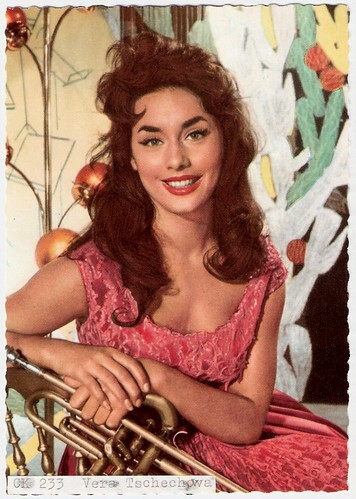
German postcard by Ufa (Universum-Film Aktiengesellschaft), Berlin-Tempelhof, no. CK-233. Retail price: 30 Pfg. Photo: Klaus Collignon / Ufa.
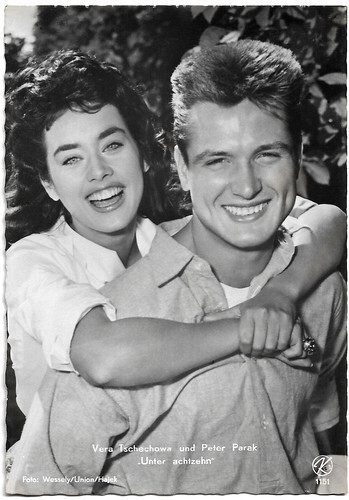
Austrian postcard by Kellner-Filmkarten, Wien., no 1151. Photo: Wessely / Union / Hajek. Vera Tschechowa and Peter Parak in Noch minderjährig/Unter 18/Under 18 (Georg Tressler, 1957).
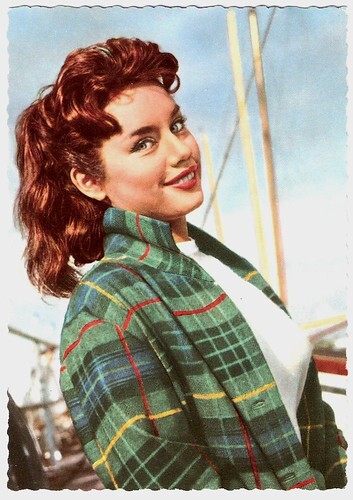
German postcard by Ufa (Universum-Film Aktiengesellschaft), Berlin-Tempelhof, no. CK-234. Retail price: 30 Pfg. Photo: Joe Niczky / Ufa.
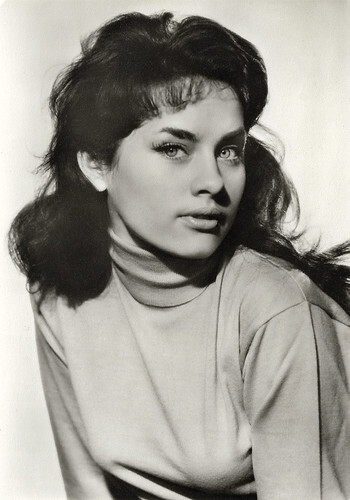
West German postcard by Universum-Film Aktiengesellschaft, Berlin-Tempelhof, WP no. 34. Photo: Arthur Grimm / Ufa.
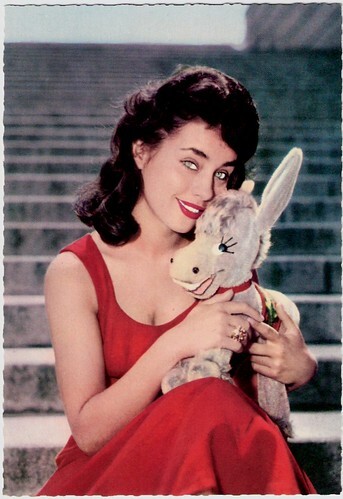
German postcard by ISV, no. H - 13.
Dating with Elvis
Vera Tschechowa - also written as Vera Cecova and Vera Tschechova - was bornVera Wilhelmowna Rust in Berlin, Germany in 1940. Her father was Dr. Wilhelm Rust, and her mother was actress and agent Ada Tschechowa. She later adopted her mother's maiden name.
Young Vera was brought up in Germany by her Russian-German grandmother Olga Tschechowa . Her early childhood was affected by the Second World War. During the late 1940s and early 1950s, she spent much time with her grandfather, Michael Chekhov in California, and she also travelled in the United States. She studied at the Berlin University of Arts to become a scenic designer, then she attended acting lessons at the Munich Drama School.
Eventually, she followed in the footsteps of her mother and grandmother and became an actress. Her film debut was as one of the daughters of Heinz Erhardt in the comedy Witwer mit funf Tochtern/Widower with 5 Daughters (Erich Engels, 1956). It was followed by a co-starring role in the drama Noch minderjährig/Under 18 (Georg Tressler, 1957) opposite Paula Wessely .
Soon followed roles in the war drama Der Arzt von Stalingrad/The Doctor of Stalingrad (Géza von Radványi, 1958) featuring O.E. Hasse , the romance Meine 99 Bräute/My 99 Brides (Alfred Vohrer, 1958) with Claus Wilcke , and the Italian fantasy Ballerina e Buon Dio/Angel in a Taxi (Antonio Leonviola, 1958) with Gabriele Ferzetti . The next year she appeared in the comedy Und das am Montagmorgen/And That on Monday Morning (Luigi Comencini, 1959) starring O.W. Fischer , and the Freddy Quinn musical Freddy unter fremden Sternen/Freddy under foreign stars(Wolfgang Schleif, 1959).
In 1959, when Elvis Presley was stationed as a soldier in Europe he dated Vera a few times. She was widely known as Elvis Presley's companion, particularly in connection with his Oral Poliomyelitis Vaccine (OPV) public booster-advocacy which they both undertook during Presley's first year in Germany with the U.S. Army. In 1959 she also made her stage debut at the Berlin Theater. Later she worked on stage at Deutsche Schauspielhaus Hamburg, and also at Dusseldorfer Schauspielhaus and Theater Basel.
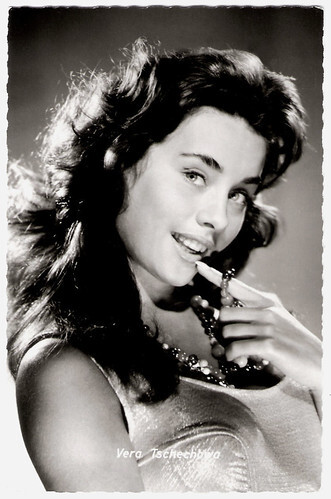
German postcard by Kolibri-Verlag G.m.b.H, Minden/Westf., no. 917. Photo: Weidenbaum.
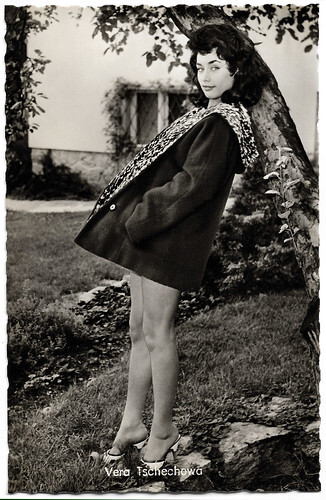
West German postcard by Kolibrti-Verlag G.m.b.H., Minden/Westf, no. 2757.
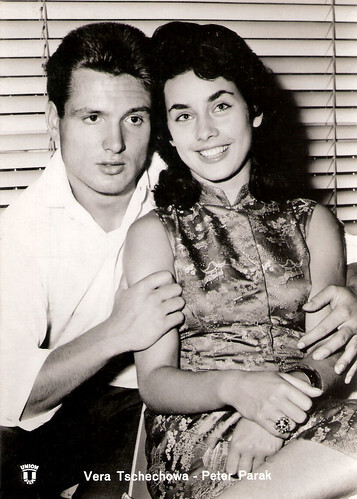
German postcard by IRMA-Verlag, Stuttgart W., no. 1321. Photo: Wessely / Union / Hajek. Publicity still for Noch minderjährig/Under 18 (Georg Tressler, 1957) with Peter Parak.
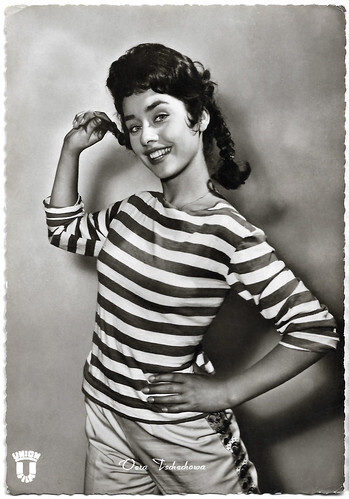
West German Irma postcard by Bartoschek-Verlag, Stuttgart-Bad Canstatt, no. 1450. Photo: Wessely / Union / Hajek.
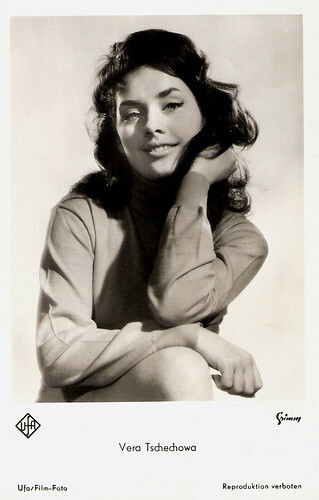
German postcard by Ufa, Berlin-Tempelhof, no. 4376. Retail price: 25 Pfg. Photo: Grimm / Ufa.
A formidable film career
In 1962 Vera Tschechowa received the Filmband in Gold, the German national film award, for her work in Das Brot der Fruhen Jahre/The Bread of Those Early Years (Herbert Vesely, 1962) with Christian Doermer . Since then she has been enjoying a formidable film career, including such diverse films as L'amour à vingt ans/Love at Twenty (François Truffaut a.o., 1962), the Edgar Wallace Krimi Die Gruft mit dem Rätselschloß/Curse of the Hidden Vault (Franz Josef Gottlieb, 1964), and the romance Liebe und so weiter/Love and So On (George Moorse, 1968), with Vadim Glowna, whom she had married in 1967.
On 6 June 1971, Vera appeared with 27 women under the banner 'We've had abortions!'('Wir haben abgetrieben!') on the cover page of the West German magazine Stern. In that issue, 374 women publicly stated that they had had pregnancies terminated, which at that time was illegal.
She made numerous appearances on television in several European countries. In 1977 she received the Goldene Camera Award for her role in the TV production Zeit der Empfindsamkeit/Age of Sensitivity (Wilma Kottusch, 1977). In 1980 she founded together with Glowna the film production company Atossa. The company produced Desperado City (Vadim Glowna, 1980), which won the 1981 Camera d'Or for Best Debut Film at the Cannes Film Festival. She was also directed by Glowna in Dies rigorose Leben/Nothing Left to Loose (Vadim Glowna, 1983) with Angela Molina, and in the documentary Tschechow in meinem Leben/Chekhov in My Life (Vadim Glowna, 1984) about the Chekhov dynasty. Petra Haffter cast her in her last role in front of the camera alongside Peter Sattmann in the television film Schuldig auf Verdacht/Guilty on Suspicion (Petra Haffter, 1996).
In the 1990s and 2000s, Vera Tschechowa became known as a writer/director/producer of film portraits. First, she worked for TV on portraits of the actors Klaus Maria Brandauer (1994), Anthony Quinn (1997), and Robert Redford . IMDb credits Der Filmemacher Ang Lee/Filmmaker Ang Lee (Vera Tschechowa, 2003) as her first film as a director. In 2006 she presented her film Salam Cinema: Die iranische Familie Makhmalbaf und ihre Filme/Salaam Cinema - Iran's Makhmalbaf Family and Their Films (Vera Tschechowa, 2006) at the Münchner Filmfest. Her last film was Michael Ballhaus - Eine Reise durch mein Leben/Michael Ballhaus - A Journey through My Life (Vera Tschechowa, 2008) about the famous German cinematographer.
After she divorced Vadim Glowna, Tschechowa married manager Peter Paschek, who produced her two latest documentaries. She had a son from a relationship with actor Hartmut Reck, film composer Nikolaus Glowna (1961). In 2022, Chekhova appeared as a contemporary witness in the docudrama Rex Gildo - Der letzte Tanz/Rex Gildo -The Last Dance by Rosa von Praunheim. Her autobiography 'Überwiegend heiter: Mein ziemlich bewegtes Leben' (Mostly Cheerful: My Rather Eventful Life) was published in 2022. Vera Tschechowa died in her hometown Berlin on 3 April 2024, at the age of 83.
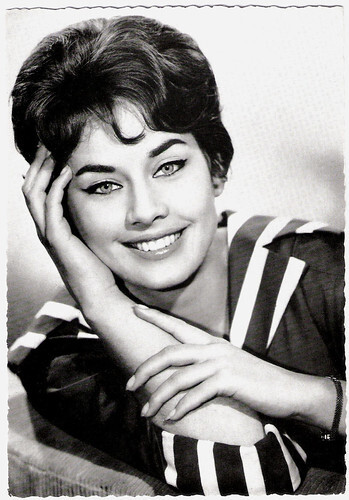
German postcard by WS-Druck, Wanne Eickel, no. 531. Photo: Bavaria / Astra.
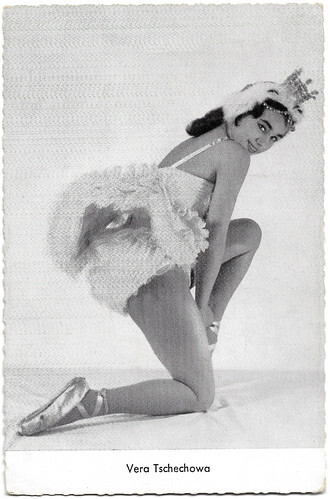
West German postcard by Kolibri-Verlag, Minden/Westf., no. D 95.
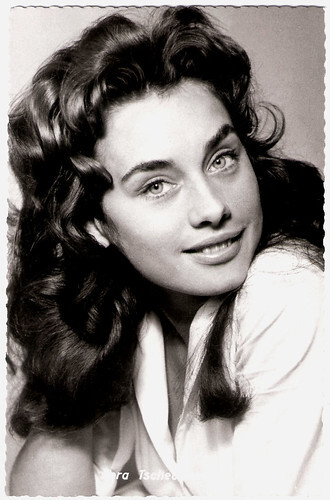
West German postcard by Kolibri-Verlag, Minden/Westf., no 339. Photo: Kolibri / Enzwieser.
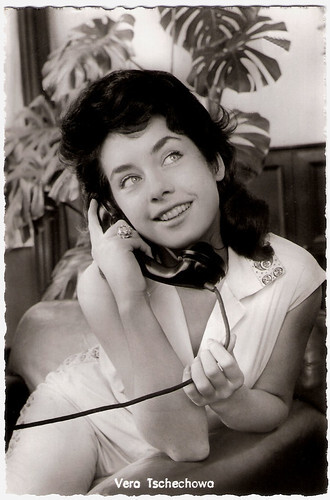
West German postcard by Kolibri-Verlag, Minden/Westf., no 2786.
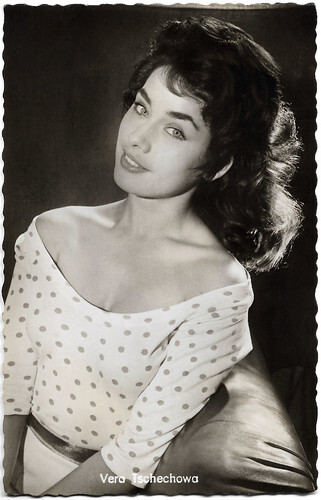
West German postcard by Kolibri-Verlag, Minden/Westf., no. 2850.
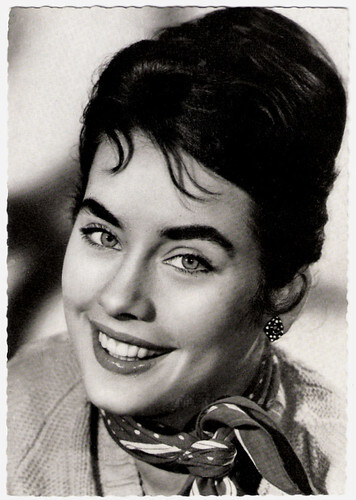
West German postcard by Filmbilder-Vertrieb Ernst Freihoff, Essen, no. 563. Photo: Karl Bayer.
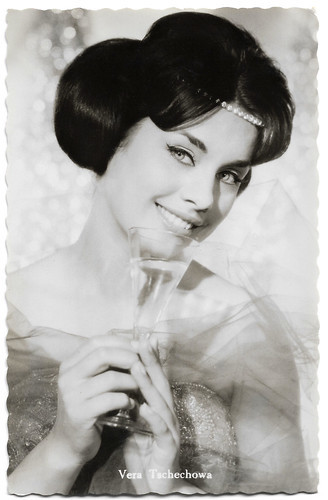
German postcard. Collection: Geoffrey Donaldson Institute.
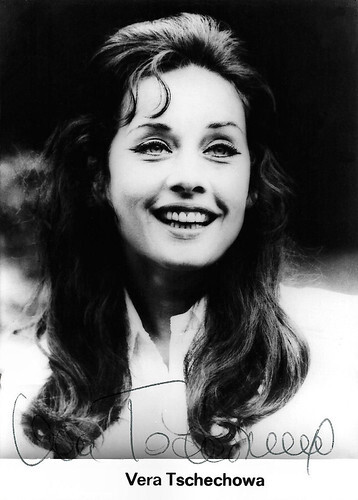
Vintage autograph card.
Sources: (IMDb), Wikipedia (English and German) and .

German postcard by Ufa (Universum-Film Aktiengesellschaft), Berlin-Tempelhof, no. CK-233. Retail price: 30 Pfg. Photo: Klaus Collignon / Ufa.

Austrian postcard by Kellner-Filmkarten, Wien., no 1151. Photo: Wessely / Union / Hajek. Vera Tschechowa and Peter Parak in Noch minderjährig/Unter 18/Under 18 (Georg Tressler, 1957).

German postcard by Ufa (Universum-Film Aktiengesellschaft), Berlin-Tempelhof, no. CK-234. Retail price: 30 Pfg. Photo: Joe Niczky / Ufa.

West German postcard by Universum-Film Aktiengesellschaft, Berlin-Tempelhof, WP no. 34. Photo: Arthur Grimm / Ufa.

German postcard by ISV, no. H - 13.
Dating with Elvis
Vera Tschechowa - also written as Vera Cecova and Vera Tschechova - was bornVera Wilhelmowna Rust in Berlin, Germany in 1940. Her father was Dr. Wilhelm Rust, and her mother was actress and agent Ada Tschechowa. She later adopted her mother's maiden name.
Young Vera was brought up in Germany by her Russian-German grandmother Olga Tschechowa . Her early childhood was affected by the Second World War. During the late 1940s and early 1950s, she spent much time with her grandfather, Michael Chekhov in California, and she also travelled in the United States. She studied at the Berlin University of Arts to become a scenic designer, then she attended acting lessons at the Munich Drama School.
Eventually, she followed in the footsteps of her mother and grandmother and became an actress. Her film debut was as one of the daughters of Heinz Erhardt in the comedy Witwer mit funf Tochtern/Widower with 5 Daughters (Erich Engels, 1956). It was followed by a co-starring role in the drama Noch minderjährig/Under 18 (Georg Tressler, 1957) opposite Paula Wessely .
Soon followed roles in the war drama Der Arzt von Stalingrad/The Doctor of Stalingrad (Géza von Radványi, 1958) featuring O.E. Hasse , the romance Meine 99 Bräute/My 99 Brides (Alfred Vohrer, 1958) with Claus Wilcke , and the Italian fantasy Ballerina e Buon Dio/Angel in a Taxi (Antonio Leonviola, 1958) with Gabriele Ferzetti . The next year she appeared in the comedy Und das am Montagmorgen/And That on Monday Morning (Luigi Comencini, 1959) starring O.W. Fischer , and the Freddy Quinn musical Freddy unter fremden Sternen/Freddy under foreign stars(Wolfgang Schleif, 1959).
In 1959, when Elvis Presley was stationed as a soldier in Europe he dated Vera a few times. She was widely known as Elvis Presley's companion, particularly in connection with his Oral Poliomyelitis Vaccine (OPV) public booster-advocacy which they both undertook during Presley's first year in Germany with the U.S. Army. In 1959 she also made her stage debut at the Berlin Theater. Later she worked on stage at Deutsche Schauspielhaus Hamburg, and also at Dusseldorfer Schauspielhaus and Theater Basel.

German postcard by Kolibri-Verlag G.m.b.H, Minden/Westf., no. 917. Photo: Weidenbaum.

West German postcard by Kolibrti-Verlag G.m.b.H., Minden/Westf, no. 2757.

German postcard by IRMA-Verlag, Stuttgart W., no. 1321. Photo: Wessely / Union / Hajek. Publicity still for Noch minderjährig/Under 18 (Georg Tressler, 1957) with Peter Parak.

West German Irma postcard by Bartoschek-Verlag, Stuttgart-Bad Canstatt, no. 1450. Photo: Wessely / Union / Hajek.

German postcard by Ufa, Berlin-Tempelhof, no. 4376. Retail price: 25 Pfg. Photo: Grimm / Ufa.
A formidable film career
In 1962 Vera Tschechowa received the Filmband in Gold, the German national film award, for her work in Das Brot der Fruhen Jahre/The Bread of Those Early Years (Herbert Vesely, 1962) with Christian Doermer . Since then she has been enjoying a formidable film career, including such diverse films as L'amour à vingt ans/Love at Twenty (François Truffaut a.o., 1962), the Edgar Wallace Krimi Die Gruft mit dem Rätselschloß/Curse of the Hidden Vault (Franz Josef Gottlieb, 1964), and the romance Liebe und so weiter/Love and So On (George Moorse, 1968), with Vadim Glowna, whom she had married in 1967.
On 6 June 1971, Vera appeared with 27 women under the banner 'We've had abortions!'('Wir haben abgetrieben!') on the cover page of the West German magazine Stern. In that issue, 374 women publicly stated that they had had pregnancies terminated, which at that time was illegal.
She made numerous appearances on television in several European countries. In 1977 she received the Goldene Camera Award for her role in the TV production Zeit der Empfindsamkeit/Age of Sensitivity (Wilma Kottusch, 1977). In 1980 she founded together with Glowna the film production company Atossa. The company produced Desperado City (Vadim Glowna, 1980), which won the 1981 Camera d'Or for Best Debut Film at the Cannes Film Festival. She was also directed by Glowna in Dies rigorose Leben/Nothing Left to Loose (Vadim Glowna, 1983) with Angela Molina, and in the documentary Tschechow in meinem Leben/Chekhov in My Life (Vadim Glowna, 1984) about the Chekhov dynasty. Petra Haffter cast her in her last role in front of the camera alongside Peter Sattmann in the television film Schuldig auf Verdacht/Guilty on Suspicion (Petra Haffter, 1996).
In the 1990s and 2000s, Vera Tschechowa became known as a writer/director/producer of film portraits. First, she worked for TV on portraits of the actors Klaus Maria Brandauer (1994), Anthony Quinn (1997), and Robert Redford . IMDb credits Der Filmemacher Ang Lee/Filmmaker Ang Lee (Vera Tschechowa, 2003) as her first film as a director. In 2006 she presented her film Salam Cinema: Die iranische Familie Makhmalbaf und ihre Filme/Salaam Cinema - Iran's Makhmalbaf Family and Their Films (Vera Tschechowa, 2006) at the Münchner Filmfest. Her last film was Michael Ballhaus - Eine Reise durch mein Leben/Michael Ballhaus - A Journey through My Life (Vera Tschechowa, 2008) about the famous German cinematographer.
After she divorced Vadim Glowna, Tschechowa married manager Peter Paschek, who produced her two latest documentaries. She had a son from a relationship with actor Hartmut Reck, film composer Nikolaus Glowna (1961). In 2022, Chekhova appeared as a contemporary witness in the docudrama Rex Gildo - Der letzte Tanz/Rex Gildo -The Last Dance by Rosa von Praunheim. Her autobiography 'Überwiegend heiter: Mein ziemlich bewegtes Leben' (Mostly Cheerful: My Rather Eventful Life) was published in 2022. Vera Tschechowa died in her hometown Berlin on 3 April 2024, at the age of 83.

German postcard by WS-Druck, Wanne Eickel, no. 531. Photo: Bavaria / Astra.

West German postcard by Kolibri-Verlag, Minden/Westf., no. D 95.

West German postcard by Kolibri-Verlag, Minden/Westf., no 339. Photo: Kolibri / Enzwieser.

West German postcard by Kolibri-Verlag, Minden/Westf., no 2786.

West German postcard by Kolibri-Verlag, Minden/Westf., no. 2850.

West German postcard by Filmbilder-Vertrieb Ernst Freihoff, Essen, no. 563. Photo: Karl Bayer.

German postcard. Collection: Geoffrey Donaldson Institute.

Vintage autograph card.
Sources: (IMDb), Wikipedia (English and German) and .
Published on April 06, 2024 22:00
April 5, 2024
Guest post Jean Ritsema: unnamed models on fashion cards
As the cataloger for the Image Archive on Mark Goffee’s Ross Verlag website, I regularly have cause to consult the European Film Star Postcards blog (EFSP) and the Flickr albums created by Paul van Yperen and Ivo Blom. Their postings and albums often have resolved hard-to-read elements on cards catalogued in the Ross Image Archive. Beyond their internet publications, however, both Paul and Ivo have been extraordinarily kind and helpful in sharing their extensive subject knowledge whenever I have presented a question to them. When Paul approached me to see if I would be interested in writing a guest posting for EFSP, I hesitated as I have limited knowledge of films and film stars.

Ally Kolberg. German postcard by Rotophot, no. 5929/2. Collection: Universität Osnabrück.
I came to the Ross Image Archive project, not through films, but through my collection of early 20th-century photographic fashion postcards, particularly those produced by companies such as the Ross-affiliated Rotophot. However, time and again when consulting the EFSP blog and Flickr albums, I saw a face that was familiar to me from my fashion card collection. I soon came to realize there was considerable overlap between stage and film performers and the unnamed models on fashion cards. Identifying the models on fashion cards became a fun challenge shared with several other collectors. In this guest posting, three identifications are highlighted. Others may be seen at the Ross Image Archive.
Ally Kolberg
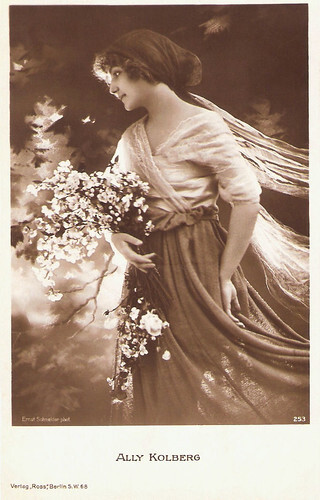
German postcard by Ross Verlag, Berlin, no. 253, 1919-1924. Photo: Ernst Schneider.
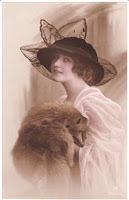 RPH, no. 4264/5.
RPH, no. 4264/5.
Collection:
University of Osnabrück.One of the most direct identifications is that of Ally Kolberg , the subject of an EFSP blog on 15 June 2015. The Ross Verlag 253 card included in that posting reproduced a photo of Kolberg by Ernst Schneider , clearly matching the photoshoot for Rotophot’s fashion series 5929.
In addition to performing in close to 20 silent films, Kolberg had an extensive modelling career, with her photo appearing on hundreds of fashion postcards and in numerous popular magazines such as Die Woche, Illustrirte Zeitung Leipzig and The Sketch.
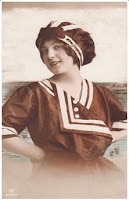 RPH, no. 4707/4.
RPH, no. 4707/4.
Collection:
University of Osnabrück.
One example is the Rotophot 4264 series, where a photo from the same shoot appears in a September 1913 issue of Illustrirte Zeitung Leipzig, titled, 'Herbstmoden' (Autumn Fashions).
Describing the hat, the article notes it "shows us a very beautiful way of using lace. Here . . . the lace surrounds the edge in slight curves and is folded out at the back to form a characteristic, wing-like loop." The article provides the name of the hat’s designer – Regina Friedlaender. It also gives the name of the photographer – Ernst Schneider .
A second example is the Rotophot 4707 series, featuring Kolberg in a swimming costume that is reproduced in a June 1914, Illustrirte Zeitung Leipzig fashion article titled 'Für Reise und Bad'. The costume is described as a "Swimsuit, sailor style, with a large flap and soft, wide sash made of black silk." The photo is credited to the studios of Ernst Schneider .
Geneviève Félix

French postcard by A Noyer, no. 3166. Collection: Werner Mohr.
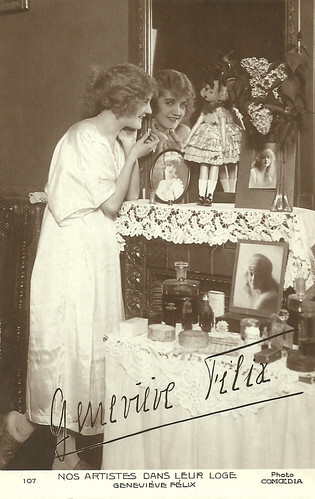
French postcard by Editions La Fayette in the Nos artistes dans leur loge series, no. 107. Photo Comoedia.
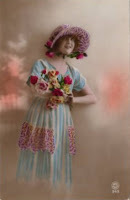 PC Paris, no. 343.
PC Paris, no. 343.
Collection:
Universität Osnabrück.A visual match from several name-captioned movie cards to uncaptioned fashion cards for the French actress and model, Geneviève Félix, also was made by Crystal Glantz.
An interesting supplement to this visual identification can be found in the EFSP 23 Nov 2015 posting which includes a postcard by Photo Comœdia, showing Félix in her dressing room. On the dressing table is a photo from the A. Noyer series 3166, posing Félix in a fashion shot.
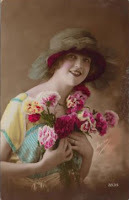 Irisa, no. 3535.
Irisa, no. 3535.
Collection:
Universität Osnabrück.
As the EFSP posting notes, Félix had a brief but successful career in the silent cinema, primarily in the 1920s.
Concurrent with her film career, Félix was a popular fashion and postcard model, appearing on scores of postcards without a name caption by French publishers such as A. Noyer, PC Paris and Irisa, and in fashion magazines such as l’Officiel de la Couture, de la Mode, Les Modes, and Vogue.
Félix’s postcards are often brightly and beautifully tinted, depicting Félix with a lovely smile.
Alice Hechy
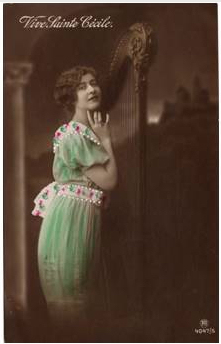
German postcard by Rotophot, no. 4047/5. Collection: Universität Osnabrück.
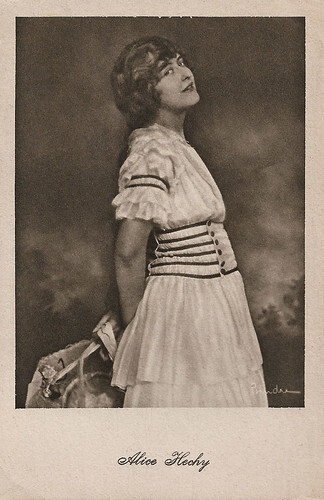
German postcard by Verlag Hermann Wolff, Berlin, no. P 53. Photo: Alex Binder, Berlin.
A final performer on film postcards whose image also appears with some frequency on uncaptioned fashion postcards is Alice Hechy.
While her identification is not as direct as that of Ally Kolberg’s, a distinct visual similarity can be seen between performer cards such as Hermann Wolff’s P53 (EFSP, 23 May 2023) and Rotophot’s fashion cards such as those in series 4047.
Several of Hechy’s fashion card series show her posed with interesting musical instruments. For example, the large instrument pictured on RPH 4128 is a theorbo which Wikipedia defines as "a plucked string instrument of the lute family, with an extended neck that houses the second pegbox.
Like a lute, a theorbo has a curved-back sound box with a flat top, typically with one or three sound holes decorated with rosettes. As with the lute, the player plucks or strums the strings with the right hand while ‘fretting’ (pressing down) the strings with the left hand."
Identification of the theorbo was provided by Prof. Dr. Dietrich Helms, Project Leader for the Archive Historical Picture Postcards – Universität Osnabrück. He adds: "The same instrument can be seen in full on another card of this series in the collection of Sabine Giesbrecht (our ID os_ub_0006871)."

German postcard by RPH, no. 4128/1. Collection: Universität Osnabrück.
Others
Many additional cards have been catalogued for Kolberg, Félix and Hechy on the Image Archive at the ROSS VERLAG MOVIE STAR POSTCARDS AND OTHER VINTAGE EUROPEAN POSTCARD PUBLISHERS website.
They can most easily be accessed by opening the Name branch of the selection tree at the left side of the Image Archive interface.
In addition to Kolberg, Félix and Hechy, scores of other film stars who have been the subject of a posting on the EFSP blog can be found in the Ross Image Archive, including several where the performer also was a model on postcards where the name captions do not appear. Among them are:

Blandine Ebinger . German postcard in the Rotophot Series, no. 54 2058.

Carola Toelle. German postcard by Paul Fink, Berlin, no. 261.

Elga Brink . German postcard by Rotophot, no. 6248/3.

Else Berna .German postcard by Rotophot, no. 1876/3.

Gladys Cooper. British postcard by Rotary, no. B.62-3.

Madge Lessing . British postcard by Rotophot, no. 2211/5.
Text and postcard selection: Jean Ritsema. Our special thanks to Prof. Dr. Dietrich Helms.

Ally Kolberg. German postcard by Rotophot, no. 5929/2. Collection: Universität Osnabrück.
I came to the Ross Image Archive project, not through films, but through my collection of early 20th-century photographic fashion postcards, particularly those produced by companies such as the Ross-affiliated Rotophot. However, time and again when consulting the EFSP blog and Flickr albums, I saw a face that was familiar to me from my fashion card collection. I soon came to realize there was considerable overlap between stage and film performers and the unnamed models on fashion cards. Identifying the models on fashion cards became a fun challenge shared with several other collectors. In this guest posting, three identifications are highlighted. Others may be seen at the Ross Image Archive.
Ally Kolberg

German postcard by Ross Verlag, Berlin, no. 253, 1919-1924. Photo: Ernst Schneider.
 RPH, no. 4264/5.
RPH, no. 4264/5. Collection:
University of Osnabrück.One of the most direct identifications is that of Ally Kolberg , the subject of an EFSP blog on 15 June 2015. The Ross Verlag 253 card included in that posting reproduced a photo of Kolberg by Ernst Schneider , clearly matching the photoshoot for Rotophot’s fashion series 5929.
In addition to performing in close to 20 silent films, Kolberg had an extensive modelling career, with her photo appearing on hundreds of fashion postcards and in numerous popular magazines such as Die Woche, Illustrirte Zeitung Leipzig and The Sketch.
 RPH, no. 4707/4.
RPH, no. 4707/4.Collection:
University of Osnabrück.
One example is the Rotophot 4264 series, where a photo from the same shoot appears in a September 1913 issue of Illustrirte Zeitung Leipzig, titled, 'Herbstmoden' (Autumn Fashions).
Describing the hat, the article notes it "shows us a very beautiful way of using lace. Here . . . the lace surrounds the edge in slight curves and is folded out at the back to form a characteristic, wing-like loop." The article provides the name of the hat’s designer – Regina Friedlaender. It also gives the name of the photographer – Ernst Schneider .
A second example is the Rotophot 4707 series, featuring Kolberg in a swimming costume that is reproduced in a June 1914, Illustrirte Zeitung Leipzig fashion article titled 'Für Reise und Bad'. The costume is described as a "Swimsuit, sailor style, with a large flap and soft, wide sash made of black silk." The photo is credited to the studios of Ernst Schneider .
Geneviève Félix

French postcard by A Noyer, no. 3166. Collection: Werner Mohr.

French postcard by Editions La Fayette in the Nos artistes dans leur loge series, no. 107. Photo Comoedia.
 PC Paris, no. 343.
PC Paris, no. 343.Collection:
Universität Osnabrück.A visual match from several name-captioned movie cards to uncaptioned fashion cards for the French actress and model, Geneviève Félix, also was made by Crystal Glantz.
An interesting supplement to this visual identification can be found in the EFSP 23 Nov 2015 posting which includes a postcard by Photo Comœdia, showing Félix in her dressing room. On the dressing table is a photo from the A. Noyer series 3166, posing Félix in a fashion shot.
 Irisa, no. 3535.
Irisa, no. 3535.Collection:
Universität Osnabrück.
As the EFSP posting notes, Félix had a brief but successful career in the silent cinema, primarily in the 1920s.
Concurrent with her film career, Félix was a popular fashion and postcard model, appearing on scores of postcards without a name caption by French publishers such as A. Noyer, PC Paris and Irisa, and in fashion magazines such as l’Officiel de la Couture, de la Mode, Les Modes, and Vogue.
Félix’s postcards are often brightly and beautifully tinted, depicting Félix with a lovely smile.
Alice Hechy

German postcard by Rotophot, no. 4047/5. Collection: Universität Osnabrück.

German postcard by Verlag Hermann Wolff, Berlin, no. P 53. Photo: Alex Binder, Berlin.
A final performer on film postcards whose image also appears with some frequency on uncaptioned fashion postcards is Alice Hechy.
While her identification is not as direct as that of Ally Kolberg’s, a distinct visual similarity can be seen between performer cards such as Hermann Wolff’s P53 (EFSP, 23 May 2023) and Rotophot’s fashion cards such as those in series 4047.
Several of Hechy’s fashion card series show her posed with interesting musical instruments. For example, the large instrument pictured on RPH 4128 is a theorbo which Wikipedia defines as "a plucked string instrument of the lute family, with an extended neck that houses the second pegbox.
Like a lute, a theorbo has a curved-back sound box with a flat top, typically with one or three sound holes decorated with rosettes. As with the lute, the player plucks or strums the strings with the right hand while ‘fretting’ (pressing down) the strings with the left hand."
Identification of the theorbo was provided by Prof. Dr. Dietrich Helms, Project Leader for the Archive Historical Picture Postcards – Universität Osnabrück. He adds: "The same instrument can be seen in full on another card of this series in the collection of Sabine Giesbrecht (our ID os_ub_0006871)."

German postcard by RPH, no. 4128/1. Collection: Universität Osnabrück.
Others
Many additional cards have been catalogued for Kolberg, Félix and Hechy on the Image Archive at the ROSS VERLAG MOVIE STAR POSTCARDS AND OTHER VINTAGE EUROPEAN POSTCARD PUBLISHERS website.
They can most easily be accessed by opening the Name branch of the selection tree at the left side of the Image Archive interface.
In addition to Kolberg, Félix and Hechy, scores of other film stars who have been the subject of a posting on the EFSP blog can be found in the Ross Image Archive, including several where the performer also was a model on postcards where the name captions do not appear. Among them are:

Blandine Ebinger . German postcard in the Rotophot Series, no. 54 2058.

Carola Toelle. German postcard by Paul Fink, Berlin, no. 261.

Elga Brink . German postcard by Rotophot, no. 6248/3.

Else Berna .German postcard by Rotophot, no. 1876/3.

Gladys Cooper. British postcard by Rotary, no. B.62-3.

Madge Lessing . British postcard by Rotophot, no. 2211/5.
Text and postcard selection: Jean Ritsema. Our special thanks to Prof. Dr. Dietrich Helms.
Published on April 05, 2024 22:00
April 4, 2024
Géza Tordy (1938-2024)
On 30 March 2024, Hungarian actor and director Géza Tordy (1938-2024) passed away in Budapest. The distinguished artist was the winner of the Kossuth Prize winner and the Jászai Mari Prize. He was 85.
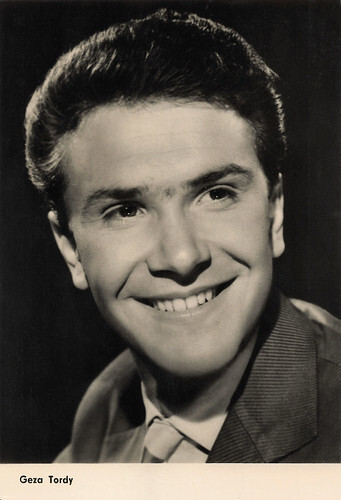
East German postcard by VEB Progress Film-Vertrieb, Berlin, no. 1688, 1962. Gezá Tordy in Füre lépni szabad/Free to enter (Károly Makk, 1960).
Suburban Legend
Géza Tordy was born in Budapest, Kingdom of Hungary, in 1938. Although he was admitted to the Academy of Dramatic Arts, no class was started in 1956, so Tordy did not graduate. He began his career in 1956 in Kaposvár, where Antal Németh worked as a director at the theatre. In 1957 she was signed for two years in Szeged, where she played alongside actors such as Endre Kátay and Edit Domján.
During those two years, he acted in the productions of Ida Versényi, István Komor and István Horvai. He also started to act in films. One of his first films was the Hungarian drama Külvárosi legenda/Suburban Legend (Félix Máriássy, 1957) starring Mari Törőcsik.
He had a supporting part in Sóbálvány/Pillar of Salt (Zoltán Várkonyi, 1958) starring Antal Páger, Anna Tõkés and Éva Ruttkai . Both films were shot at the Hunnia Studios in Budapest.
In 1959, he starred in two films that were presented at the Venice Film Festival 1959. The first was Akiket a pacsirta elkísér/For Whom the Larks Sing (László Ranódy, 1959) with Klári Tolnay , and the other was Álmatlan évek/Sleepless Years (Félix Máriássy, 1959) starring Éva Ruttkai . From 1959 he became a member of the Hungarian People's Army Theatre and the Vígszínház. Between 1963 and 1967, Géza Tordy was a member of the Madách Theatre company. In 1967 he returned to the Vígszínház.
In the cinema, he could be seen in small parts in international productions such as the West German-Italian historical war film Eine Handvoll Helden/A Handful of Heroes (Fritz Umgelter, 1967) starring Horst Frank . The next year, he appeared in the Hungarian-Bulgarian historical film Egri csillagok/Stars of Eger (Zoltán Várkonyi, 1968) starring Imre Sinkovits. He could also be seen in the Hungarian-Soviet epic Szerelmi álmok – Liszt/Dreams of Love – Liszt (1970), produced and directed by Márton Keleti. The film was based on the biography of the Hungarian composer and pianist Franz Liszt.
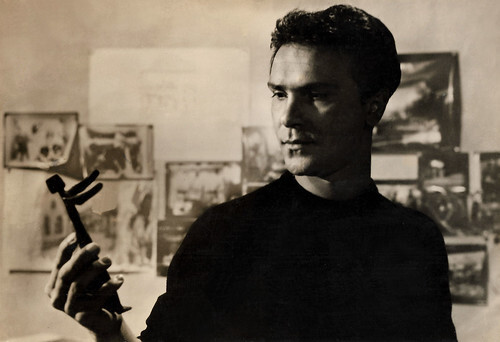
East German postcard by VEB Progress Film-Vertrieb, Berlin, no. 2691, 1966. Gezá Tordy in Ketten haltak meg/Two died (György Palásthy, 1966).
The Red Countess
In later years, Géza Tordy kept appearing in Hungarian films such as A vörös grófnő/The Red Countess (András Kovács, 1985), which was entered into the 14th Moscow International Film Festival.
In 2002, he played a major part as Ángel Sanz Briz, the ambassador of Spain in Hungary in the Italian drama Perlasca – Un eroe Italiano/Perlasca, an Italian Hero (Alberto Negrin, 2002). The film tells the story of Giorgio Perlasca (Luca Zingaretti), an Italian businessman working in Hungary for his government. After the surrender of Italy to the Allies, he took refuge in the Spanish embassy. Aware of the threat to Jews, he first began to help them find shelter in Spanish safe houses. After the Spanish ambassador moved to Switzerland, Perlasca posed as the Spanish consul, tricking Nazi officials and saving the lives of more than 5,000 Jews in Hungary in 1944 during the Holocaust.
From 1982 Tordy taught for several years at the University of Theatre and Film Arts. From 1985 to 1988, he was director and from 1988 to 1990 chief director of the Petőfi Theatre in Veszprém. From 1992 to 1995, he was artistic director of the Győr National Theatre. From 1995 to 2012, he was chief director of the Budapest Chamber Theatre.
Tordy was equally at home in romantic and modern heroic roles. In his performance, the inner tension of the characters, the direct emotional charge, and the sometimes wild passion of the emotions were well felt. In 1991 he was awarded the Kossuth Prize. In 2008 he was awarded the title of National Actor.
He made his final film appearance in the adventure film Hadik (János Szikora, 2023). During the Seven Years' War, Austrian Queen Maria Theresa sends her best general, András Hadik and his Hussars to raid Berlin and humiliate the Prussian King, Frederick the Great. Géza Tordy passed away in Budapest in 2024.
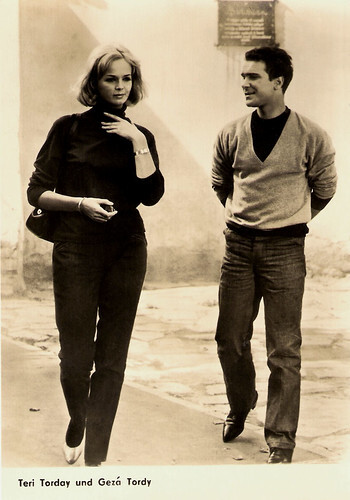
East-German postcard by VEB Progress Filmvertrieb, Berlin, no. 2692, 1966. Photo: Teri Tordai and Géza Tordy in Ketten haltak meg/Two died (György Palásthy, 1966).
Sources: Wikipedia (Hungarian and English) and .

East German postcard by VEB Progress Film-Vertrieb, Berlin, no. 1688, 1962. Gezá Tordy in Füre lépni szabad/Free to enter (Károly Makk, 1960).
Suburban Legend
Géza Tordy was born in Budapest, Kingdom of Hungary, in 1938. Although he was admitted to the Academy of Dramatic Arts, no class was started in 1956, so Tordy did not graduate. He began his career in 1956 in Kaposvár, where Antal Németh worked as a director at the theatre. In 1957 she was signed for two years in Szeged, where she played alongside actors such as Endre Kátay and Edit Domján.
During those two years, he acted in the productions of Ida Versényi, István Komor and István Horvai. He also started to act in films. One of his first films was the Hungarian drama Külvárosi legenda/Suburban Legend (Félix Máriássy, 1957) starring Mari Törőcsik.
He had a supporting part in Sóbálvány/Pillar of Salt (Zoltán Várkonyi, 1958) starring Antal Páger, Anna Tõkés and Éva Ruttkai . Both films were shot at the Hunnia Studios in Budapest.
In 1959, he starred in two films that were presented at the Venice Film Festival 1959. The first was Akiket a pacsirta elkísér/For Whom the Larks Sing (László Ranódy, 1959) with Klári Tolnay , and the other was Álmatlan évek/Sleepless Years (Félix Máriássy, 1959) starring Éva Ruttkai . From 1959 he became a member of the Hungarian People's Army Theatre and the Vígszínház. Between 1963 and 1967, Géza Tordy was a member of the Madách Theatre company. In 1967 he returned to the Vígszínház.
In the cinema, he could be seen in small parts in international productions such as the West German-Italian historical war film Eine Handvoll Helden/A Handful of Heroes (Fritz Umgelter, 1967) starring Horst Frank . The next year, he appeared in the Hungarian-Bulgarian historical film Egri csillagok/Stars of Eger (Zoltán Várkonyi, 1968) starring Imre Sinkovits. He could also be seen in the Hungarian-Soviet epic Szerelmi álmok – Liszt/Dreams of Love – Liszt (1970), produced and directed by Márton Keleti. The film was based on the biography of the Hungarian composer and pianist Franz Liszt.

East German postcard by VEB Progress Film-Vertrieb, Berlin, no. 2691, 1966. Gezá Tordy in Ketten haltak meg/Two died (György Palásthy, 1966).
The Red Countess
In later years, Géza Tordy kept appearing in Hungarian films such as A vörös grófnő/The Red Countess (András Kovács, 1985), which was entered into the 14th Moscow International Film Festival.
In 2002, he played a major part as Ángel Sanz Briz, the ambassador of Spain in Hungary in the Italian drama Perlasca – Un eroe Italiano/Perlasca, an Italian Hero (Alberto Negrin, 2002). The film tells the story of Giorgio Perlasca (Luca Zingaretti), an Italian businessman working in Hungary for his government. After the surrender of Italy to the Allies, he took refuge in the Spanish embassy. Aware of the threat to Jews, he first began to help them find shelter in Spanish safe houses. After the Spanish ambassador moved to Switzerland, Perlasca posed as the Spanish consul, tricking Nazi officials and saving the lives of more than 5,000 Jews in Hungary in 1944 during the Holocaust.
From 1982 Tordy taught for several years at the University of Theatre and Film Arts. From 1985 to 1988, he was director and from 1988 to 1990 chief director of the Petőfi Theatre in Veszprém. From 1992 to 1995, he was artistic director of the Győr National Theatre. From 1995 to 2012, he was chief director of the Budapest Chamber Theatre.
Tordy was equally at home in romantic and modern heroic roles. In his performance, the inner tension of the characters, the direct emotional charge, and the sometimes wild passion of the emotions were well felt. In 1991 he was awarded the Kossuth Prize. In 2008 he was awarded the title of National Actor.
He made his final film appearance in the adventure film Hadik (János Szikora, 2023). During the Seven Years' War, Austrian Queen Maria Theresa sends her best general, András Hadik and his Hussars to raid Berlin and humiliate the Prussian King, Frederick the Great. Géza Tordy passed away in Budapest in 2024.

East-German postcard by VEB Progress Filmvertrieb, Berlin, no. 2692, 1966. Photo: Teri Tordai and Géza Tordy in Ketten haltak meg/Two died (György Palásthy, 1966).
Sources: Wikipedia (Hungarian and English) and .
Published on April 04, 2024 22:00
April 3, 2024
Angel Heart (1987)
The Neo Noir Angel Heart ( 1987) is a standout film in British director Alan Parkers' filmography. It's a seedy, disturbing and provocative mystery starring Mickey Rourke in one of his best performances. Equally enjoyable are co-stars Robert De Niro, Charlotte Rampling and Lisa Bonet, fresh from The Cosby Show. Parker's script is based on the novel 'Falling Angel' by William Hjortsberg.
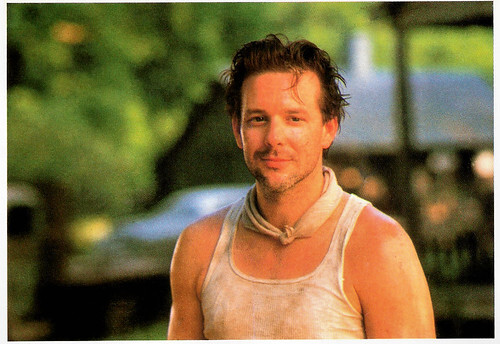
British postcard, no. FA 222. Photo: Mickey Rourke in Angel Heart (Alan Parker, 1987).
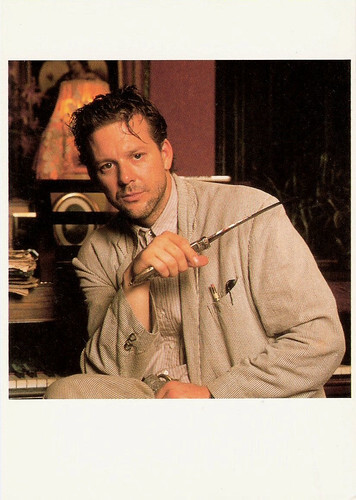
British postcard, no. FA 223. Mickey Rourke in Angel Heart (Alan Parker, 1987).
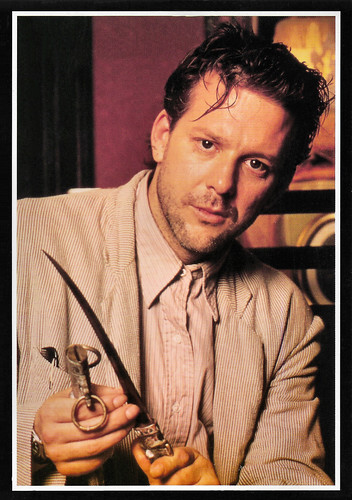
French postcard by Editions Damilla, Paris, no 94967. Photo: Mickey Rourke in Angel Heart (Alan Parker, 1987).
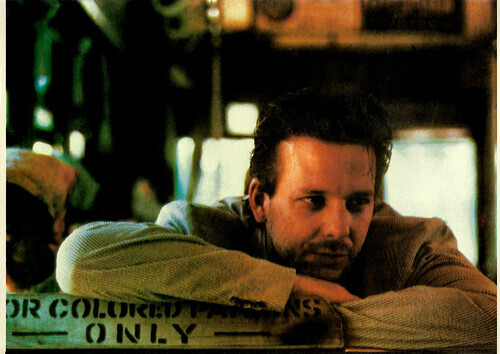
French postcard by Editions La Malibran, Paris, in the Collection Cinema Couleur, no MC 32, 1989. Photo: Mickey Rourke in Angel Heart (Alan Parker, 1987).
Locating a mysterious crooner named Johnny Favourite
In Angel Heart (1987), Mickey Rourke plays Harry Angel, an unshaven, chain-smoking private detective in Brooklyn in 1955. Harry is hired by sinister Mr. Louis Cyphre ( Robert De Niro ) to locate a mysterious crooner named Johnny Favourite.
The singer disappeared in the early 1940s and hasn't been seen since. The money is good and the job doesn't seem that risky, so Harry accepts.
His search leads Harry from the streets of New York to jazz clubs in Harlem and, finally, to the sweltering swamps of Louisiana. He meets a variety of characters, all of whom have little to say about Favourite. The singer entered the war, was shot and had his face reconstructed. After leaving the hospital, he vanished from the face of the earth.
Everybody finds a violent death after Harry talks to them. He is a lot more involved than he initially thought and his search moves inexorably towards a devastating conclusion.
The Motion Picture Association of America (MPAA) gave the original cut of Angel Heart an X rating, because of a sex scene involving Mickey Rourke and Lisa Bonet in which Rourke's buttocks are seen thrusting in a sexual motion. The film's distributor Tri-Star Pictures refused to release it with an X rating, and Parker then removed ten seconds from the scene and the film was granted an R rating.
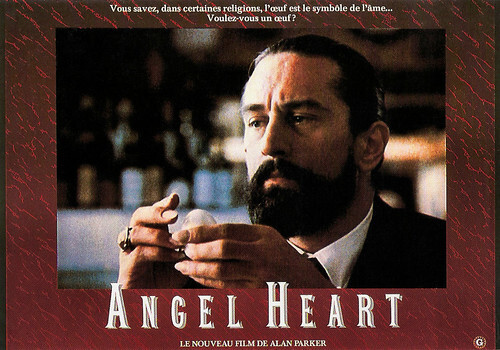
French postcard by Humour à la Carte, Paris, no. A-C 1259. Photo: Gaumont. Robert De Niro in Angel Heart (Alan Parker, 1987). Caption: You know, in certain religions, the egg is the symbol of a soul... Would you like an egg?
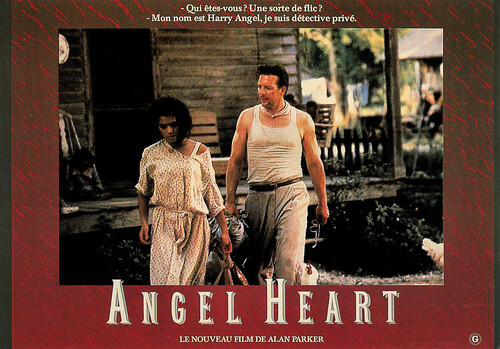
French postcard by Humour à la Carte, Paris, no. A-C 1260. Photo: Gaumont. Mickey Rourke and Lisa Bonet in Angel Heart (Alan Parker, 1987). Caption: - What are you? Some kind of cop? - My name is Harry Angel, I am a Private detective.
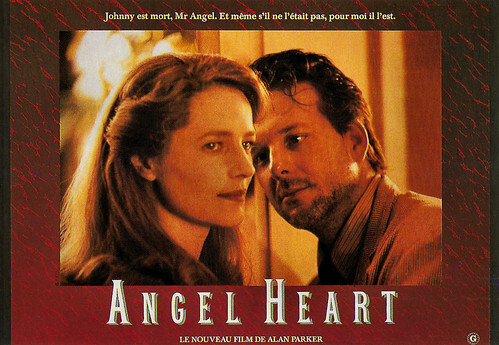
French postcard by Humour à la Carte, Paris, no. A-C 1261. Photo: Gaumont. Charlotte Rampling and Mickey Rourke in Angel Heart (Alan Parker, 1987). Cation: Johnny is dead, Mr. Angel. And even if he's not, he is for me.
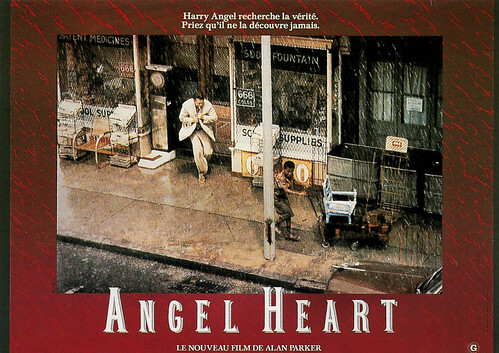
French postcard by Humour à la Carte, Paris, no. A-C 1262. Photo: Gaumont. Mickey Rourke in Angel Heart (Alan Parker, 1987). Caption: Harry Angel is looking for the truth. Pray he never finds out.
An exuberant exercise in style
When released in 1987, Angel Heart received a mixed reaction from reviewers, who criticised Alan Parker's screenwriting but praised the production design, the score by Trevor Jones, and the cinematography by Michael Seresin, as well as the performances of Mickey Rourke and Lisa Bonet.
Derek Armstrong at AllMovie : "At the brief height of his career, Rourke radiates the mounting hysteria of a man caught in purgatory, surrounded and eventually engulfed by sadistic evil. By the time he pieces together the mystery, the audience has walked in his shoes enough to absorb his emotional outpouring."
Angel Heart underperformed at the North American box office, grossing $17.2 million during its theatrical run against a production budget of $18 million. In the following decades, the film got a strong cult following and is now regarded as influential and underappreciated.
Angel Heart is slowly paced but laced with moments of action and violence that breathe life into it. The smoke-filled rooms, the clothes and the music bring the viewer back to 1955. Alan Parker (Midnight Express, Mississippi Burning) made a beautifully shot, and masterfully edited film. His attention to detail and the moody atmosphere make it a visual masterpiece.
Critic Roger Ebert: "The movie's final revelations make a weird sense, once we figure them out. This is one of those movies where you leave the theatre and re-run the plot in your head, re-interpreting the early scenes in terms of the final shocking revelations. Angel Heart is a thriller and a horror movie, but most of all it's an exuberant exercise in style, in which Parker and his actors have fun taking it to the limit."
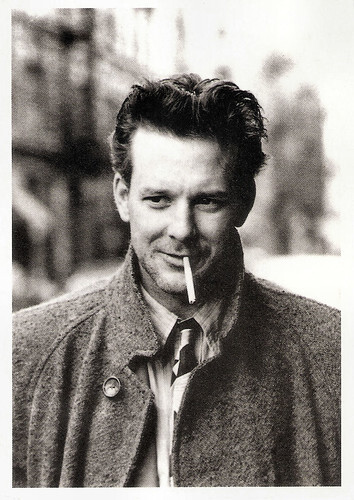
French postcard by Humour a la Carte, Paris, no. ST-186. Photo: TriStar Pictures. Mickey Rourke in Angel Heart (Alan Parker, 1987).
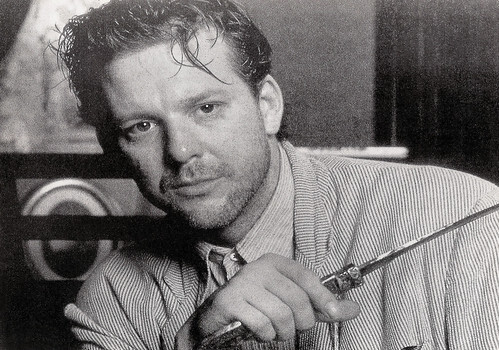
British postcard by Moviedrome, no. M1. Mickey Rourke in Angel Heart (Alan Parker, 1987).
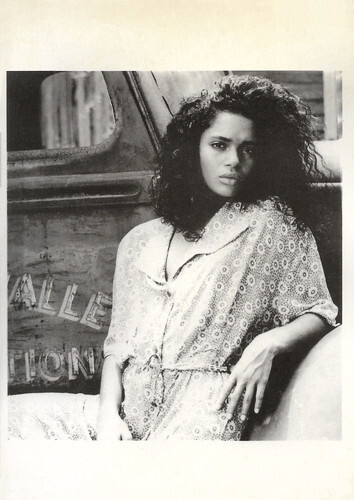
Canadian postcard by Canadian Postcard, no. A-136. Lisa Bonet in Angel Heart (Alan Parker, 1987).
Sources: Derek Armstrong (AllMovie), Roger Ebert (RogerEbert.com), Wikipedia and IMDb.

British postcard, no. FA 222. Photo: Mickey Rourke in Angel Heart (Alan Parker, 1987).

British postcard, no. FA 223. Mickey Rourke in Angel Heart (Alan Parker, 1987).

French postcard by Editions Damilla, Paris, no 94967. Photo: Mickey Rourke in Angel Heart (Alan Parker, 1987).

French postcard by Editions La Malibran, Paris, in the Collection Cinema Couleur, no MC 32, 1989. Photo: Mickey Rourke in Angel Heart (Alan Parker, 1987).
Locating a mysterious crooner named Johnny Favourite
In Angel Heart (1987), Mickey Rourke plays Harry Angel, an unshaven, chain-smoking private detective in Brooklyn in 1955. Harry is hired by sinister Mr. Louis Cyphre ( Robert De Niro ) to locate a mysterious crooner named Johnny Favourite.
The singer disappeared in the early 1940s and hasn't been seen since. The money is good and the job doesn't seem that risky, so Harry accepts.
His search leads Harry from the streets of New York to jazz clubs in Harlem and, finally, to the sweltering swamps of Louisiana. He meets a variety of characters, all of whom have little to say about Favourite. The singer entered the war, was shot and had his face reconstructed. After leaving the hospital, he vanished from the face of the earth.
Everybody finds a violent death after Harry talks to them. He is a lot more involved than he initially thought and his search moves inexorably towards a devastating conclusion.
The Motion Picture Association of America (MPAA) gave the original cut of Angel Heart an X rating, because of a sex scene involving Mickey Rourke and Lisa Bonet in which Rourke's buttocks are seen thrusting in a sexual motion. The film's distributor Tri-Star Pictures refused to release it with an X rating, and Parker then removed ten seconds from the scene and the film was granted an R rating.

French postcard by Humour à la Carte, Paris, no. A-C 1259. Photo: Gaumont. Robert De Niro in Angel Heart (Alan Parker, 1987). Caption: You know, in certain religions, the egg is the symbol of a soul... Would you like an egg?

French postcard by Humour à la Carte, Paris, no. A-C 1260. Photo: Gaumont. Mickey Rourke and Lisa Bonet in Angel Heart (Alan Parker, 1987). Caption: - What are you? Some kind of cop? - My name is Harry Angel, I am a Private detective.

French postcard by Humour à la Carte, Paris, no. A-C 1261. Photo: Gaumont. Charlotte Rampling and Mickey Rourke in Angel Heart (Alan Parker, 1987). Cation: Johnny is dead, Mr. Angel. And even if he's not, he is for me.

French postcard by Humour à la Carte, Paris, no. A-C 1262. Photo: Gaumont. Mickey Rourke in Angel Heart (Alan Parker, 1987). Caption: Harry Angel is looking for the truth. Pray he never finds out.
An exuberant exercise in style
When released in 1987, Angel Heart received a mixed reaction from reviewers, who criticised Alan Parker's screenwriting but praised the production design, the score by Trevor Jones, and the cinematography by Michael Seresin, as well as the performances of Mickey Rourke and Lisa Bonet.
Derek Armstrong at AllMovie : "At the brief height of his career, Rourke radiates the mounting hysteria of a man caught in purgatory, surrounded and eventually engulfed by sadistic evil. By the time he pieces together the mystery, the audience has walked in his shoes enough to absorb his emotional outpouring."
Angel Heart underperformed at the North American box office, grossing $17.2 million during its theatrical run against a production budget of $18 million. In the following decades, the film got a strong cult following and is now regarded as influential and underappreciated.
Angel Heart is slowly paced but laced with moments of action and violence that breathe life into it. The smoke-filled rooms, the clothes and the music bring the viewer back to 1955. Alan Parker (Midnight Express, Mississippi Burning) made a beautifully shot, and masterfully edited film. His attention to detail and the moody atmosphere make it a visual masterpiece.
Critic Roger Ebert: "The movie's final revelations make a weird sense, once we figure them out. This is one of those movies where you leave the theatre and re-run the plot in your head, re-interpreting the early scenes in terms of the final shocking revelations. Angel Heart is a thriller and a horror movie, but most of all it's an exuberant exercise in style, in which Parker and his actors have fun taking it to the limit."

French postcard by Humour a la Carte, Paris, no. ST-186. Photo: TriStar Pictures. Mickey Rourke in Angel Heart (Alan Parker, 1987).

British postcard by Moviedrome, no. M1. Mickey Rourke in Angel Heart (Alan Parker, 1987).

Canadian postcard by Canadian Postcard, no. A-136. Lisa Bonet in Angel Heart (Alan Parker, 1987).
Sources: Derek Armstrong (AllMovie), Roger Ebert (RogerEbert.com), Wikipedia and IMDb.
Published on April 03, 2024 22:00
April 2, 2024
William Duncan
Scottish-born film star William Duncan (1879–1961) was a major actor, writer, and director of films and serials, often Westerns. He became one of the highest-paid leading men in the early film industry. When under contract at Vitagraph, he earned more than $1 million per year. 'Hollywood's first Scottish movie star' worked with the major studios of the day including the Selig Polyscope Company and Vitagraph. His career spanned the change to sound film, and he acted from 1911 to 1940. Sadly, many of his films did not survive.
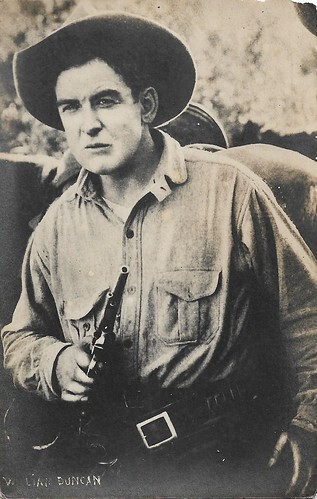
Vintage postcard.
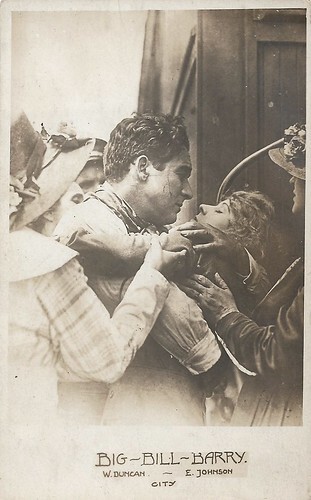
Hungarian postcard by City. Photo: William Duncan and Edith Johnson in Big Bill Barry. While this title is lacking in IMDb, the Hungarian press advertised for this film in 1921.
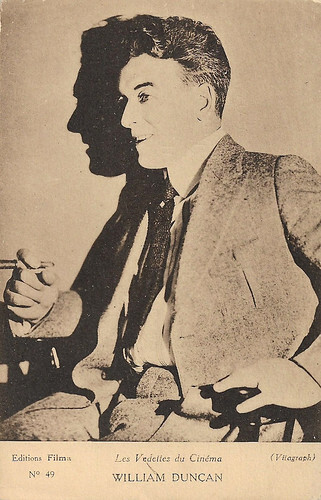
French postcard in the Les Vedettes du Cinéma series by Editions Filma, no. 49. Photo: Vitagraph.
Wrestler and bodybuilder
William Duncan was born in the Lochee area of Dundee, Scotland in 1879. As a child, he immigrated to the United States with his family in 1890. They settled in Philadelphia. He attended public school, where he started to play American football. He enrolled at the University of Pennsylvania, where he played football and participated in track, but left after two years of study.
He was a wrestler and worked as a physical instructor at the McFadden Physical Culture Health Home. He also wrote for a magazine about physical culture, operated a gymnasium in Philadelphia and was a professional wrestler. Later he operated a bodybuilding academy. In 1906, Duncan debuted in Vaudeville as part of a strongman act. Next, he acted in stock theatre companies in Philadelphia, Memphis, and Rochester.
In 1909, Duncan started to appear in films at the Selig Polyscope Company. His debut was Love and Law (1909), a Selig short by Marshall Stedman. Between 1909 and 1913, Duncan acted in some thirty shorts at Selig, often Westerns. His many credits include Told in Colorado (Joseph A. Golden, 1911) and The Count of Monte Cristo (Colin Campbell, 1912), starring Hobart Bosworth as Edmond Dantes and Tom Santschi as Danglars. When this film was made Adolph Zukor had secured the rights to the 1844 novel by Alexandre Dumas Père and was about to release his 1913 version with James O'Neill who had made the role famous on stage. Zukor's attorneys ordered this film destroyed and all prints were withdrawn.
In 1914, he moved over to Vitagraph, where he continued acting in shorts. His Vitagraph contract was worth $1,000,000 a year. He was better paid than Mary Pickford and Douglas Fairbanks . From 1916, he also played for Vitagraph in features.
Probably his first feature film was God's Country and the Woman (Rollin S. Sturgeon, 1916). It was a James Oliver Curwood adaptation with Nell Shipman as the female lead. His later films include Man of Might (William Duncan, Clifford Smith, 1919), Playing It Wild (William Duncan, 1922), The Steel Trail (William Duncan, 1923) and The Fast Express (William Duncan, 1924), all with Edith Johnson as his co-star.
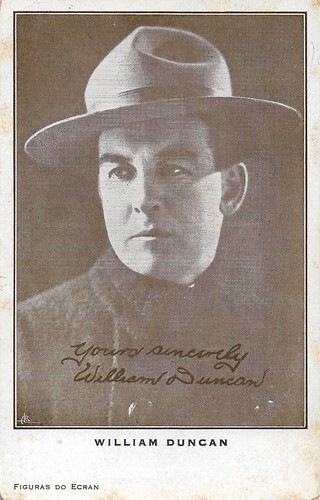
Portuguese postcard by Figuras do Ecran. Photo: AB.
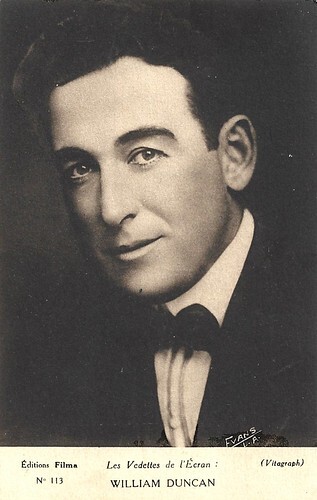
French postcard in the Les vedettes de l'Ecran series by Editions Filma, no. 113. Photo: Evans, L.A. / Vitagraph, 1919.
Earning more than $1 million per year
From 1911 to 1924, William Duncan also directed some 88 films at Selig and Vitagraph. He directed Tom Mix in the short silent Western The Telltale Knife (William Duncan, 1914) also starring Myrtle Stedman and Duncan himself. At Selig, he also wrote almost 50 scripts.
In 1915-1916, there was a gap in his film direction, but from 1917, he continued directing at Vitagraph as well, where his first assignment was The Fighting Trail (William Duncan, 1917), a Western film series with 15 chapters.
Duncan followed the film industry to California. By now, he was directing feature-length films. Wolves of the North (William Duncan, 1924), about the adventures of fur trappers in the Pacific Northwest, was the last of his film directions.
In 1925, after having acted in some 160 films, he withdrew from the screen. But in 1935 he returned as the character Buck Peters, owner of the Bar 20 Ranch, in the Hopalong Cassidy Western series, starring William Boyd and distributed by Paramount. His last film part was in Texas Rangers Ride Again (James Hogan, 1940) starring Ellen Drew and John Howard.
Duncan married twice. In 1921, he married his second wife, silent film actress Edith Johnson , with whom he had often costarred in many of his Vitagraph productions. The couple were married until Duncan died in Hollywood, California, in 1961. He was 81. The couple had two sons and one daughter together. William Duncan was interred at Inglewood Park Cemetery, Inglewood, California, USA.
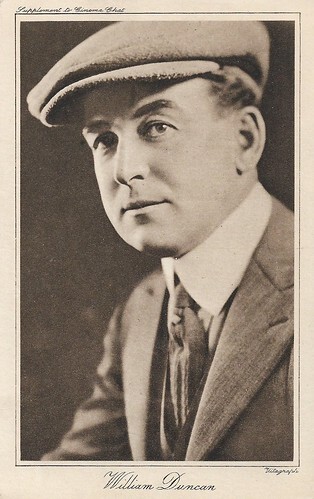
British postcard by Cinema Chat. Photo: Vitagraph.
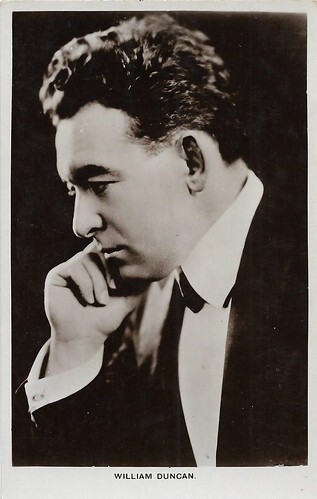
British postcard in the Picturegoer Series, London.
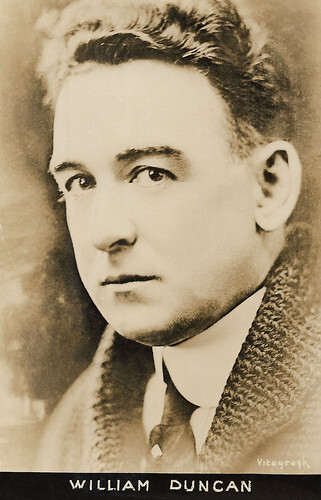
Vintage Real Photograph postcard by PRC. Photo: Vitagraph.
Sources: John "J-Cat" Griffith (Find A Grave), Wikipedia and .

Vintage postcard.

Hungarian postcard by City. Photo: William Duncan and Edith Johnson in Big Bill Barry. While this title is lacking in IMDb, the Hungarian press advertised for this film in 1921.

French postcard in the Les Vedettes du Cinéma series by Editions Filma, no. 49. Photo: Vitagraph.
Wrestler and bodybuilder
William Duncan was born in the Lochee area of Dundee, Scotland in 1879. As a child, he immigrated to the United States with his family in 1890. They settled in Philadelphia. He attended public school, where he started to play American football. He enrolled at the University of Pennsylvania, where he played football and participated in track, but left after two years of study.
He was a wrestler and worked as a physical instructor at the McFadden Physical Culture Health Home. He also wrote for a magazine about physical culture, operated a gymnasium in Philadelphia and was a professional wrestler. Later he operated a bodybuilding academy. In 1906, Duncan debuted in Vaudeville as part of a strongman act. Next, he acted in stock theatre companies in Philadelphia, Memphis, and Rochester.
In 1909, Duncan started to appear in films at the Selig Polyscope Company. His debut was Love and Law (1909), a Selig short by Marshall Stedman. Between 1909 and 1913, Duncan acted in some thirty shorts at Selig, often Westerns. His many credits include Told in Colorado (Joseph A. Golden, 1911) and The Count of Monte Cristo (Colin Campbell, 1912), starring Hobart Bosworth as Edmond Dantes and Tom Santschi as Danglars. When this film was made Adolph Zukor had secured the rights to the 1844 novel by Alexandre Dumas Père and was about to release his 1913 version with James O'Neill who had made the role famous on stage. Zukor's attorneys ordered this film destroyed and all prints were withdrawn.
In 1914, he moved over to Vitagraph, where he continued acting in shorts. His Vitagraph contract was worth $1,000,000 a year. He was better paid than Mary Pickford and Douglas Fairbanks . From 1916, he also played for Vitagraph in features.
Probably his first feature film was God's Country and the Woman (Rollin S. Sturgeon, 1916). It was a James Oliver Curwood adaptation with Nell Shipman as the female lead. His later films include Man of Might (William Duncan, Clifford Smith, 1919), Playing It Wild (William Duncan, 1922), The Steel Trail (William Duncan, 1923) and The Fast Express (William Duncan, 1924), all with Edith Johnson as his co-star.

Portuguese postcard by Figuras do Ecran. Photo: AB.

French postcard in the Les vedettes de l'Ecran series by Editions Filma, no. 113. Photo: Evans, L.A. / Vitagraph, 1919.
Earning more than $1 million per year
From 1911 to 1924, William Duncan also directed some 88 films at Selig and Vitagraph. He directed Tom Mix in the short silent Western The Telltale Knife (William Duncan, 1914) also starring Myrtle Stedman and Duncan himself. At Selig, he also wrote almost 50 scripts.
In 1915-1916, there was a gap in his film direction, but from 1917, he continued directing at Vitagraph as well, where his first assignment was The Fighting Trail (William Duncan, 1917), a Western film series with 15 chapters.
Duncan followed the film industry to California. By now, he was directing feature-length films. Wolves of the North (William Duncan, 1924), about the adventures of fur trappers in the Pacific Northwest, was the last of his film directions.
In 1925, after having acted in some 160 films, he withdrew from the screen. But in 1935 he returned as the character Buck Peters, owner of the Bar 20 Ranch, in the Hopalong Cassidy Western series, starring William Boyd and distributed by Paramount. His last film part was in Texas Rangers Ride Again (James Hogan, 1940) starring Ellen Drew and John Howard.
Duncan married twice. In 1921, he married his second wife, silent film actress Edith Johnson , with whom he had often costarred in many of his Vitagraph productions. The couple were married until Duncan died in Hollywood, California, in 1961. He was 81. The couple had two sons and one daughter together. William Duncan was interred at Inglewood Park Cemetery, Inglewood, California, USA.

British postcard by Cinema Chat. Photo: Vitagraph.

British postcard in the Picturegoer Series, London.

Vintage Real Photograph postcard by PRC. Photo: Vitagraph.
Sources: John "J-Cat" Griffith (Find A Grave), Wikipedia and .
Published on April 02, 2024 22:00
April 1, 2024
Barbara Rush (1927-2024)
American actress Barbara Rush (1927-2024) died last Sunday, 31 March 2024, at 97. The beautiful brunette actress was the epitome of poise, charm, style, and grace in Hollywood films of the 1950s. In 1954, she won the Golden Globe Award as Most Promising Female Newcomer for the Science-Fiction film It Came from Outer Space (1953). She played the female lead in such films as The Young Philadelphians (1959), The Young Lions (1958), and Hombre (1967). Later in her career, Rush guest-starred on TV in such series as Peyton Place, All My Children and 7th Heaven.
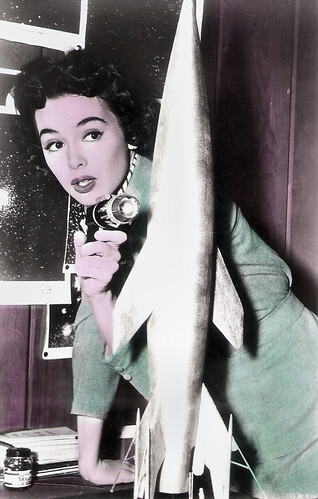
Yugoslavian postcard by Studio Sombor, sent by mail in 1961. Barbara Rush in It Came from Outer Space (Jack Arnold, 1953).
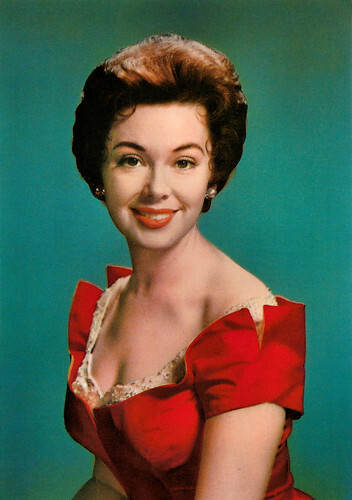
Italian postcard by Rotalfoto. Milano, no. N. 120.
Brittle wives, conniving 'other women' or socialite girlfriend types
Barbara Rush was born in Denver, Colorado in 1927. She was the daughter of Roy Rush, a lawyer for a Midwest mining company, and Marguerite Rush. Barbara grew up in Santa Barbara, California, and enrolled at the University of California where she graduated in 1948.
She then worked with the University Players and took acting classes at the Pasadena Playhouse. Soon talent scouts spotted her and, following a play performance, Paramount quickly signed her up in 1950. She made her film debut with The Goldbergs (Walter Hart, 1950).
Just before this, she had met fellow actor Jeffrey Hunter , an incredibly handsome newcomer who later became a 'beefcake' Bobbysoxer idol at Fox. The two fell in love quickly and married in December of 1950. Soon, they were on their way to becoming one of Hollywood's most beautiful and photogenic young couples. Their son Christopher was born in 1952.
While at Paramount, she was decorative in such assembly-line fare as the classic George Pal Sci-Fi film When Worlds Collide (Rudolph Maté, 1951), Quebec (George Templeton, 1951) opposite John Drew Barrymore, and the Western Flaming Feather (Ray Enright, 1952) starring Sterling Hayden. In 1953 she played the female lead in another Sci-Fi classic, It Came from Outer Space (Jack Arnold, 1953) for which she won a Golden Globe for 'Most Promising Newcomer – Female'.
Rush starred as the wife of James Mason in the acclaimed drama Bigger Than Life (Nicholas Ray, 1956), in which a school teacher's use of an experimental drug results in his threatening harm to his family. She was the love interest of reluctant soldier Dean Martin in the epic World War II drama The Young Lions (Edward Dmytryk, 1958) and of ambitious lawyer Paul Newman in The Young Philadelphians (Vincent Sherman, 1959). She also co-starred opposite Richard Burton , and Kirk Douglas . Gary Brumburgh at IMDb : "In most cases, she played brittle wives, conniving 'other women' or socialite girlfriend types. Despite the 'A' list movies, Barbara was piling up, the one single role that could put her over the top never showed its face."
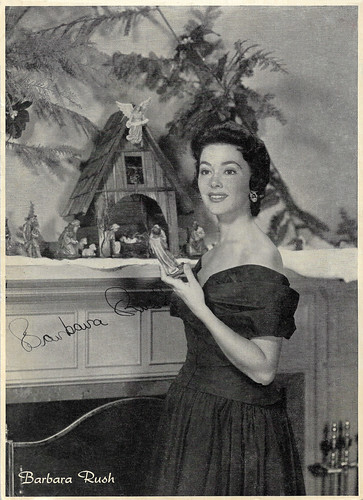
Big autograph card.
A Woman of Independent Means
By the early 1960s, Barbara Rush's film career started to decline. She married publicist Warren Cowan in 1959 and bore a second child, Claudia Cowan, in 1964. That year, she played a villainess in the Rat Pack's gangster musical Robin and the 7 Hoods (Gordon Douglas, 1964). In the Western drama Hombre (Martin Ritt, 1967) starring Paul Newman , she played a rich, younger, condescending wife of a thief - and ends up taken hostage and tied to a stake.
TV became a viable source of income for Barbara, appearing in scores of guest parts on the more popular shows of the time while co-starring in standard mini-movie dramas. In 1965, she appeared in a two-part episode of The Fugitive titled 'Landscape with Running Figures' as Marie Gérard, wife of police detective Lt. Philip Gérard. She had fun playing a 'guest villainess' in the Batman (1966) series as temptress Nora Clavicle.
The stage also became a strong focus for Barbara. In 1970, she earned the Sarah Siddons Award for 'Forty Carats'. In 1984, she made her Broadway debut in the one-woman showcase 'A Woman of Independent Means', which earned her the Los Angeles Drama Critics Award during its tour.
Other showcases included 'Private Lives', (1973) 'Same Time, Next Year', (1976-1978) 'The Night of the Iguana' (1978), 'Steel Magnolias' (1988-1989), and Vagina Monologues (1995-1997). Among her later film appearances were parts in the disco-themed Can't Stop the Music (Nancy Walker, 1980) with The Village People, and the romantic comedy Summer Lovers (Randal Kleiser, 1982), starring Daryl Hannah .
The still-beautiful Barbara Rush occasionally graced the big and small screen in the later decades, including in a recurring role on TV's 7th Heaven (1997-2007). She died at a care home in Westlake Village, California, in 2024, at the age of 97. Rush married and divorced three times. Her husbands were Jeffrey Hunter (1950-1955), Warren Cowan (1959-1969), and actor Jim Gruzalski (1970-1973). She was the mother of Christopher Hunter and Fox News correspondent Claudia Cowan and aunt of actress Carolyn Hennesy.
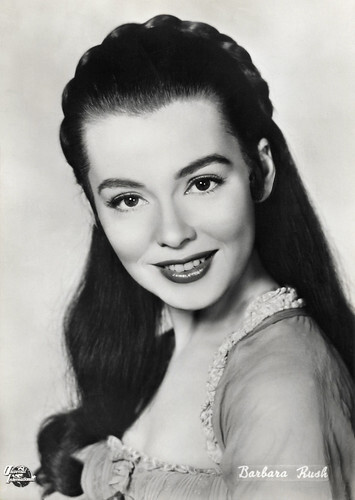
Italian postcard by Bromofoto, Milano, no. 1078. Photo: Universal International.
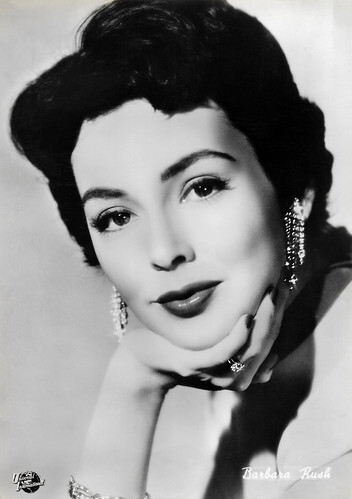
Italian postcard by Bromofoto, Milano, no. 1084. Photo: Universal International.
Sources: (IMDb), Wikipedia, and .

Yugoslavian postcard by Studio Sombor, sent by mail in 1961. Barbara Rush in It Came from Outer Space (Jack Arnold, 1953).

Italian postcard by Rotalfoto. Milano, no. N. 120.
Brittle wives, conniving 'other women' or socialite girlfriend types
Barbara Rush was born in Denver, Colorado in 1927. She was the daughter of Roy Rush, a lawyer for a Midwest mining company, and Marguerite Rush. Barbara grew up in Santa Barbara, California, and enrolled at the University of California where she graduated in 1948.
She then worked with the University Players and took acting classes at the Pasadena Playhouse. Soon talent scouts spotted her and, following a play performance, Paramount quickly signed her up in 1950. She made her film debut with The Goldbergs (Walter Hart, 1950).
Just before this, she had met fellow actor Jeffrey Hunter , an incredibly handsome newcomer who later became a 'beefcake' Bobbysoxer idol at Fox. The two fell in love quickly and married in December of 1950. Soon, they were on their way to becoming one of Hollywood's most beautiful and photogenic young couples. Their son Christopher was born in 1952.
While at Paramount, she was decorative in such assembly-line fare as the classic George Pal Sci-Fi film When Worlds Collide (Rudolph Maté, 1951), Quebec (George Templeton, 1951) opposite John Drew Barrymore, and the Western Flaming Feather (Ray Enright, 1952) starring Sterling Hayden. In 1953 she played the female lead in another Sci-Fi classic, It Came from Outer Space (Jack Arnold, 1953) for which she won a Golden Globe for 'Most Promising Newcomer – Female'.
Rush starred as the wife of James Mason in the acclaimed drama Bigger Than Life (Nicholas Ray, 1956), in which a school teacher's use of an experimental drug results in his threatening harm to his family. She was the love interest of reluctant soldier Dean Martin in the epic World War II drama The Young Lions (Edward Dmytryk, 1958) and of ambitious lawyer Paul Newman in The Young Philadelphians (Vincent Sherman, 1959). She also co-starred opposite Richard Burton , and Kirk Douglas . Gary Brumburgh at IMDb : "In most cases, she played brittle wives, conniving 'other women' or socialite girlfriend types. Despite the 'A' list movies, Barbara was piling up, the one single role that could put her over the top never showed its face."

Big autograph card.
A Woman of Independent Means
By the early 1960s, Barbara Rush's film career started to decline. She married publicist Warren Cowan in 1959 and bore a second child, Claudia Cowan, in 1964. That year, she played a villainess in the Rat Pack's gangster musical Robin and the 7 Hoods (Gordon Douglas, 1964). In the Western drama Hombre (Martin Ritt, 1967) starring Paul Newman , she played a rich, younger, condescending wife of a thief - and ends up taken hostage and tied to a stake.
TV became a viable source of income for Barbara, appearing in scores of guest parts on the more popular shows of the time while co-starring in standard mini-movie dramas. In 1965, she appeared in a two-part episode of The Fugitive titled 'Landscape with Running Figures' as Marie Gérard, wife of police detective Lt. Philip Gérard. She had fun playing a 'guest villainess' in the Batman (1966) series as temptress Nora Clavicle.
The stage also became a strong focus for Barbara. In 1970, she earned the Sarah Siddons Award for 'Forty Carats'. In 1984, she made her Broadway debut in the one-woman showcase 'A Woman of Independent Means', which earned her the Los Angeles Drama Critics Award during its tour.
Other showcases included 'Private Lives', (1973) 'Same Time, Next Year', (1976-1978) 'The Night of the Iguana' (1978), 'Steel Magnolias' (1988-1989), and Vagina Monologues (1995-1997). Among her later film appearances were parts in the disco-themed Can't Stop the Music (Nancy Walker, 1980) with The Village People, and the romantic comedy Summer Lovers (Randal Kleiser, 1982), starring Daryl Hannah .
The still-beautiful Barbara Rush occasionally graced the big and small screen in the later decades, including in a recurring role on TV's 7th Heaven (1997-2007). She died at a care home in Westlake Village, California, in 2024, at the age of 97. Rush married and divorced three times. Her husbands were Jeffrey Hunter (1950-1955), Warren Cowan (1959-1969), and actor Jim Gruzalski (1970-1973). She was the mother of Christopher Hunter and Fox News correspondent Claudia Cowan and aunt of actress Carolyn Hennesy.

Italian postcard by Bromofoto, Milano, no. 1078. Photo: Universal International.

Italian postcard by Bromofoto, Milano, no. 1084. Photo: Universal International.
Sources: (IMDb), Wikipedia, and .
Published on April 01, 2024 22:00
March 31, 2024
Photo by T. v. Mindszenty
Tibor von Mindszenty (1899–?) started his career as Hollywood actor Paul Vincenti. The 'Hungarian Rudolph Valentino' later became a Ufa star photographer in Berlin.
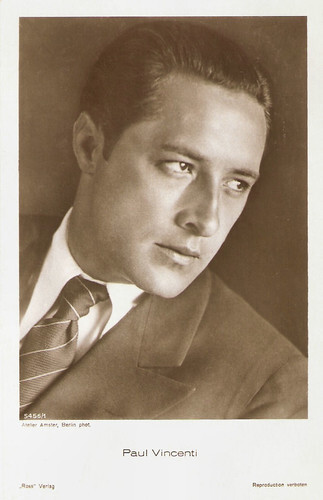
German postcard by Ross Verlag, Berlin, no. 5456/1, 1930-1931. Photo: Atelier Amster, Berlin. Paul Vincenti.
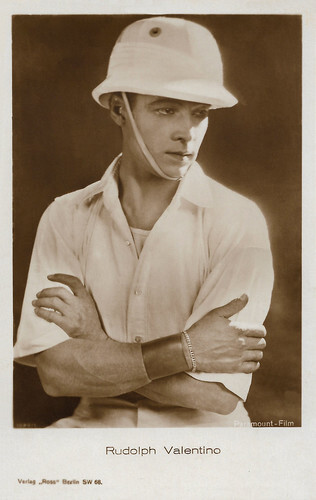
German postcard by Verlag Ross, Berlin, no. 1090/1, 1927-1928. Photo: Paramount-Film. Rudolph Valentino.
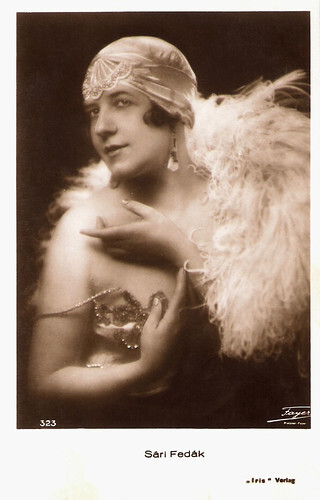
Austrian postcard by Iris Verlag, no. 323. Photo: Fayer. Sári Fedák .
Hungarian actress and singer Sári Fedák (1879-1955) was one of the most famous prima donnas of her time. The temperamental operetta and film star was mixed up in several scandals.
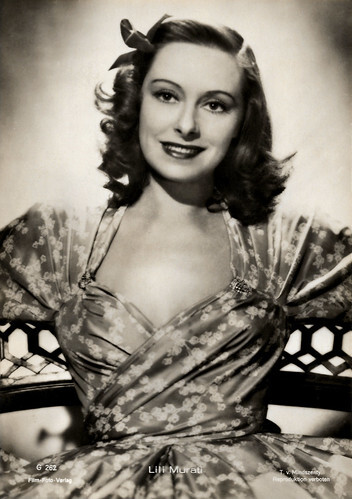
German postcard by Film-Foto-Verlag, no. G 262, 1941-1944. Photo: T. von Mindszenty.
Pretty Hungarian actress Lili Muráti (1914-1963) appeared in nearly 40 films between 1935 and 1995. She was a leading star of the Hungarian cinema in the 1930s. Her role in David Lean’s Dr. Zhivago (1965) became the subject of an urban legend.
The challenge of building a star
Tibor von Mindszenty was born in 1899 in Budapest, then Austria-Hungary. He was also known as Tibor Mindszenty and Tibor Mindszenthy and became known as Paul Vincenti in Hollywood.
He spent his childhood in Italy, Vienna and Budapest. At the age of 17, he was enlisted into the army and served in the First World War as an artillery lieutenant. His greatest passion was sports but to have a civilian position after he was discharged, he took a managerial post in his brother-in-law’s business.
During a boat trip on the Danube, he met celebrated actress Sári Fedák . When the renowned artiste caught sight of the handsome, sporty young man, she thought Mindszenty was the spitting image of Rudolph Valentino . Valentino, who personified the first screen ideal of the Latin heart-throb, died unexpectedly at the age of 31 in August 1926.
Fedák took on the challenge of building a star and clinching a lucrative deal by selling the Americans this Rudolph Valentino doppelgänger. She had screen tests made of Mindszenty at Corvin studio, and she took him to Angelo , the famous star photographer in Pest. A series of portraits published in Színházi Élet proved that Mindszenty could be the next Valentino. In November 1926, Mindszenty and Fedak set off for America.
Mindszenty was initially contracted to First National Film Studio in New York, then in 1929 he joined Fox for a short time. First National’s PR team started to build the image of the new star. One of the most important elements of the campaign was that the actor was heralded as the scion of an ‘ancient Hungarian hussar family’. It is no mere coincidence that his first minor role was in the Hungarian-themed film The Stolen Bride (1927) directed by Alexander Korda and starring Billie Dove. Later on, he appeared in The Love Mart (George Fitzmaurice, 1927) with Billie Dove and Gilbert Roland and he took the lead in the melodrama The Veiled Woman (Emmett J. Flynn, 1929). Mindszenty worked under the catchy stage name of Paul Vincenti from 1927.
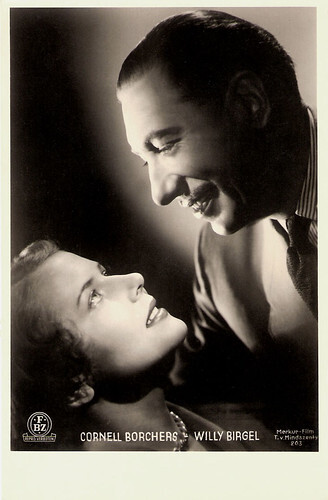
German postcard by FBZ, no. 225. Photo: Merkur-Film / T. v. Mindszenty. Cornell Borchers and Willy Birgel in Das ewige Spiel/The eternal game (Frantisek Cáp, 1951).
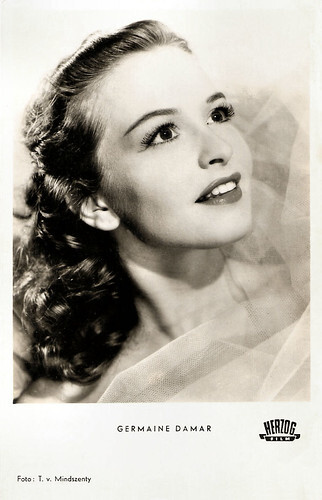
West-German postcard by Kunst und Bild, Berlin, no. A 658. Photo: T. v. Mindszenty / Herzog Film. Germaine Damar in Tanzende Sterne/Dancing Stars (Géza von Cziffra, 1952).
Luxembourg actress and dancer Germaine Damar (1929) started her career as an acrobat. She played in nearly 30 German films, including three films in which she was the partner of Peter Alexander.
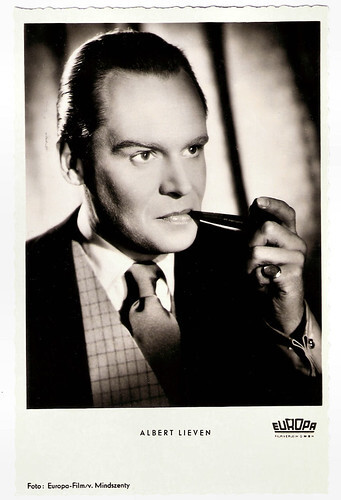
German postcard by Kunst und Bild, Berlin, A 585. Photo: Europa-Film / V. Mindszenty. Albert Lieven in Klettermaxe/Corry Bell (Kurt Hoffmann, 1952).
German character actor Albert Lieven (1906–1971) fled from Nazi Germany to Great Britain. During WW II, he appeared in several British films, often cast as the humourless military. Till the 1970s, he appeared in German and British films and on television.
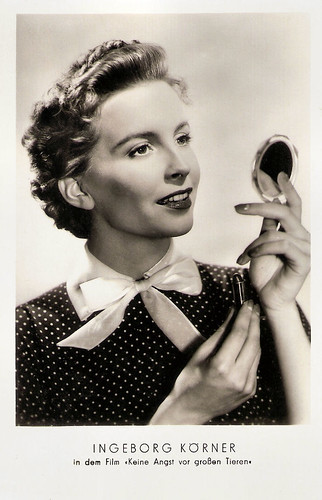
East-German postcard by VEB Volkskunstverlag Reichenbach I.V., no. G 708, 1956. Photo: Von Mindszenty. Ingeborg Körner in Keine Angst vor großen Tieren/Not Afraid of Big Animals (Ulrich Erfurth, 1953).
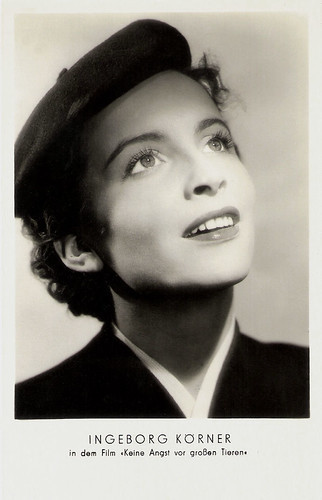
East-German postcard by VEB Volkskunstverlag Reichenbach I.V., no. G 707, 1956. Photo: Von Mindszenty. Ingeborg Körner in Keine Angst vor großen Tieren/Not Afraid of Big Animals (Ulrich Erfurth, 1953).
Ingeborg Körner (1929) is a Namibian-born German actress, best known for her parts in such West-German films as Die Rose von Stambul/The Rose of Stamboul (1953), Keine Angst vor großen Tieren/Not Afraid of Big Animals (1953) and Das ideale Brautpaar/The Perfect Couple (1954). from 1955 on she only appeared on German TV and stage.
The Hungarian connection in Berlin
When his contract expired, Tibor von Mindszenty returned to Europe. He settled in Berlin where he appeared in six films between 1929 and 1934. One of these was the Czech-German coproduced late silent film Kennst du das kleine Haus am Michigansee?/Do You Know That Little House on Lake Michigan? (Viktor Brumlík, Max W. Kimmich, 1929). The story is set in the United States but scenes around the picturesque Lake Michigan were actually shot in the High Tatras.
In the film, Vincenti is a bored playboy whose only passion is water sports until he meets a pretty girl. Critics of the time praised the romantic atmosphere given by nature and Vincenti was deemed to be convincing as the handsome, tough character who was considered by Siegfried Kracauer, critic of Frankfurter Zeitung, to be “both sporty and erotic”.
All his other films from the Berlin period have some Hungarian connection, either as regards the cast and crew or the subject matter. Géza von Bolváry directed Ein Tango für Dich (Géza von Bolváry, 1930) with Ernő Verebes and Tibor Halmay and Der Raub der Mona Lisa/The Theft of the Mona Lisa (Géza von Bolváry, 1931). Seitensprünge (1931), the second film directed by István Székely, was made on the basis of the screenplay by Károly Nóti and Lajos Bíró.
The screenwriters of the musical romance Mein Herz ruft nach Dir/My Heart Calls You (Carmine Gallone, 1934) were Ernst Marischka and Emeric Pressburger, and the editor was Eduard von Borsody. Mein Herz ruft nach Dir is about an opera company and it became famous because Márta Eggerth and Jan Kiepura – one of the most famous dream pairs on the screen – played together in it for the first time. Hilde von Stolz, who was born in Sighișoara (then part of Hungary), had a supporting role.
Vincenti also played in Die Csikósbaroness (Jacob Fleck, Luise Fleck, 1930), one of the typical Hungarian-themed German films of the early sound era. It tells the story of a love affair between a German baroness and a Hungarian hussar officer. The musical film was shot in Hunnia Film Studio, Budapest, in Debrecen and on the Hortobágy. Ernő (Ernst) Verebes and Gretl Theimer play the other two lead roles. The film received mixed reviews from audiences and critics.
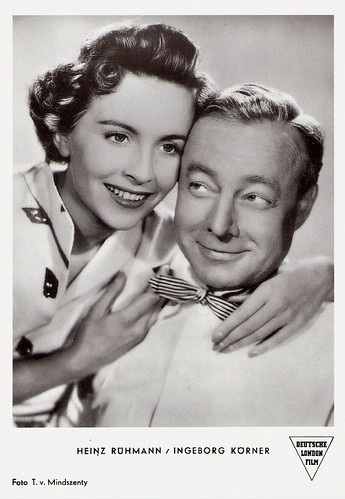
German postcard by K & B / Filmwelt Berlin Archiv für Film-Geschichte, no. 57. Photo: Deutsche London Film / T. von Mindszenty. Heinz Rühmann and Ingeborg Körner in Keine Angst vor großen Tieren/Not Afraid of Big Animals (Ulrich Erfurth, 1953).
Actor, director and producer Heinz Rühmann (1902-1994) played in more than 100 films over nearly 70 years and was one of Germany's most popular film stars. He was a favourite actor of Adolf Hitler and Joseph Goebbels but also of Anne Frank. She pasted his photo on the wall of her room in her family's hiding place during the war, where it can still be seen today.
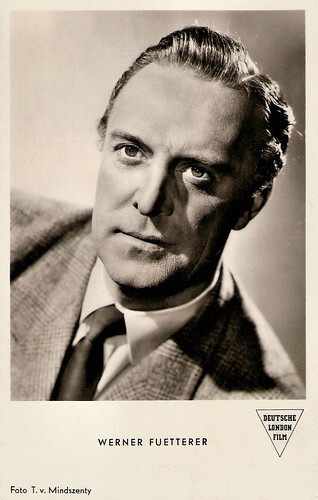
German postcard by Kunst und Bild, Berlin, no. A 838. Photo: T. von Mindszenty / Deutsche London Film. Werner Fuetterer in Keine Angst vor grossen Tieren/Don't Fear Big Animals (Ulrich Erfurth, 1953).
At the age of 18, German actor Werner Fuetterer (1907-1991) was discovered to play the young lover in a series of silent films. For more than four decades he went on to work as a supporting actor in nearly 100 films.
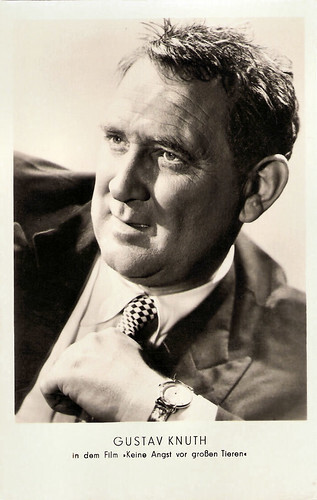
East-German postcard by VEB Volkskunstverlag Reichenbach i.V., no. G 7C6. Photo: Real / v. Mindszenty, 1956. Gustav Knuth in Keine Angst für grossen Tieren/Not Afraid of Big Animals (Ulrich Erfurth, 1953).
Gustav Knuth (1901-1987) was a German actor who played folksy, good-natured characters in numerous films and TV series. After the Second World War, he took Swiss citizenship. He was a successful stage actor and starred in more than 120 films between 1935 and 1982. During the 1960s and 1970s, he was one of the most distinguished German TV actors.
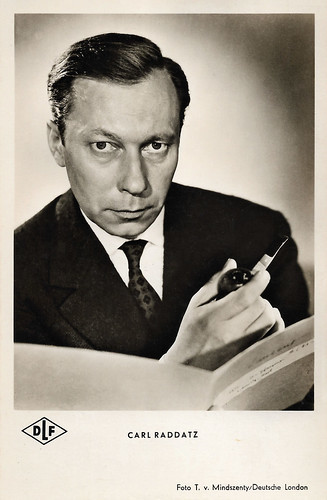
German postcard by Kunst und Bild, no. A 1189. Photo: T. v. Mindszenty / Deutsche London (TLF). Carl Raddatz in Geständnis unter vier Augen/Confession Under Four Eyes (André Michel, 1954).
German actor Carl Raddatz (1912-2004) was much in demand by film producers in the 1940s and especially in the 1950s. He appeared in several Nazi propaganda films, but he also gave Joseph Stalin a German voice. Through the years he would become one of the leading character actors of the German theatre.
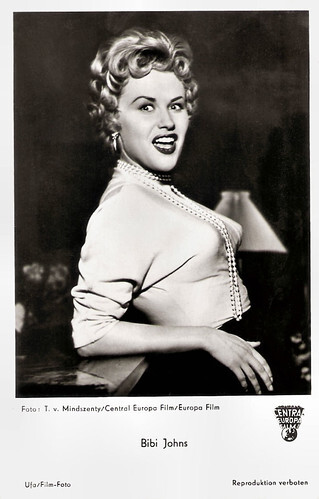
German postcard by Ufa, Berlin-Tempelhof, no. FK 1647. Photo: T. v. Mindszenty / Central Europa Film / Europa Film. Bibi Johns in Ball im Savoy/Ball at the Savoy (Paul Martin, 1955).
Blond Swedish pop singer and actress Bibi Johns (1929) was very popular in Europe and the USA during the 1950s. She appeared in several European musical films. In Germany, where she lived from 1954 on, she would become a cult star of the Schlager music. Today she is also known as a painter.
A true expert in the European star system
Perhaps this reception contributed to the fact that in the second half of the 1930s, Tibor von Mindszenty decided to open a totally new chapter in his life. Having studied photography in America, he found that he preferred to work behind the camera in the German capital.
He opened a photography studio and became a star photographer specialising in the fashionable trends of the era. Maybe he never forgot how much he owed photographer Angelo in Budapest because he also took his new profession extremely seriously. He worked on studio portraits and commercial photos primarily for Ufa film stars and magazines, and, interestingly, he signed off his works once again as ‘Mindszenty’ and ‘T. v. Mindszenty’.
Soon he had trained himself as a true expert of the European star system and his photographs served as references for the studios. In 1943, at the request of Ufa, he returned to Hungary to make a photo series of local stars and he also received orders that if he came across suitable young talents, he should notify the Berlin centre.
In an interview made in 1943, he said that he belonged to the circle of friends of directors Géza von Bolváry and József von Baky in Berlin. After the war, he continued working as a still photographer in Germany.
During the 1950s he worked on such German films as the romantic comedy Fanfaren der Liebe/Fanfares of Love (Kurt Hoffmann, 1951) starring Dieter Borsche , the musical comedy Geld aus der Luft/Money from the Air (Geza von Cziffra, 1955) with Lonny Kellner, and the crime drama Banditen der Autobahn/Bandits of the Highway (Geza von Cziffra, 1955) with Eva Ingeborg Scholz and Hans Christian Blech. During the early 1960s, Tibor von Mindszenty worked as a production manager for German television. When and where he passed away is unknown.
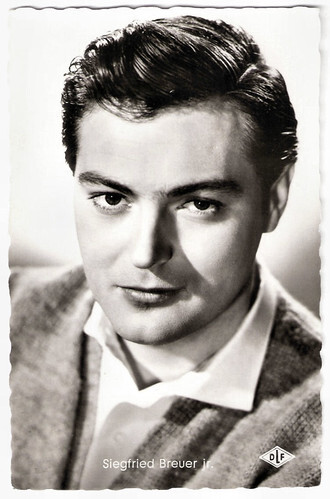
German postcard by Kolibri-Verlag, Minden-Westf., no. 1961. Photo: Deutsche London / Von Mindszenty. Publicity still for Die gestolene Hose/The Stolen Trousers (Géza von Cziffra, 1956).
Siegfried Breuer Jr. (1930-2004) was an Austrian film actor. He often played jeune premiers in German films of the 1950s and early 1960s.
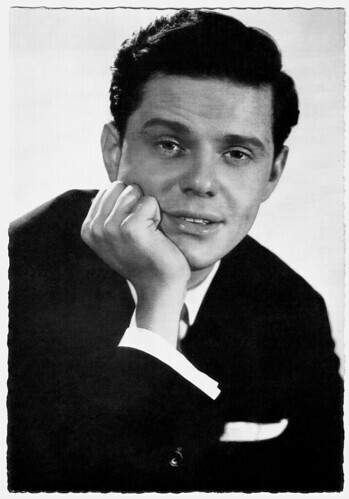
German postcard by WS-Druck, Wanne-Eickel, no. 22. Photo: Arca / NF / V. Mindszenty.
German actor Walter Giller (1927-2011) was the cute boy-next-door in German films of the 1950s. With Nadja Tiller, he became a Dream Couple in European cinema.
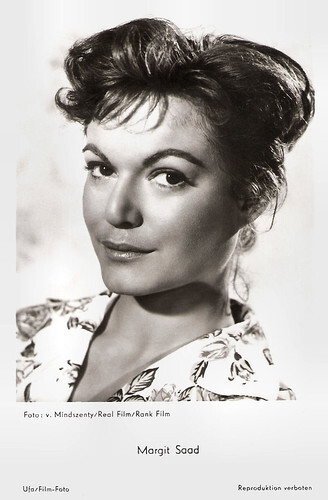
German postcard by Ufa, Berlin-Tempelhof, no. FK 3302. Photo: v. Mindszenty / Real-Film / Rank Film. Publicity still for Drei Birken auf der Heide/Three birches on the heath (Ulrich Erfurth, 1956).
German actress Margit Saad (1929) was a mysterious, exotic beauty working largely in German film and television. During the 1960s, she also made occasional English-language appearances.
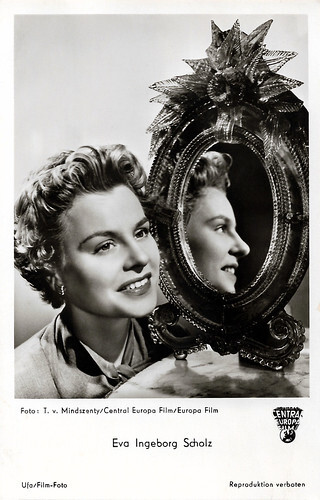
West-German postcard by Ufa/Film-Foto, Berlin-Tempelhof, no. 1652. Photo: T. v. Mindszenty / Central Europa Film / Europa Film. Eva Ingeborg Scholz in Ball im Savoy/Ball at the Savoy (Paul Martin, 1955).
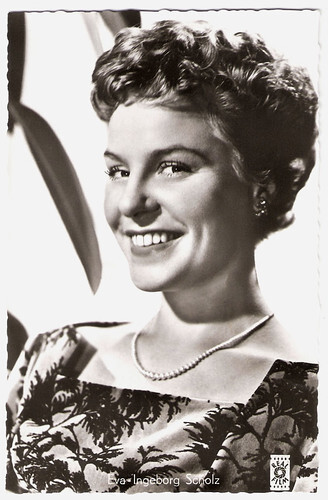
West-German postcard by Kolibri-Verlag G,m.b.H., Minden/Westf., no. 1635. Photo: Real / Rank-Film / v Mindszenty. Eva Ingeborg Scholz in Unternehmen Schlafsack/Operation Sleeping Bag (Arthur Maria Rabenalt, 1955).
Since her East German debut in 1948, German film and television actress Eva Ingeborg Scholz (1928-2022) played in more than 110 film and television productions.
Sources: Barkóczi Janka (National Film Institute Hungary), Filmportal.de and .

German postcard by Ross Verlag, Berlin, no. 5456/1, 1930-1931. Photo: Atelier Amster, Berlin. Paul Vincenti.

German postcard by Verlag Ross, Berlin, no. 1090/1, 1927-1928. Photo: Paramount-Film. Rudolph Valentino.

Austrian postcard by Iris Verlag, no. 323. Photo: Fayer. Sári Fedák .
Hungarian actress and singer Sári Fedák (1879-1955) was one of the most famous prima donnas of her time. The temperamental operetta and film star was mixed up in several scandals.

German postcard by Film-Foto-Verlag, no. G 262, 1941-1944. Photo: T. von Mindszenty.
Pretty Hungarian actress Lili Muráti (1914-1963) appeared in nearly 40 films between 1935 and 1995. She was a leading star of the Hungarian cinema in the 1930s. Her role in David Lean’s Dr. Zhivago (1965) became the subject of an urban legend.
The challenge of building a star
Tibor von Mindszenty was born in 1899 in Budapest, then Austria-Hungary. He was also known as Tibor Mindszenty and Tibor Mindszenthy and became known as Paul Vincenti in Hollywood.
He spent his childhood in Italy, Vienna and Budapest. At the age of 17, he was enlisted into the army and served in the First World War as an artillery lieutenant. His greatest passion was sports but to have a civilian position after he was discharged, he took a managerial post in his brother-in-law’s business.
During a boat trip on the Danube, he met celebrated actress Sári Fedák . When the renowned artiste caught sight of the handsome, sporty young man, she thought Mindszenty was the spitting image of Rudolph Valentino . Valentino, who personified the first screen ideal of the Latin heart-throb, died unexpectedly at the age of 31 in August 1926.
Fedák took on the challenge of building a star and clinching a lucrative deal by selling the Americans this Rudolph Valentino doppelgänger. She had screen tests made of Mindszenty at Corvin studio, and she took him to Angelo , the famous star photographer in Pest. A series of portraits published in Színházi Élet proved that Mindszenty could be the next Valentino. In November 1926, Mindszenty and Fedak set off for America.
Mindszenty was initially contracted to First National Film Studio in New York, then in 1929 he joined Fox for a short time. First National’s PR team started to build the image of the new star. One of the most important elements of the campaign was that the actor was heralded as the scion of an ‘ancient Hungarian hussar family’. It is no mere coincidence that his first minor role was in the Hungarian-themed film The Stolen Bride (1927) directed by Alexander Korda and starring Billie Dove. Later on, he appeared in The Love Mart (George Fitzmaurice, 1927) with Billie Dove and Gilbert Roland and he took the lead in the melodrama The Veiled Woman (Emmett J. Flynn, 1929). Mindszenty worked under the catchy stage name of Paul Vincenti from 1927.

German postcard by FBZ, no. 225. Photo: Merkur-Film / T. v. Mindszenty. Cornell Borchers and Willy Birgel in Das ewige Spiel/The eternal game (Frantisek Cáp, 1951).

West-German postcard by Kunst und Bild, Berlin, no. A 658. Photo: T. v. Mindszenty / Herzog Film. Germaine Damar in Tanzende Sterne/Dancing Stars (Géza von Cziffra, 1952).
Luxembourg actress and dancer Germaine Damar (1929) started her career as an acrobat. She played in nearly 30 German films, including three films in which she was the partner of Peter Alexander.

German postcard by Kunst und Bild, Berlin, A 585. Photo: Europa-Film / V. Mindszenty. Albert Lieven in Klettermaxe/Corry Bell (Kurt Hoffmann, 1952).
German character actor Albert Lieven (1906–1971) fled from Nazi Germany to Great Britain. During WW II, he appeared in several British films, often cast as the humourless military. Till the 1970s, he appeared in German and British films and on television.

East-German postcard by VEB Volkskunstverlag Reichenbach I.V., no. G 708, 1956. Photo: Von Mindszenty. Ingeborg Körner in Keine Angst vor großen Tieren/Not Afraid of Big Animals (Ulrich Erfurth, 1953).

East-German postcard by VEB Volkskunstverlag Reichenbach I.V., no. G 707, 1956. Photo: Von Mindszenty. Ingeborg Körner in Keine Angst vor großen Tieren/Not Afraid of Big Animals (Ulrich Erfurth, 1953).
Ingeborg Körner (1929) is a Namibian-born German actress, best known for her parts in such West-German films as Die Rose von Stambul/The Rose of Stamboul (1953), Keine Angst vor großen Tieren/Not Afraid of Big Animals (1953) and Das ideale Brautpaar/The Perfect Couple (1954). from 1955 on she only appeared on German TV and stage.
The Hungarian connection in Berlin
When his contract expired, Tibor von Mindszenty returned to Europe. He settled in Berlin where he appeared in six films between 1929 and 1934. One of these was the Czech-German coproduced late silent film Kennst du das kleine Haus am Michigansee?/Do You Know That Little House on Lake Michigan? (Viktor Brumlík, Max W. Kimmich, 1929). The story is set in the United States but scenes around the picturesque Lake Michigan were actually shot in the High Tatras.
In the film, Vincenti is a bored playboy whose only passion is water sports until he meets a pretty girl. Critics of the time praised the romantic atmosphere given by nature and Vincenti was deemed to be convincing as the handsome, tough character who was considered by Siegfried Kracauer, critic of Frankfurter Zeitung, to be “both sporty and erotic”.
All his other films from the Berlin period have some Hungarian connection, either as regards the cast and crew or the subject matter. Géza von Bolváry directed Ein Tango für Dich (Géza von Bolváry, 1930) with Ernő Verebes and Tibor Halmay and Der Raub der Mona Lisa/The Theft of the Mona Lisa (Géza von Bolváry, 1931). Seitensprünge (1931), the second film directed by István Székely, was made on the basis of the screenplay by Károly Nóti and Lajos Bíró.
The screenwriters of the musical romance Mein Herz ruft nach Dir/My Heart Calls You (Carmine Gallone, 1934) were Ernst Marischka and Emeric Pressburger, and the editor was Eduard von Borsody. Mein Herz ruft nach Dir is about an opera company and it became famous because Márta Eggerth and Jan Kiepura – one of the most famous dream pairs on the screen – played together in it for the first time. Hilde von Stolz, who was born in Sighișoara (then part of Hungary), had a supporting role.
Vincenti also played in Die Csikósbaroness (Jacob Fleck, Luise Fleck, 1930), one of the typical Hungarian-themed German films of the early sound era. It tells the story of a love affair between a German baroness and a Hungarian hussar officer. The musical film was shot in Hunnia Film Studio, Budapest, in Debrecen and on the Hortobágy. Ernő (Ernst) Verebes and Gretl Theimer play the other two lead roles. The film received mixed reviews from audiences and critics.

German postcard by K & B / Filmwelt Berlin Archiv für Film-Geschichte, no. 57. Photo: Deutsche London Film / T. von Mindszenty. Heinz Rühmann and Ingeborg Körner in Keine Angst vor großen Tieren/Not Afraid of Big Animals (Ulrich Erfurth, 1953).
Actor, director and producer Heinz Rühmann (1902-1994) played in more than 100 films over nearly 70 years and was one of Germany's most popular film stars. He was a favourite actor of Adolf Hitler and Joseph Goebbels but also of Anne Frank. She pasted his photo on the wall of her room in her family's hiding place during the war, where it can still be seen today.

German postcard by Kunst und Bild, Berlin, no. A 838. Photo: T. von Mindszenty / Deutsche London Film. Werner Fuetterer in Keine Angst vor grossen Tieren/Don't Fear Big Animals (Ulrich Erfurth, 1953).
At the age of 18, German actor Werner Fuetterer (1907-1991) was discovered to play the young lover in a series of silent films. For more than four decades he went on to work as a supporting actor in nearly 100 films.

East-German postcard by VEB Volkskunstverlag Reichenbach i.V., no. G 7C6. Photo: Real / v. Mindszenty, 1956. Gustav Knuth in Keine Angst für grossen Tieren/Not Afraid of Big Animals (Ulrich Erfurth, 1953).
Gustav Knuth (1901-1987) was a German actor who played folksy, good-natured characters in numerous films and TV series. After the Second World War, he took Swiss citizenship. He was a successful stage actor and starred in more than 120 films between 1935 and 1982. During the 1960s and 1970s, he was one of the most distinguished German TV actors.

German postcard by Kunst und Bild, no. A 1189. Photo: T. v. Mindszenty / Deutsche London (TLF). Carl Raddatz in Geständnis unter vier Augen/Confession Under Four Eyes (André Michel, 1954).
German actor Carl Raddatz (1912-2004) was much in demand by film producers in the 1940s and especially in the 1950s. He appeared in several Nazi propaganda films, but he also gave Joseph Stalin a German voice. Through the years he would become one of the leading character actors of the German theatre.

German postcard by Ufa, Berlin-Tempelhof, no. FK 1647. Photo: T. v. Mindszenty / Central Europa Film / Europa Film. Bibi Johns in Ball im Savoy/Ball at the Savoy (Paul Martin, 1955).
Blond Swedish pop singer and actress Bibi Johns (1929) was very popular in Europe and the USA during the 1950s. She appeared in several European musical films. In Germany, where she lived from 1954 on, she would become a cult star of the Schlager music. Today she is also known as a painter.
A true expert in the European star system
Perhaps this reception contributed to the fact that in the second half of the 1930s, Tibor von Mindszenty decided to open a totally new chapter in his life. Having studied photography in America, he found that he preferred to work behind the camera in the German capital.
He opened a photography studio and became a star photographer specialising in the fashionable trends of the era. Maybe he never forgot how much he owed photographer Angelo in Budapest because he also took his new profession extremely seriously. He worked on studio portraits and commercial photos primarily for Ufa film stars and magazines, and, interestingly, he signed off his works once again as ‘Mindszenty’ and ‘T. v. Mindszenty’.
Soon he had trained himself as a true expert of the European star system and his photographs served as references for the studios. In 1943, at the request of Ufa, he returned to Hungary to make a photo series of local stars and he also received orders that if he came across suitable young talents, he should notify the Berlin centre.
In an interview made in 1943, he said that he belonged to the circle of friends of directors Géza von Bolváry and József von Baky in Berlin. After the war, he continued working as a still photographer in Germany.
During the 1950s he worked on such German films as the romantic comedy Fanfaren der Liebe/Fanfares of Love (Kurt Hoffmann, 1951) starring Dieter Borsche , the musical comedy Geld aus der Luft/Money from the Air (Geza von Cziffra, 1955) with Lonny Kellner, and the crime drama Banditen der Autobahn/Bandits of the Highway (Geza von Cziffra, 1955) with Eva Ingeborg Scholz and Hans Christian Blech. During the early 1960s, Tibor von Mindszenty worked as a production manager for German television. When and where he passed away is unknown.

German postcard by Kolibri-Verlag, Minden-Westf., no. 1961. Photo: Deutsche London / Von Mindszenty. Publicity still for Die gestolene Hose/The Stolen Trousers (Géza von Cziffra, 1956).
Siegfried Breuer Jr. (1930-2004) was an Austrian film actor. He often played jeune premiers in German films of the 1950s and early 1960s.

German postcard by WS-Druck, Wanne-Eickel, no. 22. Photo: Arca / NF / V. Mindszenty.
German actor Walter Giller (1927-2011) was the cute boy-next-door in German films of the 1950s. With Nadja Tiller, he became a Dream Couple in European cinema.

German postcard by Ufa, Berlin-Tempelhof, no. FK 3302. Photo: v. Mindszenty / Real-Film / Rank Film. Publicity still for Drei Birken auf der Heide/Three birches on the heath (Ulrich Erfurth, 1956).
German actress Margit Saad (1929) was a mysterious, exotic beauty working largely in German film and television. During the 1960s, she also made occasional English-language appearances.

West-German postcard by Ufa/Film-Foto, Berlin-Tempelhof, no. 1652. Photo: T. v. Mindszenty / Central Europa Film / Europa Film. Eva Ingeborg Scholz in Ball im Savoy/Ball at the Savoy (Paul Martin, 1955).

West-German postcard by Kolibri-Verlag G,m.b.H., Minden/Westf., no. 1635. Photo: Real / Rank-Film / v Mindszenty. Eva Ingeborg Scholz in Unternehmen Schlafsack/Operation Sleeping Bag (Arthur Maria Rabenalt, 1955).
Since her East German debut in 1948, German film and television actress Eva Ingeborg Scholz (1928-2022) played in more than 110 film and television productions.
Sources: Barkóczi Janka (National Film Institute Hungary), Filmportal.de and .
Published on March 31, 2024 22:00
March 30, 2024
Rex Allen
American film and television actor, singer and songwriter Rex Allen (1920-1999) was known as 'the Arizona Cowboy'. As a singing cowboy in Republic Westerns, he was one of the top-ten box office draws in the early 1950s. Later, he was the narrator of many Disney nature and Western productions.
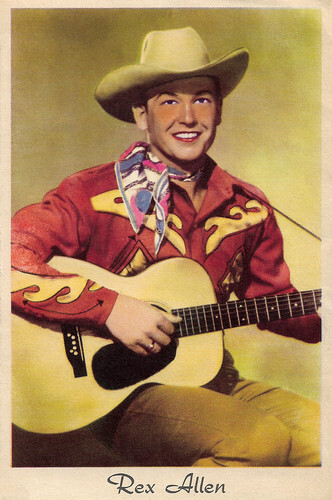
Dutch card.
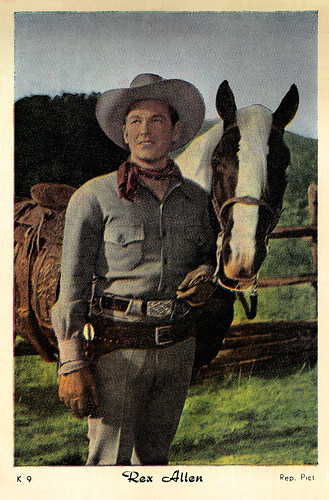
Dutch collector card, no. K 9. Photo: Republic Pictures.
The clean-cut, God-fearing American hero of the Wild West
Rex Elvie Allen was born in 1920 to Horace E. Allen and Luella Faye Clark on a ranch in Mud Springs Canyon, forty miles from Willcox in Cochise County in southeastern Arizona. As a boy, he played guitar and sang at local functions with his fiddle-playing father until high school graduation, when he toured the Southwest as a rodeo rider.
He got his start in show business on the East Coast as a vaudeville singer, then found work in Chicago as a performer on the WLS-AM program, National Barn Dance. He left the show in 1949 and moved to Hollywood. In 1948 he signed with Mercury Records where he recorded many successful country music singles until 1952, when he switched to the Decca label where he continued to make records into the 1970s. He also recorded one album for Buena Vista (Disney, pictured) in the 1960s, although sources vary on the date of issue.
When singing cowboys such as Roy Rogers and Gene Autry were very much in vogue in American film, Republic Pictures in Hollywood gave him a screen test and put him under contract in 1949. Beginning with The Arizona Cowboy (R. G. Springsteen, 1950), Allen starred as himself in 19 Hollywood Westerns. One of the top-ten box office draws of the day, whose character was soon depicted in comic books. On-screen, Allen personified the clean-cut, God-fearing American hero of the wild West who wore a white Stetson hat, loved his faithful horse Koko, and had a loyal buddy who shared his adventures.
Allen's comic-relief sidekick in his first few pictures was Buddy Ebsen and then character actor Slim Pickens. Late in coming to the industry, Rex Allen's film career was relatively short as the popularity of Westerns faded by the mid-1950s. But he starred in several B-Westerns during the 1950s, often filming on the Iverson Movie Ranch in Chatsworth, Calif., known for its huge sandstone boulders. Allen has the distinction of making Phantom Stallion (Harry Keller, 1954), the last singing Western.
As other cowboy stars made the transition to television, Allen tried too, cast as Dr. Bill Baxter for a half-hour weekly series called Frontier Doctor, which filmed much of its outdoor action on the Republic Pictures backlot and at the Iverson Movie Ranch. In 1961 he was one of five rotating hosts for NBC-TV's Five Star Jubilee. Allen had a rich, pleasant voice, ideally suited for narration, and was able to find considerable work as a narrator in a variety of films, especially for Walt Disney Pictures wildlife films and television shows. The work earned him the nickname, 'The Voice of the West'. He narrated the original version of The Incredible Journey (Fletcher Markle, 1963). Allen also provided the narration for the Hanna-Barbera animated film Charlotte's Web (Charles Nichols, Iwao Takamoto, 1973).
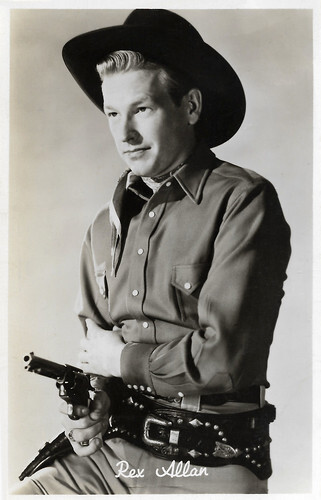
Belgian postcard by Nieuwe Merksemsche Chocolaterie S.P.R.L., Merksem (Anvers). Photo: Republic Pictures.
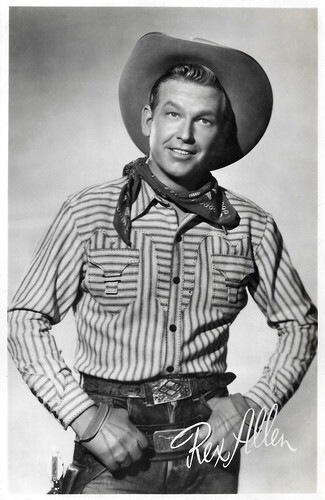
Dutch postcard by DRC, no. F 156. Photo: Republic Pictures.
Don't Go Near The Indians
Rex Allen wrote and recorded many songs, some of which were featured in his films. One of Allen's most successful singles was 'Don't Go Near The Indians', which reached the Top 5 of Billboard magazine's Hot Country Singles chart in November 1962. It features The Merry Melody Singers.
The song is a tale of a young man who disobeys his father's advice stated in the title. When the father finds out that he has developed a relationship with a beautiful Indian maiden (named Nova Lee), he decides to reveal to his son what he had kept secret for so long: The man's biological son was killed by an Indian (as stated in the lyrics) during a clash between the white man and a tribe, and in retaliation, he kidnapped the boy as a young baby and raised him as his son. The other secret: His son cannot marry Nova Lee because she's the boy's biological sister.
In his later years, he performed frequently with actor Pedro Gonzalez-Gonzalez. He wrote and sang the theme song for the early 1980s sitcom Best of the West. Rex Allen died in 1999, two weeks before his 79th birthday, in Tucson, Arizona, after he sustained fatal injuries when his caregiver accidentally ran over him in the driveway. Cremated, his ashes were scattered at Railroad Park in Willcox where most of his memorabilia are on display.
Allen was married three times; all three marriages ended in divorce. First, in 1940, he married Doris Windsor, with whom he had one child, Rexine Allen. His second marriage was to Bonnie Linder (1946–1973), with whom he had 4 children. His third and final marriage was to Virginia Hudson in 1992. The couple divorced in 1999. His five children included Rex Allen Jr., who became a singer like his father.
For his contribution to the motion picture industry, Allen was given a star on the Hollywood Walk of Fame at 6821 Hollywood Boulevard. The Rex Allen Arizona Cowboy Museum and Willcox Cowboy Hall of Fame in Willcox, Arizona features Allen's collection of memorabilia, including photos, movie posters, cowboy outfits, records and musical instruments. Across the street from the museum is a bronze statue of Allen.
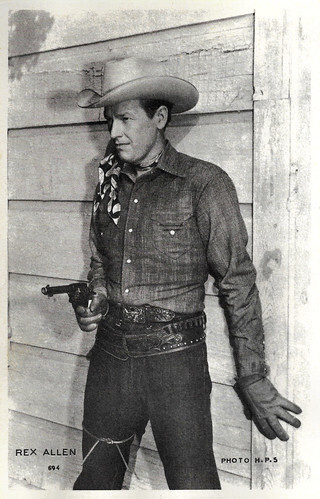
Vintage postcard by Royal Chewing Gum, no. 694. Photo: H.P.S.
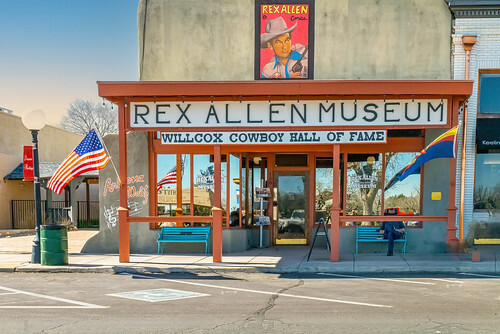
Rex Allen Museum. Image: Clive Aldenhoven @ Flickr.
Sources: Wikipedia (Dutch and English) and .

Dutch card.

Dutch collector card, no. K 9. Photo: Republic Pictures.
The clean-cut, God-fearing American hero of the Wild West
Rex Elvie Allen was born in 1920 to Horace E. Allen and Luella Faye Clark on a ranch in Mud Springs Canyon, forty miles from Willcox in Cochise County in southeastern Arizona. As a boy, he played guitar and sang at local functions with his fiddle-playing father until high school graduation, when he toured the Southwest as a rodeo rider.
He got his start in show business on the East Coast as a vaudeville singer, then found work in Chicago as a performer on the WLS-AM program, National Barn Dance. He left the show in 1949 and moved to Hollywood. In 1948 he signed with Mercury Records where he recorded many successful country music singles until 1952, when he switched to the Decca label where he continued to make records into the 1970s. He also recorded one album for Buena Vista (Disney, pictured) in the 1960s, although sources vary on the date of issue.
When singing cowboys such as Roy Rogers and Gene Autry were very much in vogue in American film, Republic Pictures in Hollywood gave him a screen test and put him under contract in 1949. Beginning with The Arizona Cowboy (R. G. Springsteen, 1950), Allen starred as himself in 19 Hollywood Westerns. One of the top-ten box office draws of the day, whose character was soon depicted in comic books. On-screen, Allen personified the clean-cut, God-fearing American hero of the wild West who wore a white Stetson hat, loved his faithful horse Koko, and had a loyal buddy who shared his adventures.
Allen's comic-relief sidekick in his first few pictures was Buddy Ebsen and then character actor Slim Pickens. Late in coming to the industry, Rex Allen's film career was relatively short as the popularity of Westerns faded by the mid-1950s. But he starred in several B-Westerns during the 1950s, often filming on the Iverson Movie Ranch in Chatsworth, Calif., known for its huge sandstone boulders. Allen has the distinction of making Phantom Stallion (Harry Keller, 1954), the last singing Western.
As other cowboy stars made the transition to television, Allen tried too, cast as Dr. Bill Baxter for a half-hour weekly series called Frontier Doctor, which filmed much of its outdoor action on the Republic Pictures backlot and at the Iverson Movie Ranch. In 1961 he was one of five rotating hosts for NBC-TV's Five Star Jubilee. Allen had a rich, pleasant voice, ideally suited for narration, and was able to find considerable work as a narrator in a variety of films, especially for Walt Disney Pictures wildlife films and television shows. The work earned him the nickname, 'The Voice of the West'. He narrated the original version of The Incredible Journey (Fletcher Markle, 1963). Allen also provided the narration for the Hanna-Barbera animated film Charlotte's Web (Charles Nichols, Iwao Takamoto, 1973).

Belgian postcard by Nieuwe Merksemsche Chocolaterie S.P.R.L., Merksem (Anvers). Photo: Republic Pictures.

Dutch postcard by DRC, no. F 156. Photo: Republic Pictures.
Don't Go Near The Indians
Rex Allen wrote and recorded many songs, some of which were featured in his films. One of Allen's most successful singles was 'Don't Go Near The Indians', which reached the Top 5 of Billboard magazine's Hot Country Singles chart in November 1962. It features The Merry Melody Singers.
The song is a tale of a young man who disobeys his father's advice stated in the title. When the father finds out that he has developed a relationship with a beautiful Indian maiden (named Nova Lee), he decides to reveal to his son what he had kept secret for so long: The man's biological son was killed by an Indian (as stated in the lyrics) during a clash between the white man and a tribe, and in retaliation, he kidnapped the boy as a young baby and raised him as his son. The other secret: His son cannot marry Nova Lee because she's the boy's biological sister.
In his later years, he performed frequently with actor Pedro Gonzalez-Gonzalez. He wrote and sang the theme song for the early 1980s sitcom Best of the West. Rex Allen died in 1999, two weeks before his 79th birthday, in Tucson, Arizona, after he sustained fatal injuries when his caregiver accidentally ran over him in the driveway. Cremated, his ashes were scattered at Railroad Park in Willcox where most of his memorabilia are on display.
Allen was married three times; all three marriages ended in divorce. First, in 1940, he married Doris Windsor, with whom he had one child, Rexine Allen. His second marriage was to Bonnie Linder (1946–1973), with whom he had 4 children. His third and final marriage was to Virginia Hudson in 1992. The couple divorced in 1999. His five children included Rex Allen Jr., who became a singer like his father.
For his contribution to the motion picture industry, Allen was given a star on the Hollywood Walk of Fame at 6821 Hollywood Boulevard. The Rex Allen Arizona Cowboy Museum and Willcox Cowboy Hall of Fame in Willcox, Arizona features Allen's collection of memorabilia, including photos, movie posters, cowboy outfits, records and musical instruments. Across the street from the museum is a bronze statue of Allen.

Vintage postcard by Royal Chewing Gum, no. 694. Photo: H.P.S.

Rex Allen Museum. Image: Clive Aldenhoven @ Flickr.
Sources: Wikipedia (Dutch and English) and .
Published on March 30, 2024 22:00
March 29, 2024
La Collectionneuse: Jeanette MacDonald
Jeanette MacDonald (1903-1965) was the undisputed queen of Hollywood operettas in the 1930s. Besides being a gifted singer, she also was a skilled comedienne. At the begining of her film career, she was at her sauciest and had no qualms about wearing revealing lingerie and appearing in boudoir scenes. It’s no coincidence that Ernst Lubitsch, the king of sophisticated and risqué comedies, used her in four films. In the mid-1930s, her screen image was softened, as Louis B. Mayer believed in wholesome entertainment and favoured family-oriented films. Her association with Nelson Eddy was a stroke of genius from M.G.M. and they became the much-loved 'America’s Singing Sweethearts'.
Jeanette was a consumate and mindful professional who always tried to give her adoring and loyal fans an access to an operatic repertoire which was mostly associated until then with a social elite. It was not unusual for her to include famous arias from Gounod, Puccini, Verdi, Bizet, Donizetti, etc. in her films and her recitals. She handled her business arrangements with skill and determination and was no slouch when it came to the technical aspects of filming. In Hollywood, she was going to be known as 'The Iron Butterfly'.
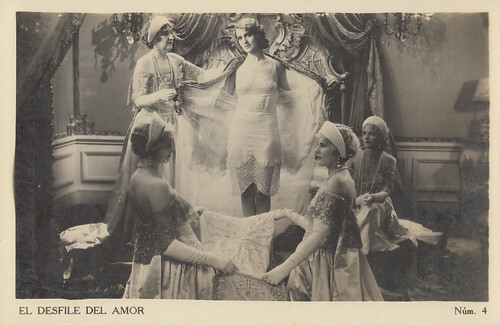
Spanish postcard, no. 4. Jeanette MacDonald in The Love Parade (Ernst Lubitsch, 1929).
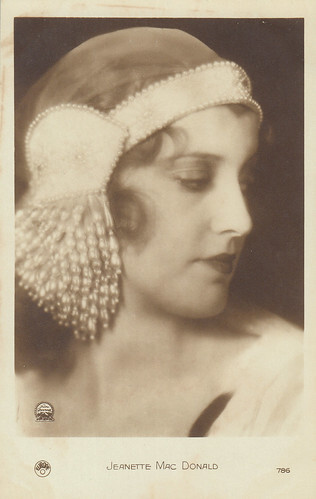
French postcard by Europe, no. 786. Photo: Films Paramount.
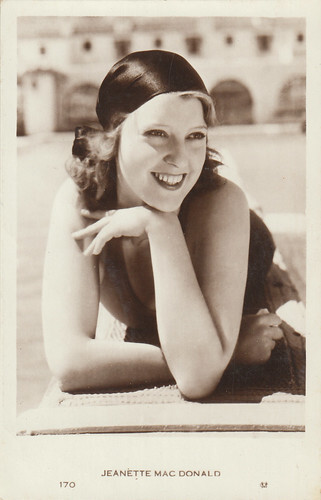
Spanish postcard by MC, Barcelona, no. 170.
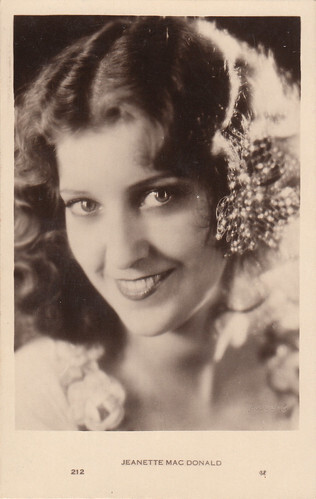
Spanish postcard by MC, Barcelona, no. 212.
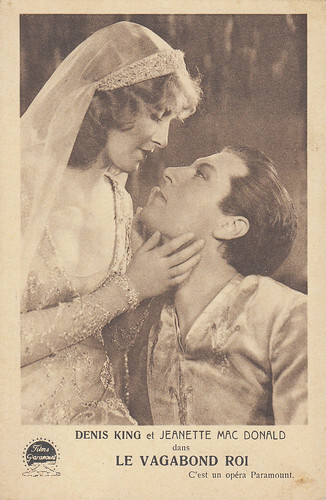
Belgian postcard. Photo: Films Paramount. Jeanette MacDonald and Dennis King in The Vagabond King (Ludwig Berger, 1930).
A musical childhood
Jeanette MacDonald was born as Jeannette Anna McDonald on the 18th of June 1903 in Philadelphia, Pennsylvania, U.S.A. Later, she dropped one of the n’s from her first name and add an a to her surname.
She made her first public appearance, singing a religious hymn, at the age of three at a Presbyterian Church.
On the 19th of February 1909, she had three solo spots in 'Charity', a children’s opera written for a benefit performance, at the Philadelphia Academy of Music. It earned her her first favourable reviews in the local press.
From 1911 to 1913, she performed in Vaudeville with five other children in a kiddie act, 'The Six Sunny Song Birds'. She then joined 'The Seven Merry Yougsters' in 1914.
But the 'Gerry Society of New York City', which protected children from commercial exploitation, soon sued Jeanette’s parents. As a result, she had to go back to school and to momentarily put her stage ambitions aside.
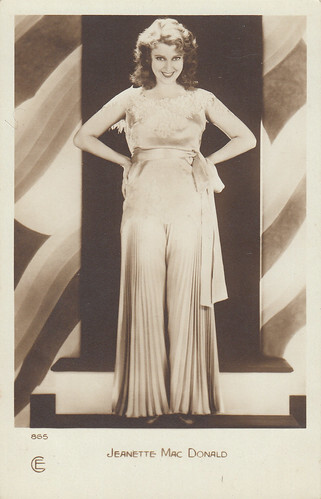
French postcard by Cinémagazine, no. 865.
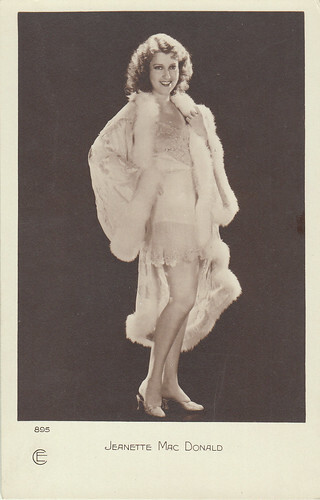
French postcard by Cinémagazine, no. 895.
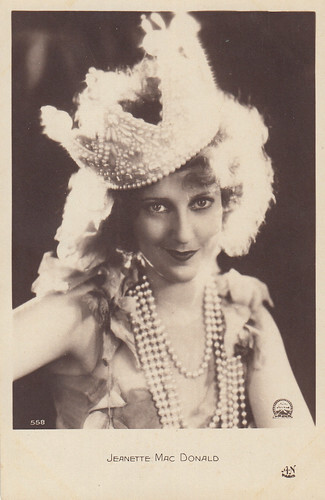
French postcard by A.N., Paris, no. 558. Photo: Paramount. Jeanette MacDonald in Let’s Go Native (Leo McCarey, 1930).
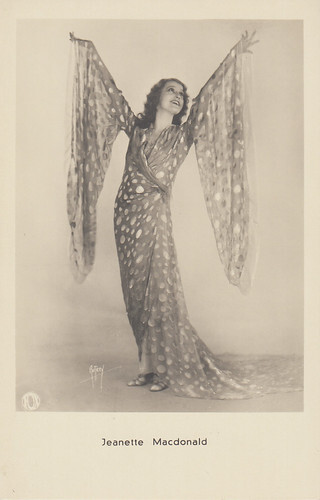
Austrian postcard by Iris Verlag, no. 6442. Photo: Max Munn Autrey / Fox. Jeanette MacDonald in Oh, for a Man! (Hamilton MacFadden, 1930).
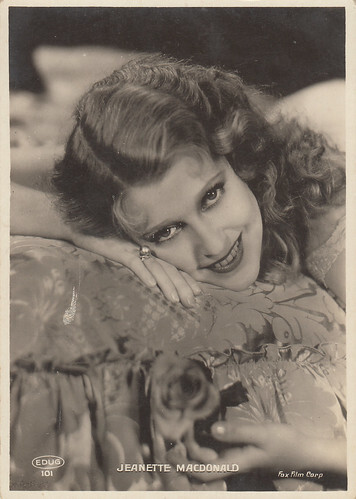
French postcard by EDUG, no. 101. Photo: Fox Film Corp.
Her stage career in the 20s
In 1919, Jeanette MacDonald reappeared on stage in New York in the chorus of the 'Demi-Tasse Revue'. Over the years, she worked her way up.
The Broadway revue 'A Fantastic Fricassee' got her to be favourably mentioned in the famous Billboard magazine in November 1922. When she played the second lead in 'The Magic Ring' (1923), she was noticed by the New York press. After its Broadway run, she successfully toured with it.
The following years, she continued her upward climb. She got her first full-fledged leading role in 1926 in 'Yes, Yes Yvette', a follow-up to the popular 'No, No Nanette'. After an extensive and successful U.S. tour, which began in December 1926, it unfortunately flopped on Broadway at the end of 1927, where it only lasted 40 performances. After it had closed down, she signed in November 1927 with the famous Shubert Brothers.
They first cast her in 'The Studio Girl', which was a failure and never made it to Broadway. She then starred in 'Sunny Days', which enjoyed a moderate Broadway success with a respectable run from February to May 1928. Her last two Broadway musicals for the Shuberts, 'Angela' (1928-1929) and 'Boom-Boom' (1929) didn’t draw large crowds.
Jeanette MacDonald never quite reached the first rank of Broadway stars. However, at the end of the 1920s, she had made a name for herself, was well-paid, usually received good reviews and was regarded as a pretty, talented and seasoned performer. It was only natural for Hollywood to take interest in her.
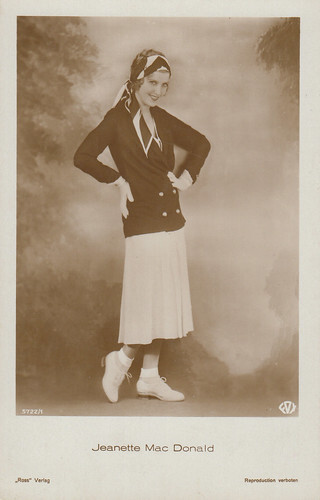
German postcard by Ross Verlag, no. 5722/1, 1930-1931. Jeanette MacDonald in Don’t Bet on Women (William K. Howard, 1930).
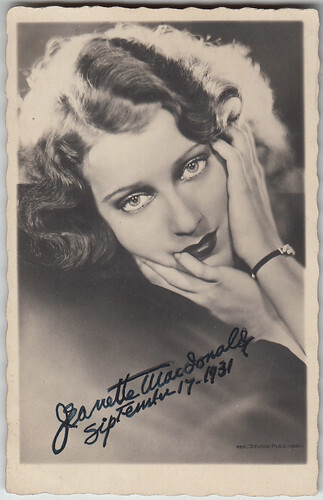
French autographed postcard by Studio Piaz. Autographed in September 1931, during her first European tour.
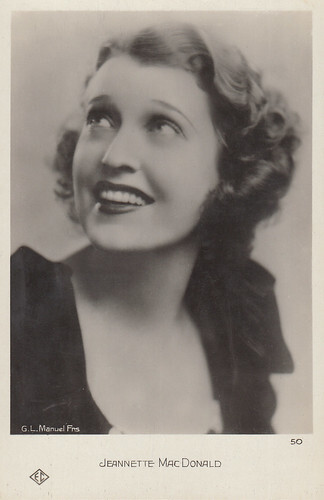
French postcard by E.C., no. 50. Photo: G.L. Manuel Frères.
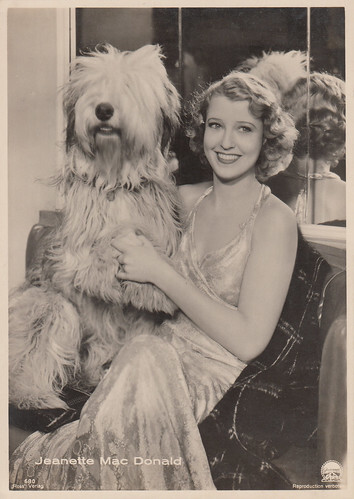
German postcard by Ross Verlag, no. 680. Photo: Paramount.
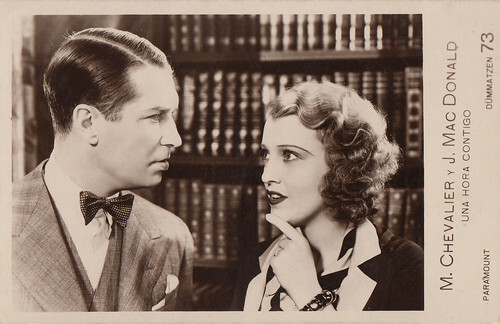
Spanish postcard by Dümmatzen, no. 73. Photo: Paramount, Jeanette MacDonald and Maurice Chevalier in One Hour with You (George Cukor, Ernst Lubitsch, 1932).
First years in Hollywood
In 1928, Jeanette MacDonald was screen-tested by Paramount, which had her in mind for a role opposite Richard Dix in Nothing But the Truth. She made a favourable impression but The Shubert Brothers didn’t allow her to sign a movie contract.
In 1929, she allegedly made a second screen-test, this time for Fox. Her partner was then a young actor named Archie Leach, who had a small role in the aforementioned 'Boom-Boom'. But Fox considered that neither of the two had a screen personality. It was a big mistake on their part as Jeanette soon made it in Hollywood and Archie Leach would later become famous as Cary Grant .
She got her big break when Ernst Lubitsch , who was searching for a leading lady for Maurice Chevalier in the upcoming The Love Parade , saw her 1928 Paramount test and decided that she would be perfect for the role. So, after she had left the Shuberts, she signed with Paramount. The Love Parade (1929) was a success and made her a star. It was followed by The Vagabond King (1930), which was a bit disappointing at the box office. She then signed a one-picture deal with United Artists but The Lottery Bride (1930) was a failure.
At Paramount, she was in Let’s Go Native (1930), before Ernst Lubitsch directed her again in Monte Carlo (1930), which brought her good notices. But U.S. audiences didn’t warm to Monte Carlo’s male star, Jack Buchanan , who had been imported from England. She then signed a three-picture deal with Fox, with only so-so results. She first played in Oh, for a Man! (1930) and, as musicals had gone out of vogue at the time, she then appeared in two films in which she didn’t sing, Don’t Bet on Women (1931) and Annabelle’s Affairs (1931).
Fortunately, after a successful series of recitals in France and England, she was back at Paramount and reunited with Maurice Chevalier in two classics: Ernst Lubitsch ’s One Hour with You (1932), which was also filmed in French as Une heure près de toi, and Rouben Mamoulian’s Love Me Tonight (1932). Those films made better business abroad than at home, as U.S. small-city moviegoers found them too sophisticated for their taste. With no more film offers in sight, she again decided to go on tour in France, Belgium, Netherlands and Switzerland.
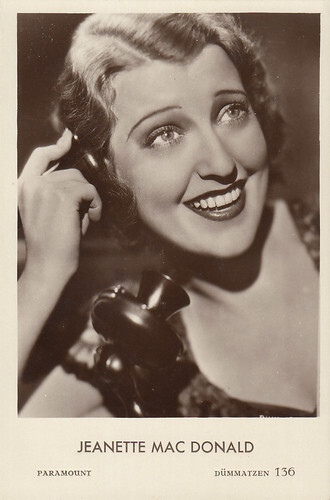
Spanish postcard by Dümmatzen, no. 136. Photo: Paramount.
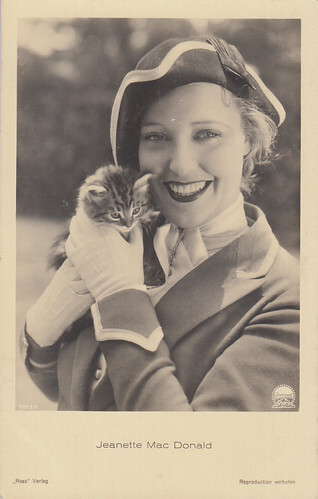
German postcard by Ross Verlag, no. 7213/1, 1932-1933. Photo: Paramount. Jeanette MacDonald in Love Me Tonight (Rouben Mamoulian, 1932).
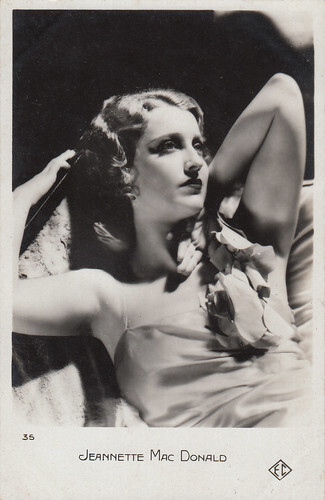
French postcard by E.C., no. 35.
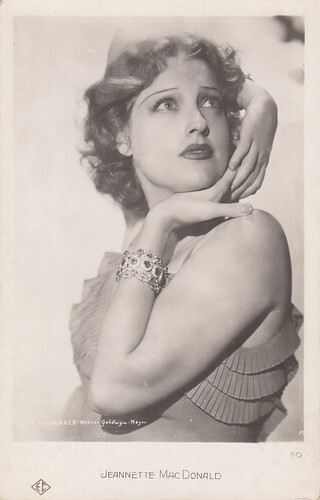
French postcard by E.C., no. 50. Photo: Metro-Goldwyn-Mayer.
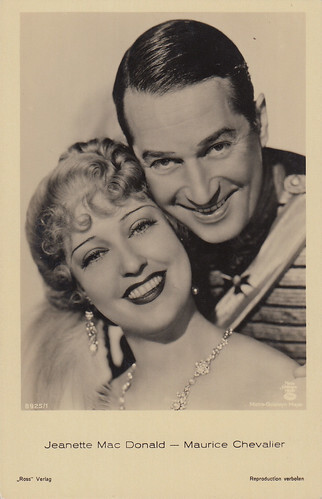
German postcard by Ross Verlag, no. 8925/1, 1933-1934. Photo: Metro-Goldwyn-Mayer. Jeanette MacDonald and Maurice Chevalier in The Merry Widow (Ernst Lubitsch, 1934).
M.G.M.’s bright star
In 1933, M.G.M. signed her. Her first movie for them, The Cat and the Fiddle (1934), co-starring Ramon Novarro , didn’t reach the box office heights. Ernst Lubitsch ’s prestigious The Merry Widow (1934) co-starred her with Maurice Chevalier for the last time. The two stars also appeared in the French-language version, La veuve joyeuse. The Merry Widow was especially very popular in Europe and in South America. In the U.S., it chiefly pleased refined audiences from urban areas. Because of its huge production costs, it finished in the red for M.G.M.
It soon occured to Louis B. Mayer that Jeanette had more box-office clout in U.S. big cities and in foreign countries. So, he decided it was time to give her a warmer and less sophisticated image, which would appeal to small-town America. To achieve his goal, he convinced her to star in a film version of the popular Victor Herbert’s operetta 'Naughty Marietta', in which her leading man was a tenor M.G.M. had under contract since 1933, Nelson Eddy. It paid off, as Naughty Marietta (1935) was a massive hit.
Then, MacDonald and Eddy were reunited in Rose Marie (1936), which was an even greater success. The pair’s box-office appeal skyrocketed. Unwilling to be seen only as part of a team, she co-starred with Clark Gable and Spencer Tracy in San Francisco (1936), which became M.G.M.’s greatest moneymaker before Gone with the Wind was released in 1939.
She was back with Nelson Eddy in the very successful Maytime (1937) before co-starring with tenor Allan Jones in The Firefly (1937). Having noticed that The Firefly had made less profit than her three movies with Eddy, Louis B. Mayer again cast the duo in The Girl of the Golden West (1938) and Sweethearts (1938), which were crowd-pleasers. Next came Broadway Serenade (1939), opposite Lew Ayres , which didn’t appeal to audiences.
Afterwards, MacDonald and Eddy were paired in New Moon (1940), which did very good business, and in Bitter Sweet (1940), which author Noël Coward hated. After that, she played with Brian Aherne and with her husband, Gene Raymond, in Smilin’ Through (1940), which made more money abroad than in the U.S. Her last film with Nelson Eddy, I Married an Angel (1942), was a flop. She eventually appeared in a less expensive film than usual, Cairo (1942), but it didn’t turn into a profit. M.G.M didn’t pick up its option on Jeanette and let her go.
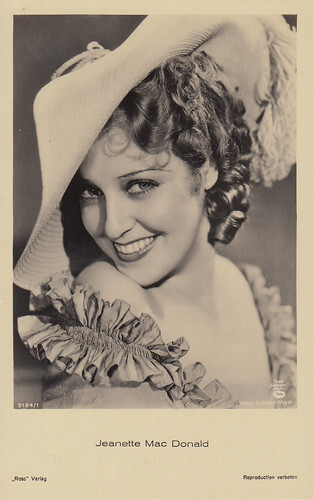
German postcard by Ross Verlag, no. 9184/1, 1935-1936. Photo: Metro-Goldwyn-Mayer. Jeanette MacDonald in Naughty Marietta (Robert Z. Leonard, W.S. Van Dyke, 1935).
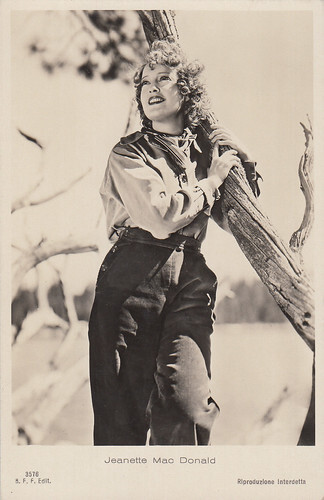
Italian postcard by Ballerini & Fratini, Firenze, no. 3576. Photo: Metro-Goldwyn-Mayer. Jeanette MacDonald in Rose-Marie (W.S. Van Dyke, 1936).
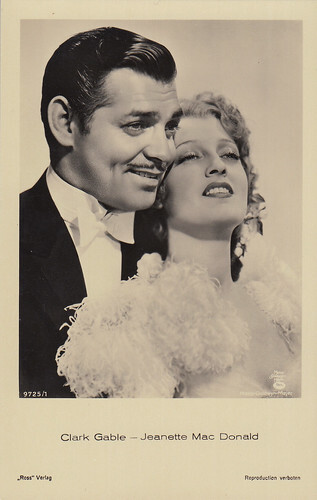
German postcard by Ross Verlag, no. 9725/1, 1935-1936. Photo: Metro-Goldwyn-Mayer. Jeanette MacDonald and Clark Gable in San Francisco (W.S. Van Dyke, 1936).
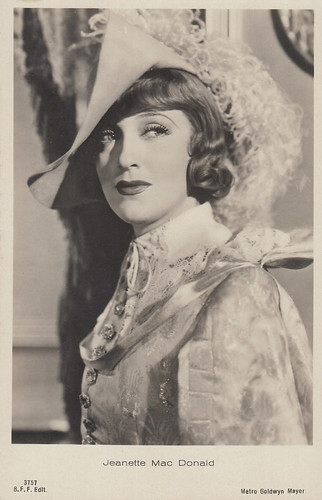
Italian postcard by Ballerini & Fratini, Firenze, no. 3757. Photo: Metro-Goldwyn-Mayer. Jeanette MacDonald in Maytime (Robert Z. Leonard, 1937).
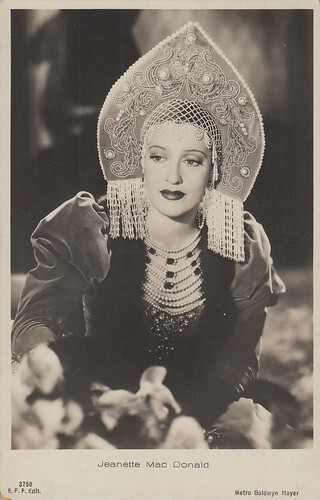
Italian postcard by Ballerini & Fratini, Firenze, no. 3758. Photo: Metro-Goldwyn-Mayer. Jeanette MacDonald in Maytime (Robert Z. Leonard, 1937).
Her last films, live appearances, radio and television
In 1944, Jeanette MacDonald sang the standards 'Beyond the Blue Horizon' and 'I’ll See you in My Dreams' in the star-studded Follow the Boys, a wartime morale booster produced by Universal. A few years later, producer Joe Pasternak enticed her to come back at M.G.M. for the musical Three Daring Daughters (1948). Audiences liked it but it had been such a costly production that, in the end, there was no financial gain for M.G.M. Her filmography ended with playing a widowed concert singer in The Sun Comes Up (1949), in which she shared the spotlight with child actor Claude Jarman Jr. and Lassie the Dog.
Since her last European tour in 1933, Jeanette had focused on her film career. At the end of the 1930s, she decided it was time to perform again in front of live audiences. So, from 1939 to the end of the 1950s, she toured in live concerts all around the U.S.A. She even tried her hand at opera in two Charles Gounod’s works. She sang 'Roméo et Juliette' in several Canadian cities in 1943, in Chicago and Milwaukee in 1944 and in Cincinnati in 1945 and 'Faust' in Chicago in 1944 and 1945, in Cincinnati in 1945 and in Philadelphia in 1951.
More surprisingly, she had her own nightclub act in Las Vegas at the Sahara in 1953 and 1957 and at the Sands in 1953, and in Los Angeles at the Cocoanut Grove in 1954.In 1951, she went on a four-month tour with Gene Raymond, in a revival of Ferenc Molnar’s 'The Guardsman', but it closed before reaching Broadway. She was also featured in summer stock productions of 'Bitter Sweet' in 1954, 1955 and 1959 and 'The King and I' in 1956.
Jeanette considered that radio greatly furthered people’s access to music and she had her own weekly show on CBS, Vicks Open House, from September 1937 to March 1938. In 1950, she made her television debut in the musical program The Voice of Firestone. It was followed by other appearances in, for example, Ed Sullivan’s Toast of the Town in 1951 or The Jackie Gleason Show in 1953.
In 1957, Jeanette and Nelson Eddy sang a medley of songs in Patti Paige’s TV show The Big Record. The positive reception from the public prompted RCA record company to sign the duo for an album. Their LP, which mostly consisted of new recordings of standards from their films, was released in 1959 and went gold.
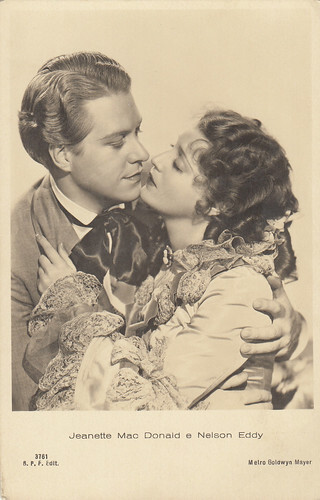
Italian postcard by Ballerini & Fratini, Firenze, no. 3761. Photo: Metro Goldwyn Mayer. Jeanette MacDonald and Nelson Eddy in Maytime (Robert Z. Leonard, 1937).
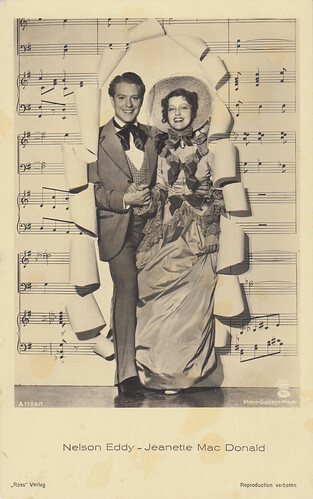
German postcard by Ross Verlag, no. A 1106/1, 1937-1938. Photo: Metro Goldwyn Mayer. Jeanette MacDonald and Nelson Eddy in Maytime (Robert Z. Leonard, 1937).
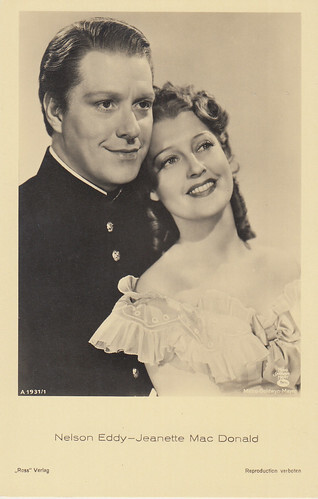
German postcard by Ross Verlag, no. A 1931/1, 1937-1938. Photo: Metro Goldwyn Mayer. Jeanette MacDonald and Nelson Eddy in The Girl of the Golden West (Robert Z. Leonard, 1938).
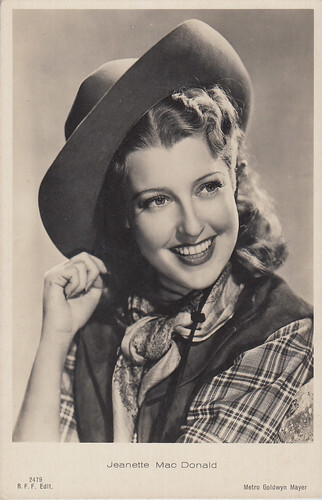
Italian postcard by Ballerini & Fratini, Firenze, no. 3576. Photo: Metro Goldwyn Mayer. Jeanette MacDonald in The Girl of the Golden West (Robert Z. Leonard, 1938).
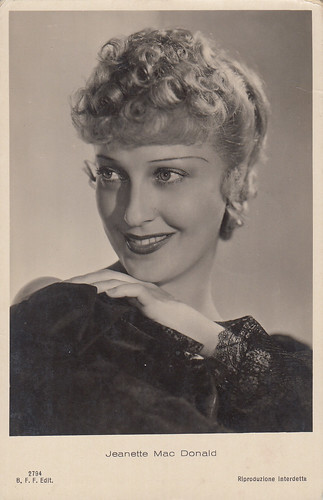
Italian postcard by Ballerini & Fratini, Firenze, no. 2794. Photo: Metro Goldwyn Mayer.
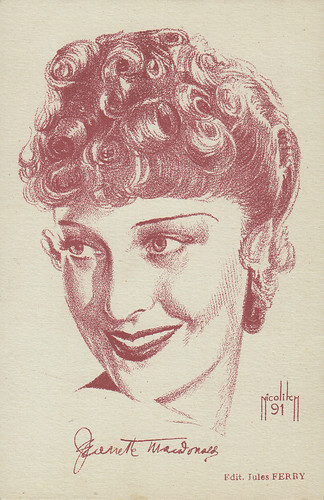
French postcard by Editions Jules Ferry, no. 91.
Her private life
Jeanette MacDonald’s first serious suitor was Jack Ohmeis, who came from a wealthy family and to whom she was engaged for some time in the 192’s. In 1928, she embarked into a romance with Robert Ritchie, who acted as her manager, which lasted until the mid-1930s.
In 1935, she began dating actor Gene Raymond and they married in June 1937.
The first half of the 1960s saw MacDonald been plagued with health problems and she passed away on the 14th of January 1965.
According to some sources, especially the 1994 book 'Sweethearts', Jeanette MacDonald and Nelson Eddy would have had a long on-and-off love affair for many years, before and after their respective marriages. She even would have been pregnant several times from Eddy, but would have miscarried.
Those assertions have stirred up controversy and are far from eliciting unanimity among fans and biographers. Are they utter nonsense and pure fantasy? We’ll let you form your own opinion.
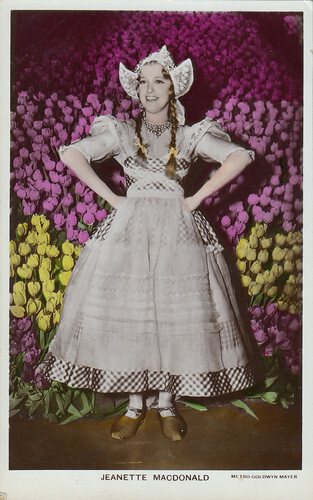
British postcard in the Colourgraph Series, London, no. C265a. Photo: Metro Goldwyn Mayer. Jeanette MacDonald in Sweethearts (W.S. Van Dyke, Robert Z. Leonard, 1938).
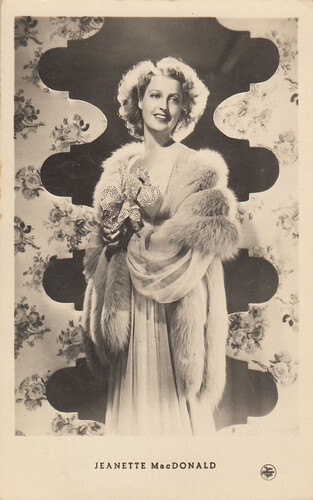
Spanish postcard. Photo: Metro Goldwyn Mayer.
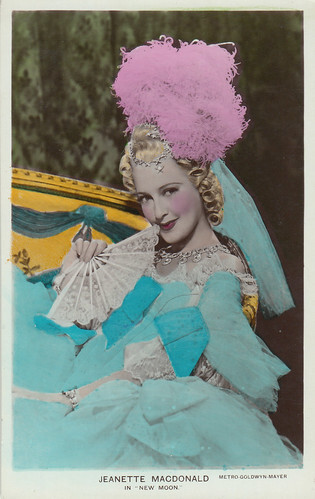
British postcard in the Colourgraph Series, London, no. C395. Photo: Metro Goldwyn Mayer. Jeanette MacDonald in New Moon (Robert Z. Leonard, W.S. Van Dyke, 1940).
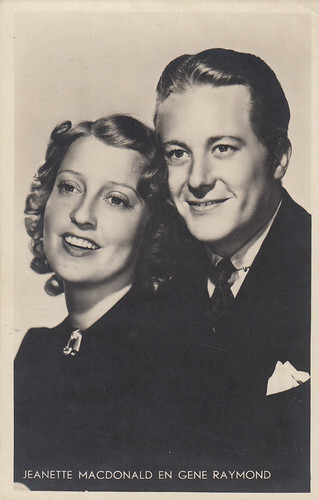
Dutch postcard by S. & v. H. A. Photo: Metro Goldwyn Mayer. Jeanette MacDonald and Gene Raymond.
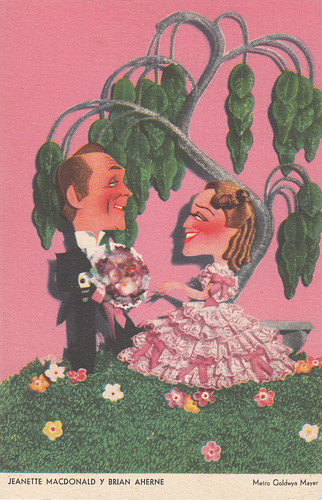
Spanish postcard by I.G. Viladot S/L, Barcelona. Caricature by Jacques Kapralik / Metro Goldwyn Mayer. Jeanette MacDonald and Brian Aherne .
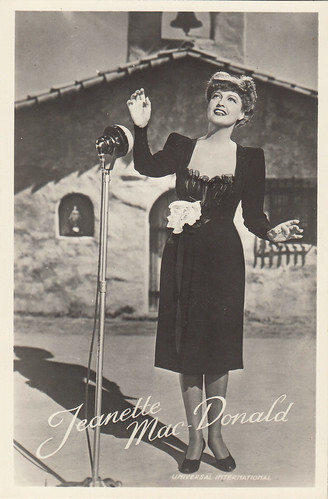
Dutch postcard no. 3214. Photo: Universal International. Jeanette MacDonald in Follow the Boys (A. Edward Sutherland, John Rawlins, 1944).
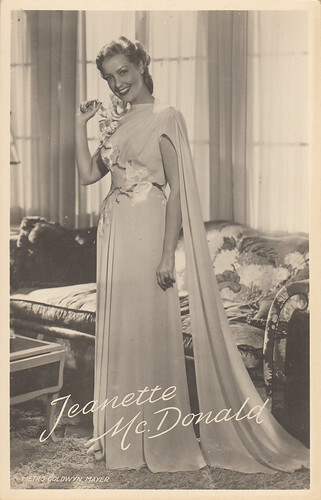
Dutch postcard by Foto Archief Film en Toneel, no. 3460. Photo: Metro Goldwyn Mayer. Jeanette MacDonald in Three Daring Daughters (Fred M. Wilcox, 1948).
Text and postcards: Marlene Pilaete.
Jeanette was a consumate and mindful professional who always tried to give her adoring and loyal fans an access to an operatic repertoire which was mostly associated until then with a social elite. It was not unusual for her to include famous arias from Gounod, Puccini, Verdi, Bizet, Donizetti, etc. in her films and her recitals. She handled her business arrangements with skill and determination and was no slouch when it came to the technical aspects of filming. In Hollywood, she was going to be known as 'The Iron Butterfly'.

Spanish postcard, no. 4. Jeanette MacDonald in The Love Parade (Ernst Lubitsch, 1929).

French postcard by Europe, no. 786. Photo: Films Paramount.

Spanish postcard by MC, Barcelona, no. 170.

Spanish postcard by MC, Barcelona, no. 212.

Belgian postcard. Photo: Films Paramount. Jeanette MacDonald and Dennis King in The Vagabond King (Ludwig Berger, 1930).
A musical childhood
Jeanette MacDonald was born as Jeannette Anna McDonald on the 18th of June 1903 in Philadelphia, Pennsylvania, U.S.A. Later, she dropped one of the n’s from her first name and add an a to her surname.
She made her first public appearance, singing a religious hymn, at the age of three at a Presbyterian Church.
On the 19th of February 1909, she had three solo spots in 'Charity', a children’s opera written for a benefit performance, at the Philadelphia Academy of Music. It earned her her first favourable reviews in the local press.
From 1911 to 1913, she performed in Vaudeville with five other children in a kiddie act, 'The Six Sunny Song Birds'. She then joined 'The Seven Merry Yougsters' in 1914.
But the 'Gerry Society of New York City', which protected children from commercial exploitation, soon sued Jeanette’s parents. As a result, she had to go back to school and to momentarily put her stage ambitions aside.

French postcard by Cinémagazine, no. 865.

French postcard by Cinémagazine, no. 895.

French postcard by A.N., Paris, no. 558. Photo: Paramount. Jeanette MacDonald in Let’s Go Native (Leo McCarey, 1930).

Austrian postcard by Iris Verlag, no. 6442. Photo: Max Munn Autrey / Fox. Jeanette MacDonald in Oh, for a Man! (Hamilton MacFadden, 1930).

French postcard by EDUG, no. 101. Photo: Fox Film Corp.
Her stage career in the 20s
In 1919, Jeanette MacDonald reappeared on stage in New York in the chorus of the 'Demi-Tasse Revue'. Over the years, she worked her way up.
The Broadway revue 'A Fantastic Fricassee' got her to be favourably mentioned in the famous Billboard magazine in November 1922. When she played the second lead in 'The Magic Ring' (1923), she was noticed by the New York press. After its Broadway run, she successfully toured with it.
The following years, she continued her upward climb. She got her first full-fledged leading role in 1926 in 'Yes, Yes Yvette', a follow-up to the popular 'No, No Nanette'. After an extensive and successful U.S. tour, which began in December 1926, it unfortunately flopped on Broadway at the end of 1927, where it only lasted 40 performances. After it had closed down, she signed in November 1927 with the famous Shubert Brothers.
They first cast her in 'The Studio Girl', which was a failure and never made it to Broadway. She then starred in 'Sunny Days', which enjoyed a moderate Broadway success with a respectable run from February to May 1928. Her last two Broadway musicals for the Shuberts, 'Angela' (1928-1929) and 'Boom-Boom' (1929) didn’t draw large crowds.
Jeanette MacDonald never quite reached the first rank of Broadway stars. However, at the end of the 1920s, she had made a name for herself, was well-paid, usually received good reviews and was regarded as a pretty, talented and seasoned performer. It was only natural for Hollywood to take interest in her.

German postcard by Ross Verlag, no. 5722/1, 1930-1931. Jeanette MacDonald in Don’t Bet on Women (William K. Howard, 1930).

French autographed postcard by Studio Piaz. Autographed in September 1931, during her first European tour.

French postcard by E.C., no. 50. Photo: G.L. Manuel Frères.

German postcard by Ross Verlag, no. 680. Photo: Paramount.

Spanish postcard by Dümmatzen, no. 73. Photo: Paramount, Jeanette MacDonald and Maurice Chevalier in One Hour with You (George Cukor, Ernst Lubitsch, 1932).
First years in Hollywood
In 1928, Jeanette MacDonald was screen-tested by Paramount, which had her in mind for a role opposite Richard Dix in Nothing But the Truth. She made a favourable impression but The Shubert Brothers didn’t allow her to sign a movie contract.
In 1929, she allegedly made a second screen-test, this time for Fox. Her partner was then a young actor named Archie Leach, who had a small role in the aforementioned 'Boom-Boom'. But Fox considered that neither of the two had a screen personality. It was a big mistake on their part as Jeanette soon made it in Hollywood and Archie Leach would later become famous as Cary Grant .
She got her big break when Ernst Lubitsch , who was searching for a leading lady for Maurice Chevalier in the upcoming The Love Parade , saw her 1928 Paramount test and decided that she would be perfect for the role. So, after she had left the Shuberts, she signed with Paramount. The Love Parade (1929) was a success and made her a star. It was followed by The Vagabond King (1930), which was a bit disappointing at the box office. She then signed a one-picture deal with United Artists but The Lottery Bride (1930) was a failure.
At Paramount, she was in Let’s Go Native (1930), before Ernst Lubitsch directed her again in Monte Carlo (1930), which brought her good notices. But U.S. audiences didn’t warm to Monte Carlo’s male star, Jack Buchanan , who had been imported from England. She then signed a three-picture deal with Fox, with only so-so results. She first played in Oh, for a Man! (1930) and, as musicals had gone out of vogue at the time, she then appeared in two films in which she didn’t sing, Don’t Bet on Women (1931) and Annabelle’s Affairs (1931).
Fortunately, after a successful series of recitals in France and England, she was back at Paramount and reunited with Maurice Chevalier in two classics: Ernst Lubitsch ’s One Hour with You (1932), which was also filmed in French as Une heure près de toi, and Rouben Mamoulian’s Love Me Tonight (1932). Those films made better business abroad than at home, as U.S. small-city moviegoers found them too sophisticated for their taste. With no more film offers in sight, she again decided to go on tour in France, Belgium, Netherlands and Switzerland.

Spanish postcard by Dümmatzen, no. 136. Photo: Paramount.

German postcard by Ross Verlag, no. 7213/1, 1932-1933. Photo: Paramount. Jeanette MacDonald in Love Me Tonight (Rouben Mamoulian, 1932).

French postcard by E.C., no. 35.

French postcard by E.C., no. 50. Photo: Metro-Goldwyn-Mayer.

German postcard by Ross Verlag, no. 8925/1, 1933-1934. Photo: Metro-Goldwyn-Mayer. Jeanette MacDonald and Maurice Chevalier in The Merry Widow (Ernst Lubitsch, 1934).
M.G.M.’s bright star
In 1933, M.G.M. signed her. Her first movie for them, The Cat and the Fiddle (1934), co-starring Ramon Novarro , didn’t reach the box office heights. Ernst Lubitsch ’s prestigious The Merry Widow (1934) co-starred her with Maurice Chevalier for the last time. The two stars also appeared in the French-language version, La veuve joyeuse. The Merry Widow was especially very popular in Europe and in South America. In the U.S., it chiefly pleased refined audiences from urban areas. Because of its huge production costs, it finished in the red for M.G.M.
It soon occured to Louis B. Mayer that Jeanette had more box-office clout in U.S. big cities and in foreign countries. So, he decided it was time to give her a warmer and less sophisticated image, which would appeal to small-town America. To achieve his goal, he convinced her to star in a film version of the popular Victor Herbert’s operetta 'Naughty Marietta', in which her leading man was a tenor M.G.M. had under contract since 1933, Nelson Eddy. It paid off, as Naughty Marietta (1935) was a massive hit.
Then, MacDonald and Eddy were reunited in Rose Marie (1936), which was an even greater success. The pair’s box-office appeal skyrocketed. Unwilling to be seen only as part of a team, she co-starred with Clark Gable and Spencer Tracy in San Francisco (1936), which became M.G.M.’s greatest moneymaker before Gone with the Wind was released in 1939.
She was back with Nelson Eddy in the very successful Maytime (1937) before co-starring with tenor Allan Jones in The Firefly (1937). Having noticed that The Firefly had made less profit than her three movies with Eddy, Louis B. Mayer again cast the duo in The Girl of the Golden West (1938) and Sweethearts (1938), which were crowd-pleasers. Next came Broadway Serenade (1939), opposite Lew Ayres , which didn’t appeal to audiences.
Afterwards, MacDonald and Eddy were paired in New Moon (1940), which did very good business, and in Bitter Sweet (1940), which author Noël Coward hated. After that, she played with Brian Aherne and with her husband, Gene Raymond, in Smilin’ Through (1940), which made more money abroad than in the U.S. Her last film with Nelson Eddy, I Married an Angel (1942), was a flop. She eventually appeared in a less expensive film than usual, Cairo (1942), but it didn’t turn into a profit. M.G.M didn’t pick up its option on Jeanette and let her go.

German postcard by Ross Verlag, no. 9184/1, 1935-1936. Photo: Metro-Goldwyn-Mayer. Jeanette MacDonald in Naughty Marietta (Robert Z. Leonard, W.S. Van Dyke, 1935).

Italian postcard by Ballerini & Fratini, Firenze, no. 3576. Photo: Metro-Goldwyn-Mayer. Jeanette MacDonald in Rose-Marie (W.S. Van Dyke, 1936).

German postcard by Ross Verlag, no. 9725/1, 1935-1936. Photo: Metro-Goldwyn-Mayer. Jeanette MacDonald and Clark Gable in San Francisco (W.S. Van Dyke, 1936).

Italian postcard by Ballerini & Fratini, Firenze, no. 3757. Photo: Metro-Goldwyn-Mayer. Jeanette MacDonald in Maytime (Robert Z. Leonard, 1937).

Italian postcard by Ballerini & Fratini, Firenze, no. 3758. Photo: Metro-Goldwyn-Mayer. Jeanette MacDonald in Maytime (Robert Z. Leonard, 1937).
Her last films, live appearances, radio and television
In 1944, Jeanette MacDonald sang the standards 'Beyond the Blue Horizon' and 'I’ll See you in My Dreams' in the star-studded Follow the Boys, a wartime morale booster produced by Universal. A few years later, producer Joe Pasternak enticed her to come back at M.G.M. for the musical Three Daring Daughters (1948). Audiences liked it but it had been such a costly production that, in the end, there was no financial gain for M.G.M. Her filmography ended with playing a widowed concert singer in The Sun Comes Up (1949), in which she shared the spotlight with child actor Claude Jarman Jr. and Lassie the Dog.
Since her last European tour in 1933, Jeanette had focused on her film career. At the end of the 1930s, she decided it was time to perform again in front of live audiences. So, from 1939 to the end of the 1950s, she toured in live concerts all around the U.S.A. She even tried her hand at opera in two Charles Gounod’s works. She sang 'Roméo et Juliette' in several Canadian cities in 1943, in Chicago and Milwaukee in 1944 and in Cincinnati in 1945 and 'Faust' in Chicago in 1944 and 1945, in Cincinnati in 1945 and in Philadelphia in 1951.
More surprisingly, she had her own nightclub act in Las Vegas at the Sahara in 1953 and 1957 and at the Sands in 1953, and in Los Angeles at the Cocoanut Grove in 1954.In 1951, she went on a four-month tour with Gene Raymond, in a revival of Ferenc Molnar’s 'The Guardsman', but it closed before reaching Broadway. She was also featured in summer stock productions of 'Bitter Sweet' in 1954, 1955 and 1959 and 'The King and I' in 1956.
Jeanette considered that radio greatly furthered people’s access to music and she had her own weekly show on CBS, Vicks Open House, from September 1937 to March 1938. In 1950, she made her television debut in the musical program The Voice of Firestone. It was followed by other appearances in, for example, Ed Sullivan’s Toast of the Town in 1951 or The Jackie Gleason Show in 1953.
In 1957, Jeanette and Nelson Eddy sang a medley of songs in Patti Paige’s TV show The Big Record. The positive reception from the public prompted RCA record company to sign the duo for an album. Their LP, which mostly consisted of new recordings of standards from their films, was released in 1959 and went gold.

Italian postcard by Ballerini & Fratini, Firenze, no. 3761. Photo: Metro Goldwyn Mayer. Jeanette MacDonald and Nelson Eddy in Maytime (Robert Z. Leonard, 1937).

German postcard by Ross Verlag, no. A 1106/1, 1937-1938. Photo: Metro Goldwyn Mayer. Jeanette MacDonald and Nelson Eddy in Maytime (Robert Z. Leonard, 1937).

German postcard by Ross Verlag, no. A 1931/1, 1937-1938. Photo: Metro Goldwyn Mayer. Jeanette MacDonald and Nelson Eddy in The Girl of the Golden West (Robert Z. Leonard, 1938).

Italian postcard by Ballerini & Fratini, Firenze, no. 3576. Photo: Metro Goldwyn Mayer. Jeanette MacDonald in The Girl of the Golden West (Robert Z. Leonard, 1938).

Italian postcard by Ballerini & Fratini, Firenze, no. 2794. Photo: Metro Goldwyn Mayer.

French postcard by Editions Jules Ferry, no. 91.
Her private life
Jeanette MacDonald’s first serious suitor was Jack Ohmeis, who came from a wealthy family and to whom she was engaged for some time in the 192’s. In 1928, she embarked into a romance with Robert Ritchie, who acted as her manager, which lasted until the mid-1930s.
In 1935, she began dating actor Gene Raymond and they married in June 1937.
The first half of the 1960s saw MacDonald been plagued with health problems and she passed away on the 14th of January 1965.
According to some sources, especially the 1994 book 'Sweethearts', Jeanette MacDonald and Nelson Eddy would have had a long on-and-off love affair for many years, before and after their respective marriages. She even would have been pregnant several times from Eddy, but would have miscarried.
Those assertions have stirred up controversy and are far from eliciting unanimity among fans and biographers. Are they utter nonsense and pure fantasy? We’ll let you form your own opinion.

British postcard in the Colourgraph Series, London, no. C265a. Photo: Metro Goldwyn Mayer. Jeanette MacDonald in Sweethearts (W.S. Van Dyke, Robert Z. Leonard, 1938).

Spanish postcard. Photo: Metro Goldwyn Mayer.

British postcard in the Colourgraph Series, London, no. C395. Photo: Metro Goldwyn Mayer. Jeanette MacDonald in New Moon (Robert Z. Leonard, W.S. Van Dyke, 1940).

Dutch postcard by S. & v. H. A. Photo: Metro Goldwyn Mayer. Jeanette MacDonald and Gene Raymond.

Spanish postcard by I.G. Viladot S/L, Barcelona. Caricature by Jacques Kapralik / Metro Goldwyn Mayer. Jeanette MacDonald and Brian Aherne .

Dutch postcard no. 3214. Photo: Universal International. Jeanette MacDonald in Follow the Boys (A. Edward Sutherland, John Rawlins, 1944).

Dutch postcard by Foto Archief Film en Toneel, no. 3460. Photo: Metro Goldwyn Mayer. Jeanette MacDonald in Three Daring Daughters (Fred M. Wilcox, 1948).
Text and postcards: Marlene Pilaete.
Published on March 29, 2024 23:00
March 28, 2024
Peau d'âne (1970)
Jacques Demy's colourful musical Peau d'âne/Donkey Skin (1970) is a combination of Jean Cocteau's classic La Belle et la Bête/Beauty and the Beast (1946) and Disney's Cinderella (1950) with music composed by Michel Legrand. Demy retells a strange and complex fairy tale of a princess who disguises herself in a donkey skin and flees the kingdom so she won't have to marry the king who happens to be her father. Jacques Demy loved fairy tales since his childhood, and with Peau d'âne/Donkey Skin, he finally succeeded in adapting one and made his greatest film.
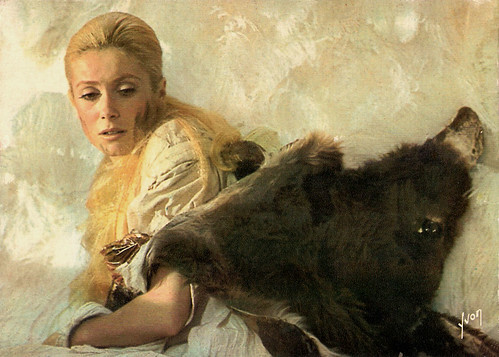
French postcard by Editions d'art Yvon, Paris, no. 40-110-07. Photo: Parc Film / KIM. Catherine Deneuve in Peau d'âne (Jacques Demy, 1970). Caption: The princess receives the donkey skin.
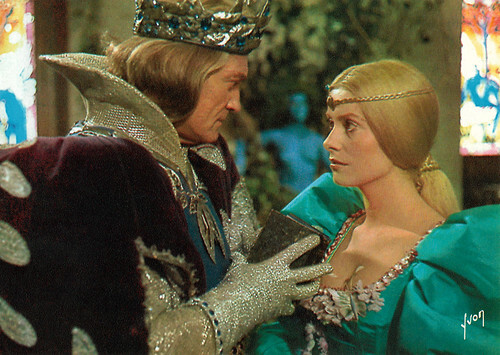
French postcard by Editions d'art Yvon, Paris, no. 40-110-02. Photo: Parc Film / KIM. Jean Marais and Catherine Deneuve in Peau d'âne/Donkey Skin (Jacques Demy, 1970). Caption: Peau d'âne (Donkey Skin), a tale by Charles Perrault, a film by Jacques Demy. The Princess asks the King, her father, for a moon-coloured dress.
He declares that he will marry the woman whose finger fits the ring
'Peau d'âne' is a beloved French fairy tale by Charles Perrault from 1695. The tale had only been adapted for the big screen once, in 1908 by Albert Capellani. This short black-and-white silent film was based on a stage version of the fairy tale first performed in 1838 at the Porte-Saint-Martin theatre. The authors, Émile Vanderburch and Laurencin, had modified the plot and left the incest dimension out: in their version the princess had to wear a donkey skin as a punishment for her coquettishness and no longer to escape her father's eyes. Throughout the nineteenth century, this play was a great popular success in France.
In Jacques Demy's version, Peau d'âne/Doney Skin (1970), a king ( Jean Marais ) and queen ( Catherine Deneuve ) live happily until her sudden death. The dying queen makes her husband promise that his next wife will be as beautiful as she. The king decides to marry his own graceful and charming daughter (also Catherine Deneuve ). She's willing, but her fairy godmother, Lily Fairy (Delphine Seyrig) serves as a social conscience, intent on thwarting incest.
Lily instructs the princess to request a series of dresses impossible to make. However, the king's tailor succeeds. So the fairy plots the princess's escape, wearing the skin of the king's prize donkey. The Princess goes to another kingdom and everyone seems to think she's an ugly scullery maid. Her disguise arouses hostility, but she manages to keep her secret.
In the woods, she has a chance encounter with the wandering prince of a neighbouring castle. Prince Charming ( Jacques Perrin ) sees who she really is and is smitten. Love-struck, he retires to his sickbed and asks that Donkey Skin be instructed to bake him a cake to restore him to health. In the cake, he finds a ring that the princess has placed there and is thus sure that his love for her is reciprocated. He declares that he will marry the woman whose finger fits the ring.
All the women of marriageable age assemble at the prince's castle and try on the ring one by one, in order of social status. Last of all is the lowly Donkey Skin, who is revealed to be the princess when the ring fits her finger. At the wedding of the prince and the princess, the lilac fairy and the king arrive by helicopter and declare that they too are to be married.
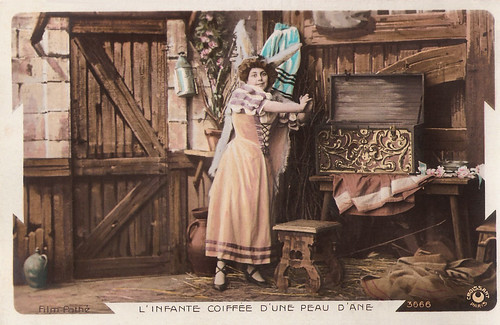
French postcard by Croissant, Paris, no. 3666. Photo: Film Pathé. Publicity still for Peau d'âne/Donkey Skin (Albert Capellani, 1908). Caption L'infante coiffée d'une peau d'âne (The princess wears a donkey skin). The actress is unknown.
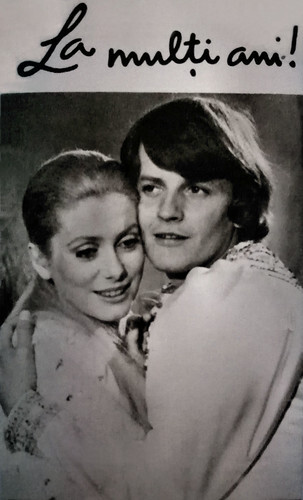
Romanian calendar card by Casa Filmui Acin, 1973. Catherine Deneuve and Jacques Perrin in Peau d'âne/Donkey Skin (Jacques Demy, 1970). Collection: Alina Deaconu.
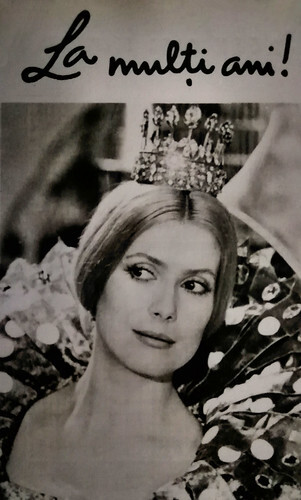
Romanian calendar card by Casa Filmui Acin, 1973. Catherine Deneuve in Peau d'âne/Donkey Skin (Jacques Demy, 1970). Collection: Alina Deaconu.
A certain uninhibited streak, tending to be more daring than traditional French filmmakers
After achieving worldwide success with his third feature, the enchanting musical Les parapluies de Cherbourg/The Umbrellas of Cherbourg (1964), Jacques Demy was courted by Hollywood. He and his wife, fellow director Agnès Varda, spent two years (1967-1969) working in Los Angeles, with each of them making a film there. Demy made Model Shop (1969) with the financial support of Columbia. Although the film was a commercial failure, Demy's American producers offered him the chance to direct a new film in the United States, A Walk in the Spring Rain, starring Ingrid Bergman and Anthony Quinn . Demy eventually gave up his position to Guy Green. He wanted to return to France to make Peau d'âne, which he already had in mind for some time. French producer Mag Bodard had visited him in Hollywood to tell him that she had the financing and that Catherine Deneuve wanted to play the princess.
Peau d'âne/Donkey Skin (1970) became Demy's first film after returning to France. Since childhood, he was fascinated by Charles Perrault's strange and complex fairy tale. As a boy, he had staged puppet shows of all of Perrault's stories. Fairy tales remained a strong presence in his life. Demy wrote a script for a Sleeping Beauty film in the 1950s and ended up putting fairy tale references in both Lola (1961) and Les parapluies de Cherbourg/The Umbrellas of Cherbourg (1964). In 1962 he started working on a script for a film based on the fairy tale 'Peau d'ane'.
Demy considered Brigitte Bardot and the American Anthony Perkins , who filmed a lot in Europe at the time, for the title roles. The two actors agreed to take on the role but the production costs were too high for a director who was almost unknown at the time. The triumph of Les Demoiselles de Rochefort/The Young Girls of Rochefort (1967) changed all that. However, the involvement of his muse Catherine Deneuve was instrumental in securing financing for the production.
Demy's screenplay respected the problematic theme of the original tale, which the director would reuse in his final film, Trois places pour le 26 (1988). Enriched by his American experience, Demy may have developed a certain uninhibited streak, tending to be more daring than traditional French filmmakers. Demy's Peau d'ane invites you to a bizarre and surreal world, full of bold colours, real-life French châteaux, living statues, and fairy magic. The costumes by Italian designer Gitt Magrini are wild and wonderful. The film looks almost like animation coming to life.
Catherine Deneuve is an ideal and delicate princess and Jean Marais is very convincing in his role of tormented and jaded king. It was his final role in the cinema. Marais's casting refers to Jean Cocteau 's fairy tale film La Belle et la Bête/ Beauty and the Beast (Jean Cocteau, René Clément, 1946), in which Marais played the beast. Also, the use of live actors to portray human statues in the castles, and simple special effects such as slow motion and reverse motion were an homage to Cocteau's film. There are other surreal touches in Peau d'âne, such as the king's throne shaped like a giant cat, and the courtiers and horses that are painted blue in the princess's kingdom, and red in the prince's kingdom. Peau d'âne (1970) proved to be Jacques Demy's biggest success in France with a total of 2,198,576 admissions. In France, the film is now considered a cult classic. It was Demy's top box office hit of all his work. Peau d'ane was restored in 2003 and 2014 under the direction of Agnès Varda. The film was also adapted for the stage in 2018 at the Théâtre Marigny
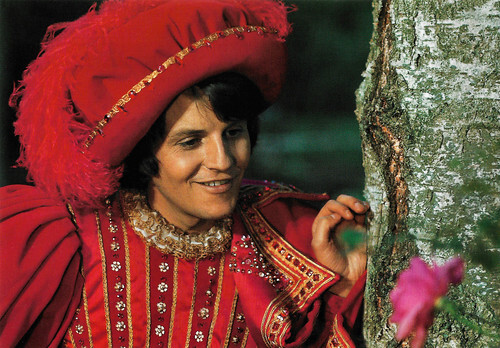
French postcard by Michel Lavoix, 2013. Photo: ciné-tamaris. Jacques Perrin as the Prince in Peau d'âne/Donkey Skin (Jacques Demy, 1970). Caption: The Rose: You were singing about love, are you looking for it? The Prince: Obviously, Rose, like everyone else... The Rose: So keep going, it's a question of trust.
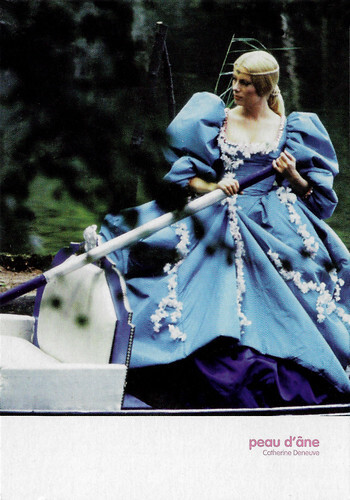
French postcard by Cinetamaris and Arte Video to promote the DVD and CD box 'Intégrale Jacques Demy'. Photo: M.P. Lavoix / Succession Demy. Catherine Deneuve in Peau d'âne/Monkey Skin (Jacques Demy, 1970).

French postcard by Editions d'art Yvon, Paris, no. 40-110-07. Photo: Parc Film / KIM. Micheline Presle and Jacques Perrin in Peau d'âne/Donkey Skin (Jacques Demy, 1970). Caption: Donkey Skin. A Tale by Charles Perrault. A film written and directed by Jacques Demi. My mother, I want Donkey Skin to make me a cake.
Sources: Wikipedia (French and English) and IMDb.

French postcard by Editions d'art Yvon, Paris, no. 40-110-07. Photo: Parc Film / KIM. Catherine Deneuve in Peau d'âne (Jacques Demy, 1970). Caption: The princess receives the donkey skin.

French postcard by Editions d'art Yvon, Paris, no. 40-110-02. Photo: Parc Film / KIM. Jean Marais and Catherine Deneuve in Peau d'âne/Donkey Skin (Jacques Demy, 1970). Caption: Peau d'âne (Donkey Skin), a tale by Charles Perrault, a film by Jacques Demy. The Princess asks the King, her father, for a moon-coloured dress.
He declares that he will marry the woman whose finger fits the ring
'Peau d'âne' is a beloved French fairy tale by Charles Perrault from 1695. The tale had only been adapted for the big screen once, in 1908 by Albert Capellani. This short black-and-white silent film was based on a stage version of the fairy tale first performed in 1838 at the Porte-Saint-Martin theatre. The authors, Émile Vanderburch and Laurencin, had modified the plot and left the incest dimension out: in their version the princess had to wear a donkey skin as a punishment for her coquettishness and no longer to escape her father's eyes. Throughout the nineteenth century, this play was a great popular success in France.
In Jacques Demy's version, Peau d'âne/Doney Skin (1970), a king ( Jean Marais ) and queen ( Catherine Deneuve ) live happily until her sudden death. The dying queen makes her husband promise that his next wife will be as beautiful as she. The king decides to marry his own graceful and charming daughter (also Catherine Deneuve ). She's willing, but her fairy godmother, Lily Fairy (Delphine Seyrig) serves as a social conscience, intent on thwarting incest.
Lily instructs the princess to request a series of dresses impossible to make. However, the king's tailor succeeds. So the fairy plots the princess's escape, wearing the skin of the king's prize donkey. The Princess goes to another kingdom and everyone seems to think she's an ugly scullery maid. Her disguise arouses hostility, but she manages to keep her secret.
In the woods, she has a chance encounter with the wandering prince of a neighbouring castle. Prince Charming ( Jacques Perrin ) sees who she really is and is smitten. Love-struck, he retires to his sickbed and asks that Donkey Skin be instructed to bake him a cake to restore him to health. In the cake, he finds a ring that the princess has placed there and is thus sure that his love for her is reciprocated. He declares that he will marry the woman whose finger fits the ring.
All the women of marriageable age assemble at the prince's castle and try on the ring one by one, in order of social status. Last of all is the lowly Donkey Skin, who is revealed to be the princess when the ring fits her finger. At the wedding of the prince and the princess, the lilac fairy and the king arrive by helicopter and declare that they too are to be married.

French postcard by Croissant, Paris, no. 3666. Photo: Film Pathé. Publicity still for Peau d'âne/Donkey Skin (Albert Capellani, 1908). Caption L'infante coiffée d'une peau d'âne (The princess wears a donkey skin). The actress is unknown.

Romanian calendar card by Casa Filmui Acin, 1973. Catherine Deneuve and Jacques Perrin in Peau d'âne/Donkey Skin (Jacques Demy, 1970). Collection: Alina Deaconu.

Romanian calendar card by Casa Filmui Acin, 1973. Catherine Deneuve in Peau d'âne/Donkey Skin (Jacques Demy, 1970). Collection: Alina Deaconu.
A certain uninhibited streak, tending to be more daring than traditional French filmmakers
After achieving worldwide success with his third feature, the enchanting musical Les parapluies de Cherbourg/The Umbrellas of Cherbourg (1964), Jacques Demy was courted by Hollywood. He and his wife, fellow director Agnès Varda, spent two years (1967-1969) working in Los Angeles, with each of them making a film there. Demy made Model Shop (1969) with the financial support of Columbia. Although the film was a commercial failure, Demy's American producers offered him the chance to direct a new film in the United States, A Walk in the Spring Rain, starring Ingrid Bergman and Anthony Quinn . Demy eventually gave up his position to Guy Green. He wanted to return to France to make Peau d'âne, which he already had in mind for some time. French producer Mag Bodard had visited him in Hollywood to tell him that she had the financing and that Catherine Deneuve wanted to play the princess.
Peau d'âne/Donkey Skin (1970) became Demy's first film after returning to France. Since childhood, he was fascinated by Charles Perrault's strange and complex fairy tale. As a boy, he had staged puppet shows of all of Perrault's stories. Fairy tales remained a strong presence in his life. Demy wrote a script for a Sleeping Beauty film in the 1950s and ended up putting fairy tale references in both Lola (1961) and Les parapluies de Cherbourg/The Umbrellas of Cherbourg (1964). In 1962 he started working on a script for a film based on the fairy tale 'Peau d'ane'.
Demy considered Brigitte Bardot and the American Anthony Perkins , who filmed a lot in Europe at the time, for the title roles. The two actors agreed to take on the role but the production costs were too high for a director who was almost unknown at the time. The triumph of Les Demoiselles de Rochefort/The Young Girls of Rochefort (1967) changed all that. However, the involvement of his muse Catherine Deneuve was instrumental in securing financing for the production.
Demy's screenplay respected the problematic theme of the original tale, which the director would reuse in his final film, Trois places pour le 26 (1988). Enriched by his American experience, Demy may have developed a certain uninhibited streak, tending to be more daring than traditional French filmmakers. Demy's Peau d'ane invites you to a bizarre and surreal world, full of bold colours, real-life French châteaux, living statues, and fairy magic. The costumes by Italian designer Gitt Magrini are wild and wonderful. The film looks almost like animation coming to life.
Catherine Deneuve is an ideal and delicate princess and Jean Marais is very convincing in his role of tormented and jaded king. It was his final role in the cinema. Marais's casting refers to Jean Cocteau 's fairy tale film La Belle et la Bête/ Beauty and the Beast (Jean Cocteau, René Clément, 1946), in which Marais played the beast. Also, the use of live actors to portray human statues in the castles, and simple special effects such as slow motion and reverse motion were an homage to Cocteau's film. There are other surreal touches in Peau d'âne, such as the king's throne shaped like a giant cat, and the courtiers and horses that are painted blue in the princess's kingdom, and red in the prince's kingdom. Peau d'âne (1970) proved to be Jacques Demy's biggest success in France with a total of 2,198,576 admissions. In France, the film is now considered a cult classic. It was Demy's top box office hit of all his work. Peau d'ane was restored in 2003 and 2014 under the direction of Agnès Varda. The film was also adapted for the stage in 2018 at the Théâtre Marigny

French postcard by Michel Lavoix, 2013. Photo: ciné-tamaris. Jacques Perrin as the Prince in Peau d'âne/Donkey Skin (Jacques Demy, 1970). Caption: The Rose: You were singing about love, are you looking for it? The Prince: Obviously, Rose, like everyone else... The Rose: So keep going, it's a question of trust.

French postcard by Cinetamaris and Arte Video to promote the DVD and CD box 'Intégrale Jacques Demy'. Photo: M.P. Lavoix / Succession Demy. Catherine Deneuve in Peau d'âne/Monkey Skin (Jacques Demy, 1970).

French postcard by Editions d'art Yvon, Paris, no. 40-110-07. Photo: Parc Film / KIM. Micheline Presle and Jacques Perrin in Peau d'âne/Donkey Skin (Jacques Demy, 1970). Caption: Donkey Skin. A Tale by Charles Perrault. A film written and directed by Jacques Demi. My mother, I want Donkey Skin to make me a cake.
Sources: Wikipedia (French and English) and IMDb.
Published on March 28, 2024 23:00
Paul van Yperen's Blog
- Paul van Yperen's profile
- 13 followers
Paul van Yperen isn't a Goodreads Author
(yet),
but they
do have a blog,
so here are some recent posts imported from
their feed.



